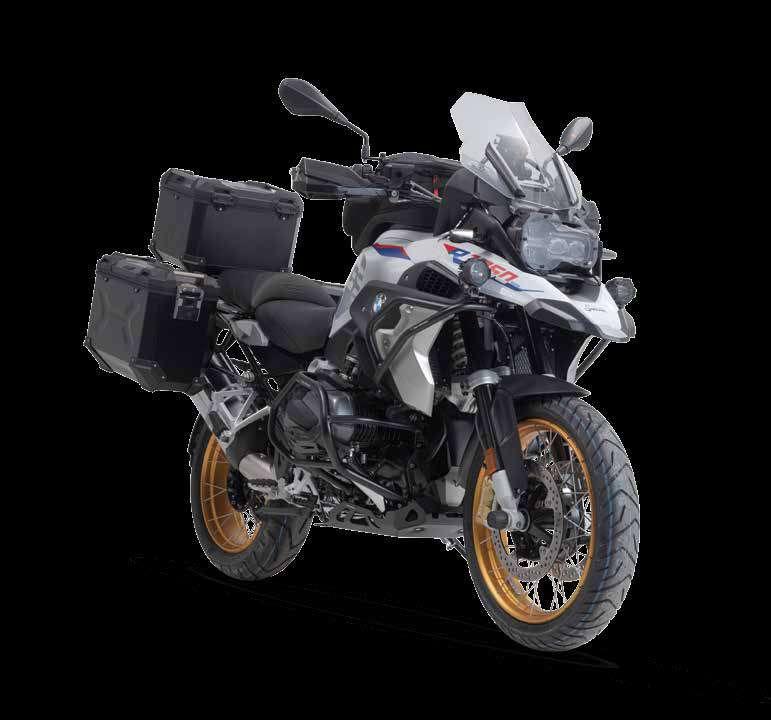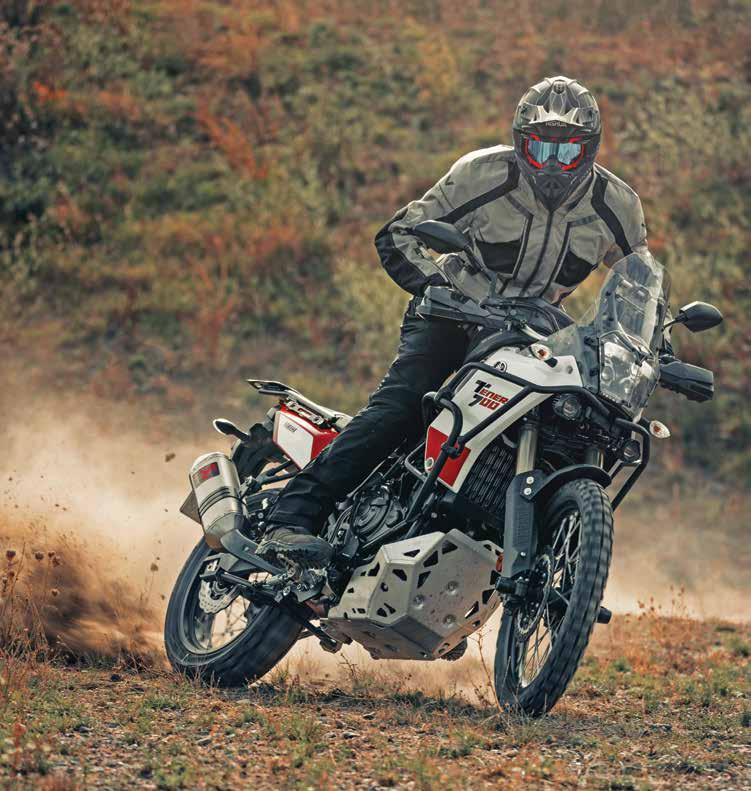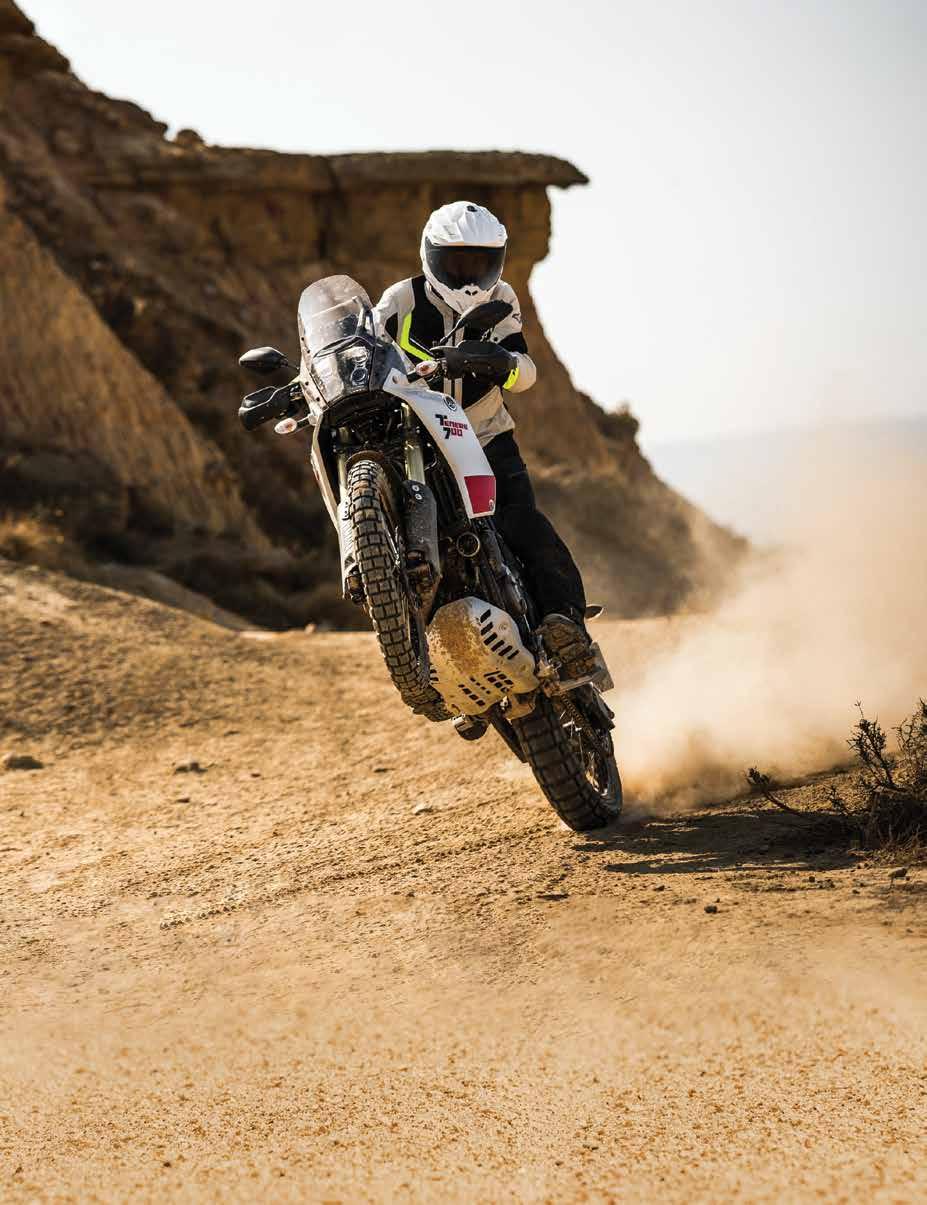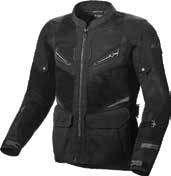

THE MOST EPIC ROADS ARE OFFROAD

It’s we what do
Tom Foster - Editor
Every editor wonders whether people are really reading their magazine.
These days success of a magazine is measured in a brutal assessment of profit or loss, and it’s a relatively simple judgement. The costs of producing the title are weighed against the income, and if it’s a profitable proposition, everything’s fine.
Adventure Rider Magazine is about to quietly celebrate its eighth year, so I guess the profit-and-loss figures stack up the right way.
But there’s always the nagging possibility the people buying the magazine aren’t reading it. Maybe they’re
just flicking through and looking at the pictures, possibly reading a caption or two? Maybe the stories and experiences shared aren’t presented well enough to get the attention they deserve?
It’s a possibility which haunts the sleepless nights of most editors who care for their work.
But then, sometimes, there’ll be an unusual circumstance that gives an insight into not only how closely the magazine is read, but how passionate readers are about the content. And it’s funny how often a cock up, rather than something done well, can give a very good indication of how people are viewing the mag.
In issue #45 I was careless and allowed the publication of a poorly researched piece. Worse, I wrote the piece myself.

I spend a substantial amount of time helping other writers tune up their stories, and a lot of that is checking the spelling of place names, maths and facts. But when it came to one of my own pieces, I was careless and I’m ashamed. The silver lining on that cloud is I can have no doubt a very high percentage of buyers are not just reading Adventure Rider Magazine, but have strong feelings about the way things are presented.
I won’t attempt any excuses. My apologies to everyone for my sloppy work, and in future I’ll attempt to meet the standard the magazine and readers clearly deserve.
“ It’s a possibility which haunts the sleepless nights of most editors who care for their work. ”
To all of you who e-mailed I give my thanks, and, just to set the record straight: Gaston Rahier was Belgian, not French. To all of you – and there were quite a few – who insisted Suzuki had never competed in a Paris-Dakar, or that Rahier had never been involved with Suzuki’s Paris-Dakar effort, I hope you’re feeling a little better informed now.

I do thank you all for your mostly good-humoured approach in pointing out what you thought was my editorial bungling. That kind of friendly attitude runs strong through the adventure-riding world, and it’s a very pleasant change from the attitudes of motocross and roadrace fans I’ve dealt with in the past. If you don’t know what I’m talking about
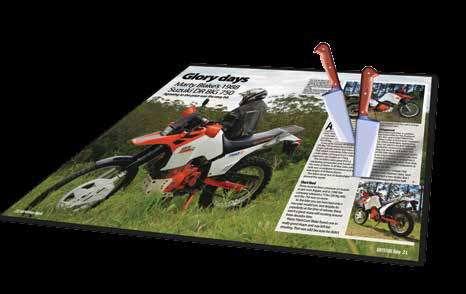


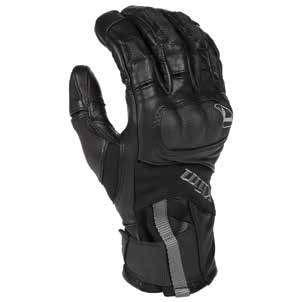



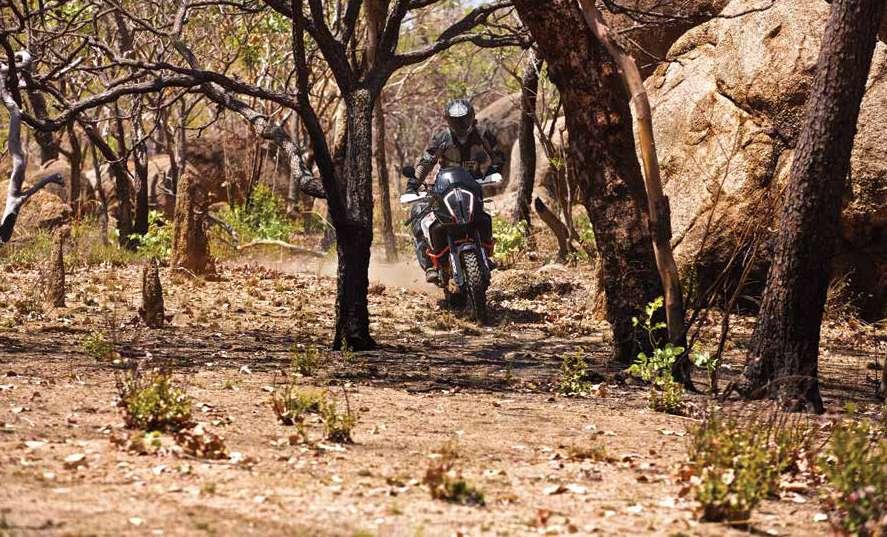

WATERPROOF
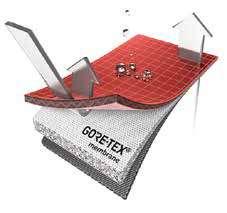

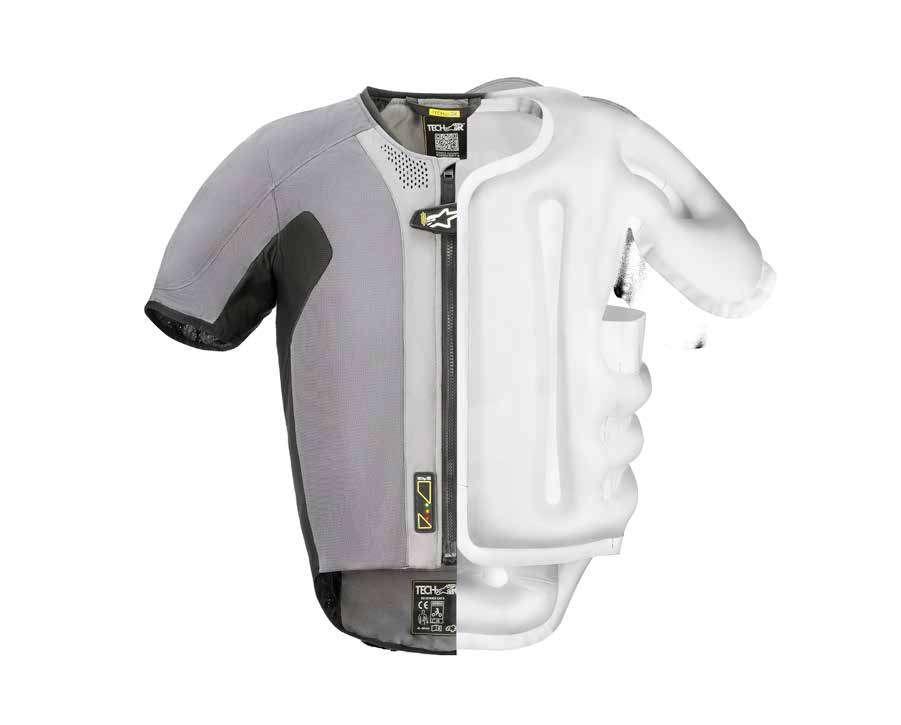
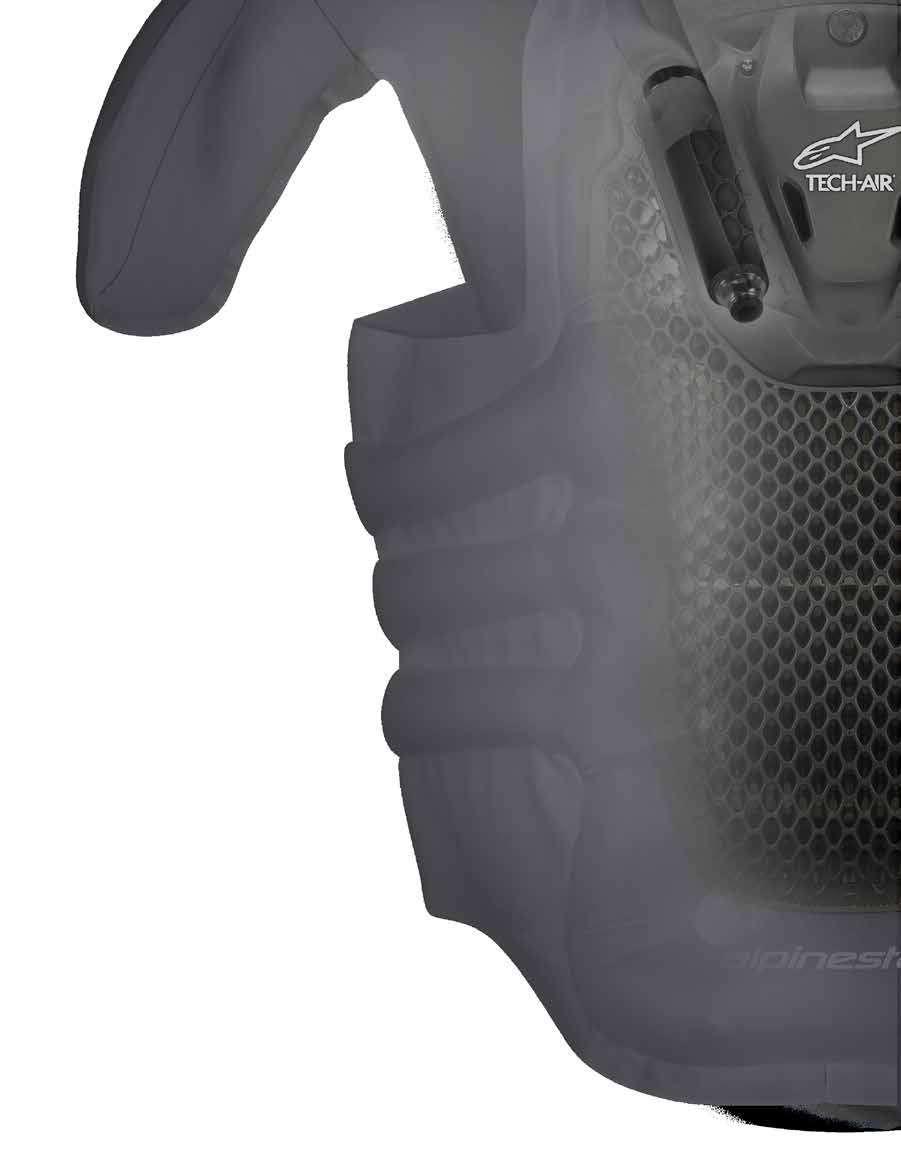


mitch@maynemedia.com.au
Phone: (02) 9452 4517
Mobile: 0402 202 870
Production
Arianna Lucini
arianna@maynemedia.com.au
Design Danny Bourke art@maynemedia.com.au
Subscriptions (02) 8355 6841/(02) 9452 4517 arlette@maynemedia.com.au

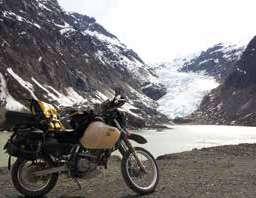
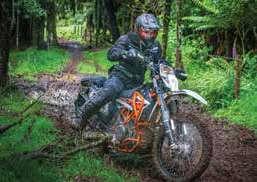



8 advridermag.com.au

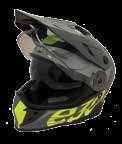





A DR in BC
Sean Smith had one of those days adventure riders live for on a Suzuki in British Columbia.
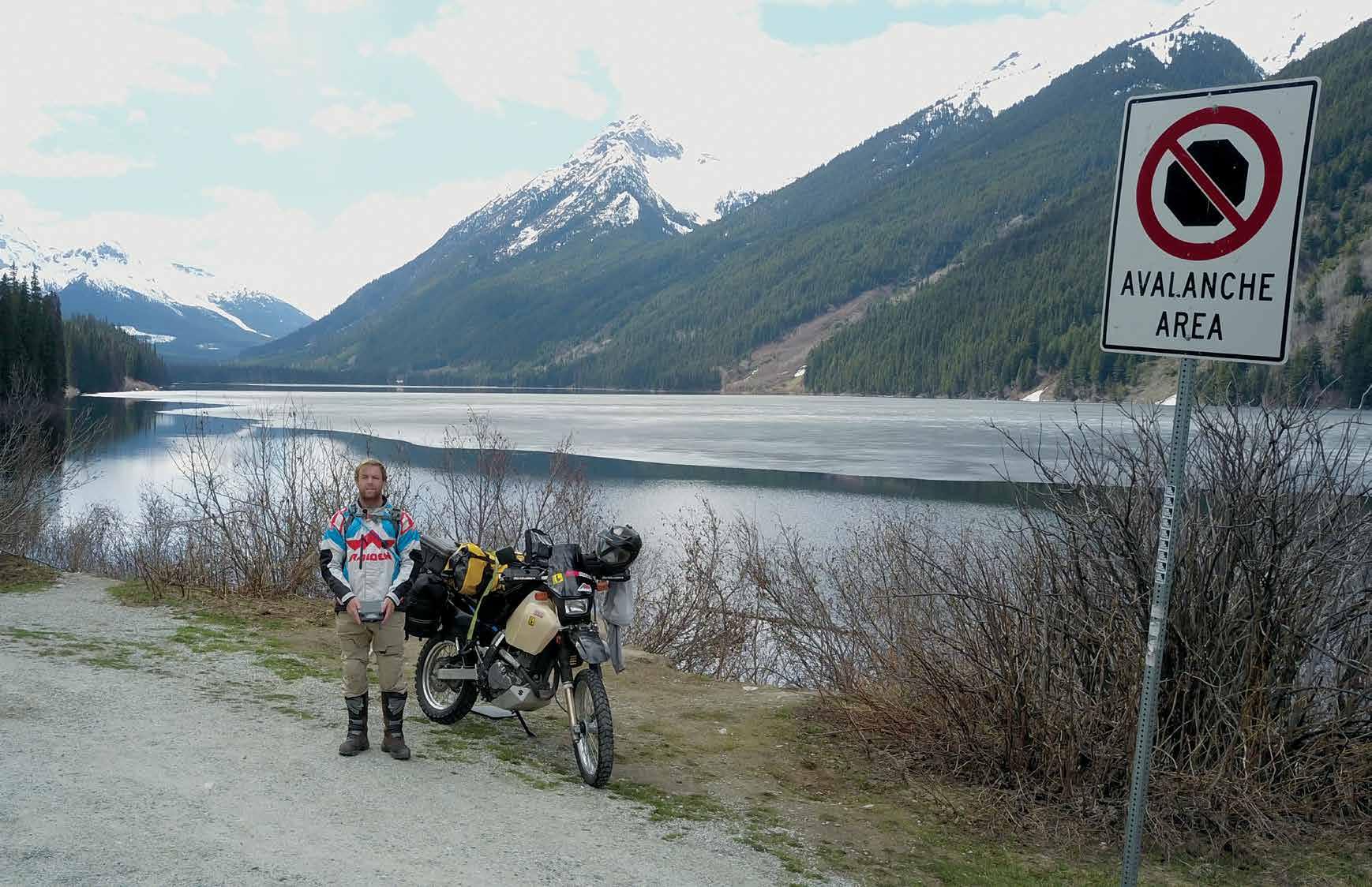
At 3.00pm in British Colombia the sun was ridiculously high and I was at that point where the kilometres were really taking their toll. The dull ache in my arse couldn’t be ignored and found myself shifting constantly, trying to find a single muscle the DR650’s wooden plank of a seat hadn’t vibrated into submission. A bullet-pocked sign announced my approach to Meziadin Junction.
Meziadin Junction!
My imagination ran wild with thoughts of hot springs and draft beer served in a saloon bar.
The grandiose dreams disappeared as I pulled into a dusty no-horse town – a lonely truck-stop who’s only purpose was to mark an intersection on the Stewart-Cassiar Highway.
Choose
I sat and sipped lukewarm drip coffee and stared at the bike. Fortunately, I’d gotten my mitts on a surprisingly good homemade cookie. It was one of those rare ones which was crunchy on the outer rim but gooey and soft in the center, and as I munched on that little delight my mind rolled through the inevitable questions that mark the end of every day spent on a long ride: “How much further do I want to ride today?”
u
Main: Alone in the Canadian wilderness.
Right: Unpacking the Suzuki.
Below: Chancing the unknown and embracing the spirit of adventure and fun that adventure riding represented. Bear Glacier in British Columbia.

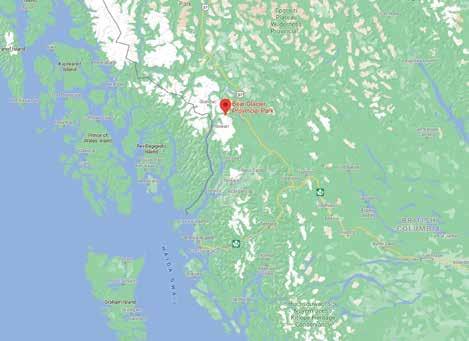
Words and images: Sean Smith
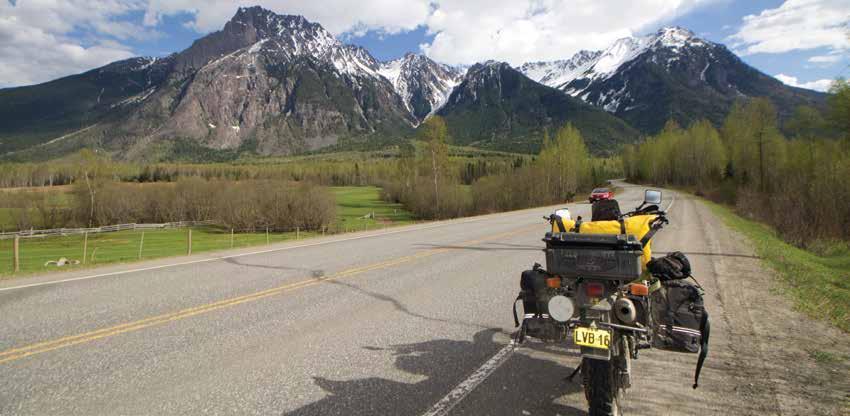
“Do I want to spend another night camping alone in freezing northern British Colombia?”
“Can I afford a hotel?”
“What’s the likelihood I’ll be plucked out of my tent tonight and eviscerated by a family of hungry bears?”
“Should I give mum a call (I was pretty sure her birthday was soon)?”
consulted the map and saw two options: turn right and continue north towards my destination (Alaska); or swing left for a one-way detour to the town of Stewart.
Stewart had been mentioned by a random German couple in an RV, but was otherwise a complete unknown. I did know for certain that only 80km away to the north was a riverside campsite located conveniently close to a bar. So the question was, should I forge on towards my destination and get to the pub a little quicker and maybe squeeze one or two extra beers out of happy hour? Or should I take the advice of some total strangers and chance the unknown, embracing the spirit of uncertainty and fun adventure riding represented?
Bear arse
I turned left and was rewarded almost instantly. An adult black bear was rolling around in the vegetation beside the road.
Above: Smooth, fresh-laid blacktop swept through a picture-perfect landscape.
Right: An almost fully-grown adult with broad, powerful shoulders that tapered to a narrow, intelligent face.
“The
little voice in the back of my head began to scream, ‘What in the name of sweet f*#k are you doing!”
I’d seen a few bears, but they’d all been fleeting glimpses of the skittish animals running away at the sound of my approaching FMF pipe. This time I quickly shifted into neutral, keyed the bike off, glided quietly and slowly towards the bear and came to a stop about 20 metres away. The next, and most important, step of a bear encounter is getting the camera out. I executed a series of panicked manoeuvres, opened my tank bag, fumbled for the camera and kept the
bike vertical on the steep verge, all while keeping my eyes affixed on the bear.
Yogi turned to look at me and reared up on its hind legs. At 1.5 metres tall he was almost a fully-grown adult with broad, powerful shoulders that tapered to a narrow, intelligent face. His fur was long, dark and incredibly soft looking. The thing was so darn cute I would’ve been over there for a hug if I could’ve been sure he wouldn’t tear me apart.
We locked eyes. A strange moment passed between us and he began ambling slowly and carefully towards me. He crossed the road and rounded the bike, stopping only a couple of metres off my front tyre.
At this point the little voice in the back of my head began to scream, ‘What in the name of sweet f*#k are you doing!’
In that split-second I’d completely lost my nerve and jumped into action,

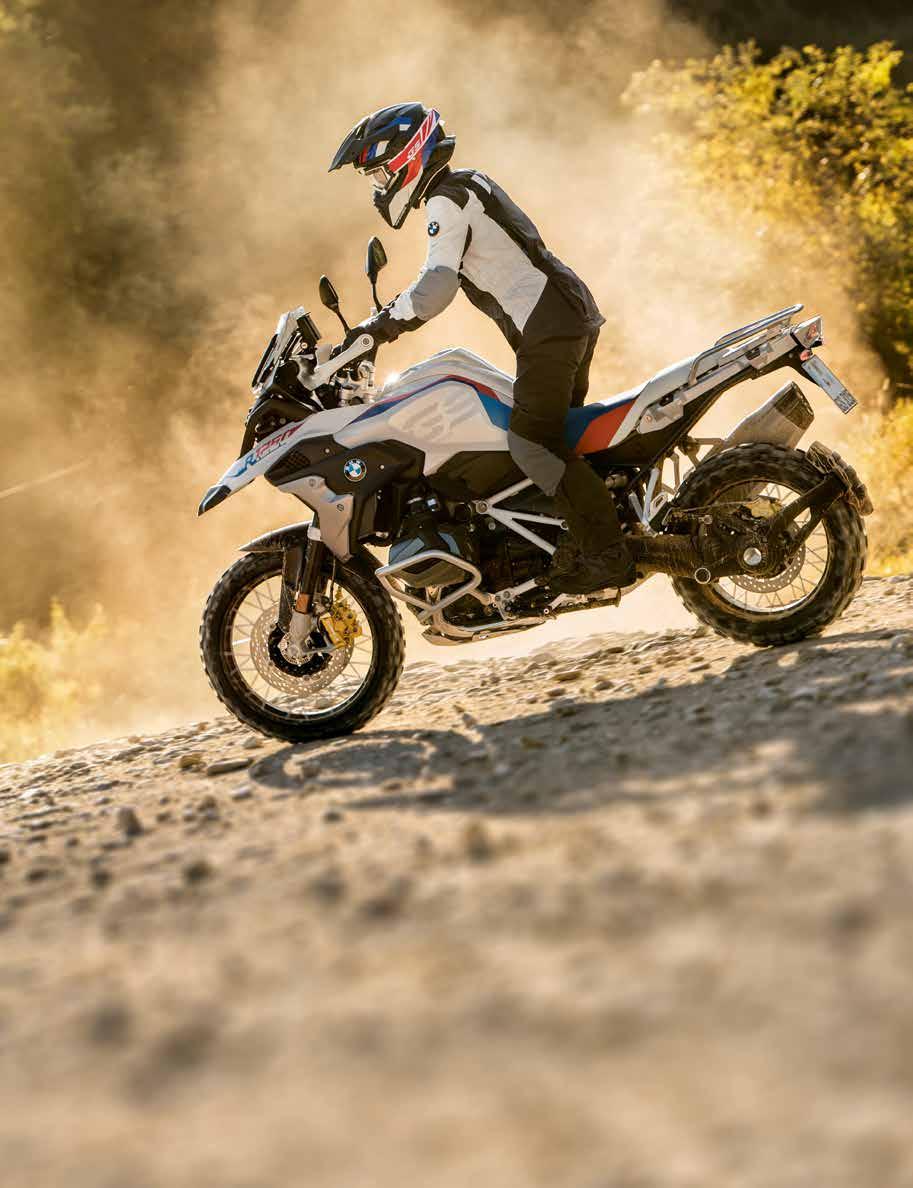
40 YEARS OF ADVENTURE
FOUR DECADES OF GS
for any challenge: Since 1980, the GS has stood for limitless adventure and curiosity, both on and off the road. We are celebrating the anniversary with six special editions – the new F 750 GS, F 850 GS, F 850 GS Adventure, in addition to the G 310 GS, R 1250 GS, and R 1250 GS Adventure. The 40 Years GS editions are each homage to the #SpiritofGS They boast state-of-the-art technology, but their design is inspired by the legendary R 100 GS and reminds us of the origins of the GS.
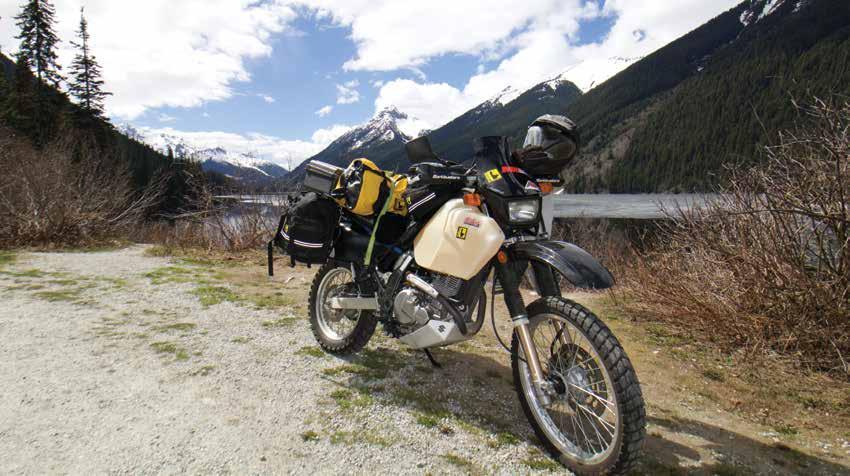
breaking the strange stillness between us. I keyed the bike, offering fervent prayers to the spark-plug gods. The bear was easily in swiping range and if I’d flooded the bike it could potentially have been game over.
The trusty DR650 kicked into life and, selecting first, I roared off.
The poor bear was startled out of its wits and scrambled into the roadside scrub. As I rode past I was shaken by a wild, uncontrollable fit of laughter. The absurdity of the situation hit home. I was alone. I was in the middle of the Canadian wilderness. I’d just sat there and let an apex predator get to within high-fiving distance of my soft human body.
Cure all
From there the road became remarkable. My tyres hummed on smooth, fresh-laid blacktop that swept through a pictureperfect landscape. Huge scratches scored the cliffs above me, lines that marked the glacial retreat of eons ago. A narrow ribbon of water ran off to my left, paralleling a series of mesmerising, sweeping corners that repeated themselves and lulled me into the trance-like focus all riders would recognise. The cliffs on each side became steeper and steeper as the valley tightened. So too did the corners. I took to the task, double-shifting down into the tightest of bends, ’pegs hovering just off the pavement, before

straightening up, twisting the wrist and tearing away, shifting up through second and third to just kiss the bottom of fourth gear. What a rush!
A smile lit my face and the aches and pains of the afternoon disappeared.
Cool reception
I looked up from the twisties to drink in the mindboggling view.
Cascading waterfalls lined both sides of the road and the snowmelt provided huge volumes of water. Even in spring the snowline was only 100m above me.
A white dust covered the scene, one that was completely foreign to this Aussie rider. Thin trails of ice ran from the mountaintop, past the snowline, and came to rest adjacent to the road. This ice existed year-round, cold fingers extending down from the permanent glaciers that inhabited the heights. Wind blew across the ice and snow and straight though my jacket to cancel out any remaining coffee warmth. I shivered and tried my hardest to ignore the constant cold that comes part-and-parcel with touring in the northern latitudes early in the year. Over a slight rise the valley opened

up and offered just a glimpse of white in the distance. The white speck grew rapidly, and two minutes later I was staring in amazement at a glowing, blue-green lake partly covered with slabs of ice. Hanging above and feeding into the lake was Bear Glacier, a large, jagged and blindingly white river of ice flowing down from the mountaintop. The glacier itself was surrounded by avalanche slides and huge chunks of destroyed rock, testament to the awesome power of this ice monolith. Etch marks running down the valley walls showed the path of the glacier’s retreat, a process only begun in the 1940s. Previously Bear Glacier had filled the entire valley. The road I was on would’ve been tens of metres under the ice, and that was shown by the remnants of the old Stewart access road in the hills high above.
Cross purpose
Eager to stretch my legs and snap a few pics, I wandered down to the water’s
Above: Constant cold comes part-and-parcel with touring in the northern latitudes early in the year. Below: Goldilocks not shown.
edge. The lake drained westwards through a wide, fast-running river, and the speed of the water indicated the river was fairly shallow.
From that initial observation a thought formed.
Why couldn’t I, Sean Smith, adventure rider, ford this icy river and chill a beer on the ice of Bear Glacier itself?
After the genesis of this idea I had to run through an interesting mental exercise.
Usually you have a riding partner to debate the pros and cons of such an idiotic endeavor, iron out the kinks in the eventual plan and generally egg each other on. By yourself it’s a totally different matter. No one even knew I was there and no one would ever know if I didn’t decide to share the experience with them. No one would know whether I’d chickened out or was brave or stupid enough to take the plunge.
It’s a strange experience finally being by yourself after being in a society that placed so much value on ‘sharing’
experiences through social media. When you’re alone that voice in the back of your head (which, in my case, sounded strangely like my father) spoke with a lot more volume. Standing there on the edge of the lake I decided to silence Dad and take the plunge.
Psyching myself up, I quickly threw my camera, food, water, beer, tracker and, of course, the antibear spray (called ‘Bear Glacier’) into a bag. As I packed I talked out loud to myself and the one-man discussion alternated between potential disasters and how good it was going to feel sucking back that ice-cold, glacier-chilled beer.
Ignoring the saner points my old man’s voice was raising in my head, I shouldered my bag and charged into the river.
Banker
The first few steps weren’t too bad. My toes were dry and with firm ground underfoot I strode confidently away from the bank. After a couple of steps the
Right: Over a slight rise the valley opened up and offered a glimpse of white in the distance. u
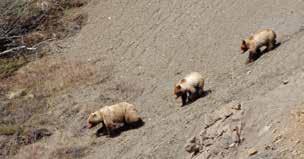
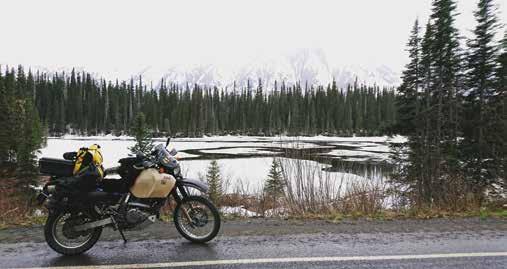

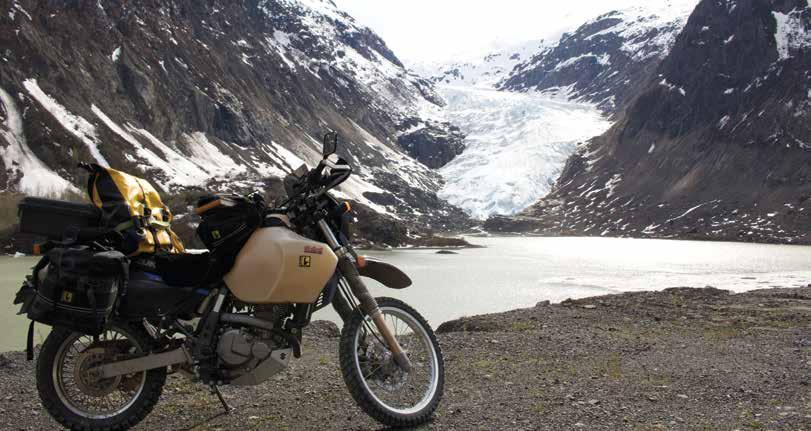
water tipped over the edge and filled my Forma boots. I sloshed into the middle of the river and my pace slowed as the shivering and doubt began. The current was strong enough to pull at my legs with each step and keep me constantly unstable. The rocks became larger and more slippery and the water was freezing cold, thigh-high and filled with small pieces of glacier that bumped into me as they floated downstream.
It got deeper. And deeper again. I was only 15m away from the bank and my hips were completely submerged. My mind was filled with doubt.
I paused and looked at the far bank and my warm, dry bike. If this water
were to get any deeper I could’ve found myself in quite serious trouble. If slipped and dunked myself a new and close friendship with hypothermia would develop very quickly.
I’d gone too far to turn back.
Forcing my boots over the slippery stones and through the rushing water I finally made it to dry land. A primal roar burst forth unbidden from my mouth and I capered around on the shore doing a cold, soggy happy dance.
Worth the climb
I pulled off my boots, tipped out a few litres of water and started trekking towards the glacier face.

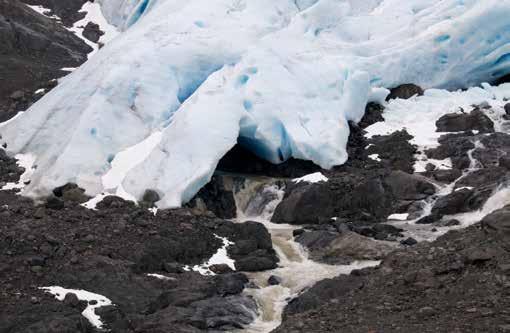

no manmade trail I was forced to blaze my own, pushing through small shrubs, around pine trees and struggling through sections of deep snow. The path of least resistance ended up being along the lake shore and, scrambling over the moss-covered lakeside boulders, the lake disappeared behind me and I began to climb. Plant life thinned before disappearing completely and I was left walking along a series of precarious rock slides. Each step dislodged small stones that tumbled down the hill. From that point all the way to the
Above:
Below:
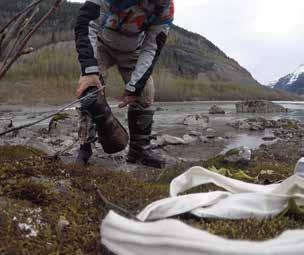
glacier was nothing but exposed rock. Boulders bigger than houses lay in their final resting place and I picked my way between them, imagining the noise and power generated by their fall. It was at this time my ol’ man piped up in the back of my mind, ‘Mate. Are you walking alone through the rubble of recent avalanches? Do you have a single shred of common sense?’
Nervously I scanned the cliffs looking for any signs of movement. There had been no rain for a few days and I felt reasonably confident.
After climbing over a large rise I looked down on a perfect, uninterrupted view. The glacier loomed large in front of me, close enough to pick out tiny details. Ice looked like flowing water paused in time. Shades of blue and white emanated from the crevasses and caught the afternoon light. The retreating glacier was riddled with huge, intricate cave systems that must shift and change throughout the seasons. The streams of melt combined into a torrent of water that rushed from the glacier’s base.
It was a great spot for a muesli bar and a selfie. I sat at the top, not bothered at all by the gentle rain, and felt really chuffed with myself and how the day had panned out. Sometimes life is just that good.
Made it
Three bites into my choc-chip bar the silence was broken by a loud cracking sound.
From above me, up the valley toward the glacier, came a series of creaks, moans and groans which were all too loud for comfort. Dad contributed to the cacophony with a sardonic, ‘I told you so’. began to pack my things, eyes glued to the hillside. The rain was falling harder,
plastering my hair to my head and running into my eyes. The final straw to break my fragile nerve was the sight of a small boulder tumbling down the hill, gathering speed and shattering itself in a cataclysmic collision with a larger boulder.
shoulder towards the potential avalanche site, I slipped on the exposed rock and hit the deck. Padded pants and jacket saved injury to anything except ego and before long I saw the end of the rock slides and the beginning of the vegetation. Vegetation and roots meant stability, and stability meant safety.
“Mate. Are you walking alone through the rubble of recent avalanches? Do you have a single shred of common sense?”
Tell the tale
Panic won the day and I bolted.
I slipped and slid down the wet rock face, damp boots offering no traction, my heartrate through the roof and arms full of camera gear. Struggling with the slick granite, puffing and panting, every step carried me further down the rise towards safety. ‘Less rush and more haste’ became my mantra as I tried get my mind back under control. Hazarding a look over my
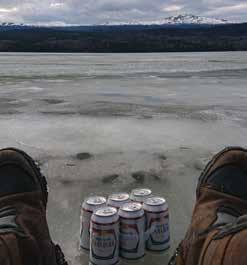
I began getting my mind back under control and burst out laughing again at the absurdity of the situation. I’d dodged a bear, ignored the voice of reason to cross an icy river in British Colombia and trudged across an active landslide zone before being turned back at the base of a glacier by a near avalanche. I’d done it all completely alone and equipped with little means of contacting the outside world.
I laughed my way across the river and back onto the bike.
After whipping through a few miles of corners into Stewart I pulled up a stool at the bar for a celebratory beer and to say hello to the local denizens. Next to me was Tony, a logger from Newfoundland, wearing a red-nosed skull bandanna and an AC/DC shirt. He turned to me with the classic Canadian, “Hey, bud. What you been up too?”
I grabbed a cold glass of Molson and replied, “Well, mate, I was sitting back there deciding whether to turn left or right…”
Above:
Left: Why not ford the icy river and chill a beer on the ice of Bear
With
Feeding into the lake was Bear Glacier –a large, jagged and blindingly white river of ice flowing down from the mountain-top.
Left: The speed of the water indicated the river was fairly shallow.
Water tipped over the edge and filled the Forma boots.
Above left: All the way to the glacier was nothing but exposed rock.
Author Sean Smith dealing with the exposed rock of Bear Glacier.
Glacier itself?
sir Pezz!
After 10 years the Scrapheap Adventure Ride has a big following and has raised around $800,000 for Down Syndrome NSW and Australia. Its founder, the irrepressible Perry ‘Pezz’ Gilsenan, has been gonged. Never was an Order Of Australia awarded to a more deserving, happy and adventurous character. Adventure Rider Magazine had a chat with the man himself.
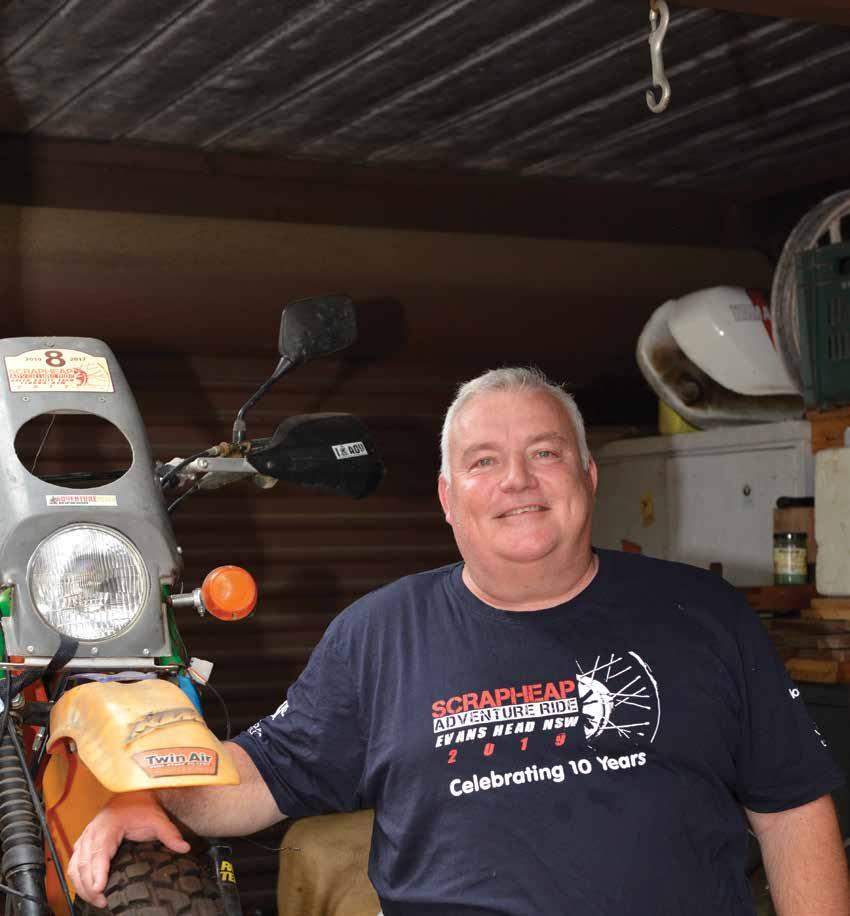
Originally started on the web forum advrider. com, the Scrapheap Adventure Ride was put together by a few mates. Perry’s daughter, Grace, who was six at the time, has Down Syndrome and Perry thought it could be possibly be an opportunity to raise awareness of the condition. Down Syndrome NSW, very supportive during the early years with information and advice, was keen to be associated, so the idea became reality.
That first year 14 bikes, each purchased for less than $1000, headed to Wanaaring in NSW to see what would happen.
“We raised $22,000,” remembered Perry. “It was huge. We were just blown away.”
Same again?
The idea behind the ride was to have fun and no one was forced to raise funds. As Perry explained:
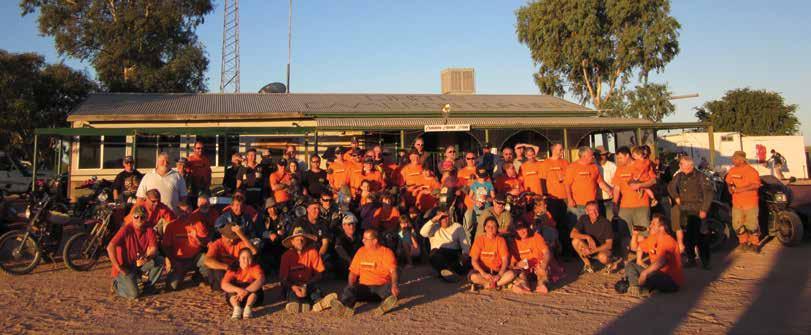
Left: Perry Gilsenan. Founder of the Scrapheap Adventure Ride, mad-keen tinkerer and now, Order Of Australia recipient.
Above: “I just remember coming around the corner and seeing all the orange Scrapheap Rally T-shirts and going, ‘Wow! This is huge’.”
Below: Buying a bike for under $1000 means making a few compromises. Riding it takes some commitment and innovation. This gem made it to Cameron Corner in 2011.
Below right: Support vehicles are for sooks. There’s a crew from Inverell who are very committed to the Scrapheap. Their bikes are often some of the most spectacular – as are their fundraising efforts.
“We didn’t want it to be hard work, and we’re really focussed on awareness. We found once we raise awareness, the community is generous.”
The first Scrapheap had riders from NSW, South Australia, Victoria and Queensland, and as the first ride wound up everyone was straight away asking for the following year’s destination.
Pezz chose Cameron Corner and 50 riders and support vehicles signed on.
It was the first year Steve Smith from Adventure Moto attended, and he’s remained a huge supporter ever since.
It was a big occasion.
“I just remember coming around the corner and seeing all the orange Scrapheap Rally T-shirts and going, ‘Wow! This is huge’,” said Pezz. “I started tearing up.”
That year the tally was $70,000 and the Scrapheap Adventure Ride was well and truly established.
“What we’ve found is, once people come along, they keep wanting to come along each year,” explained the Sydneysider.
It’s not only the riders who love the Scrapheap. Family attendance is big, and the support from within the Down Syndrome community is enormous.
To show up to a Scrapheap is to be embraced by a sizable and happy crowd determined to have a good time.
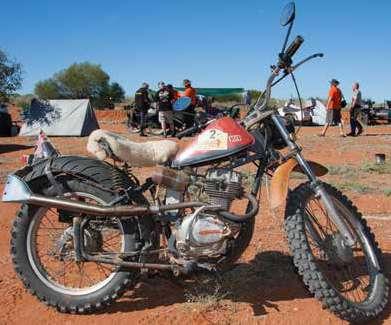
Side benefit
The essence of the Scrapheap may be in the incredible goodwill it generates, but for individual participants there’s plenty to look forward to. The ride is a tinkerer’s Nirvana.
The idea is to buy a bike for $1000 or less and find sponsors to support riding that bike to the nominated destination. That means everything from 50cc scooters to wild, hand-made sidecars and road bikes in very marginal condition head to places like Pooncarie, Kosciuszko, Cameron Corner and, in October 2021, Gulargambone. Often the bikes are accompanied by large toolkits and most riders get to spend a considerable amount of time either building or maintaining their chosen mount. There’s no more passionate tinkerer than Pezz himself. His collection includes his current project, an RV125 being prepared to receive a DR200 motor, a Suzuki GT200 X5, an XL250S awaiting either and XL500 or FT500 motor
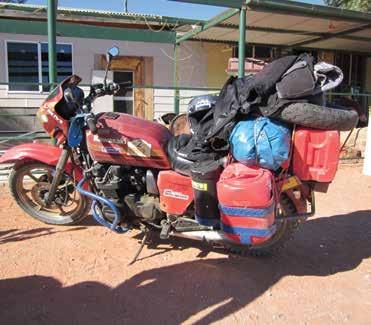
SIR
Pezz
(depending what Pezz can find), a 1980 GS Beemer and four more BMWs in the garage. Pezz’ daughter Grace, now 17, is keen for a sidecar, so that’s on Pezz’ list as well.
“We’re always about getting an old dunger and fixing it up and encouraging one another,” smiled Pezz. “Some guys go a long way into modifying and resurrecting wrecks, and others just get an old trailbike and fix it up and come along.” Nothing’s compulsory on a Scrapheap. Building an old bike isn’t required. Any rider on any bike is welcome.
Coming up
What’s the future for the Scrapheap?
Originally the event was run in conjunction with Down Syndrome NSW. Perry felt it might not seem correct to run an interstate event under the banner of a NSW group, so the Scrapheap is now endorsed by parent organisation Down Syndrome Australia. Perry is hoping there may be either Scrapheaps in different
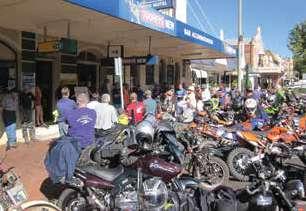
The Scrapheap Rally
The Scrapheap Adventure Ride is a unique fundraising event which involves motorcycle enthusiasts from all over the country purchasing a bike for no more than $1000 and doing it up for an adventure ride through the Aussie outback, all while raising money in support of Down Syndrome Australia.
v Riders begin their journey at home or wherever they like, but arrive at the same destination
v In 2021 the destination is Gulargambone, NSW, from October 1 to October 3
v If you’re not a rider, you can support the Scrapheap Adventure Ride and Down Syndrome Australia by sponsoring a rider or just donating
states, or perhaps interstate destinations for the one big annual event. Time will tell.
One thing that won’t change is every cent donated ending up with Down Syndrome Australia. There’s no ‘administration fees’ or organisers deducting funds to cover expenses.
Also, the event is still growing. The idea was to head for small communities at great destinations, but finding small communities with the infrastructure to cope with the influx of several hundred people can be challenging.
That’s another factor to be considered and managed when planning future Scrapheaps.
Order!
How was it being recognised in such a high-profile and official way?
“It’s amazing,” said Pezz, serious for once. “It’s humbling.”
“For me it’s not what do, it’s what we do together. There’s a whole group of people who raise funds and really get on board and champion what we’re about. I feel like the award’s for them. Without them we wouldn’t have an event. Thank you.”
Will Pezz use his new recognition to now move into politics and maybe run for lord mayor?
The idea brings on one of Pezz’ wellknown giggles.
“The award benefits our mission and our community,” he said, “and it’s raised awareness of what we’re doing and that may make it easier for sponsorship.
v All bikes are welcome, but the idea is to start with a bike costing less than $1000 and spend any additional sums on the bike to make it roadworthy

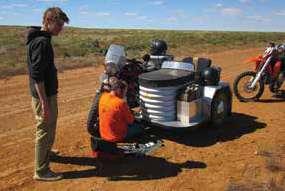
Bottom left: Even a recce ride gets plenty of starters. This one was for Inverell in 2013. Above: A sidecar made from a rainwater tank? Sure. Why not?
Below: Pezz’ first Scrapper. We’re still not exactly sure what bits were put together to make it, but it was a weapon.
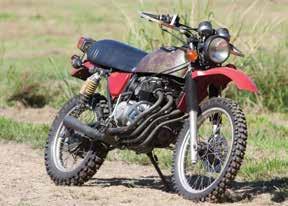
But I’m happy playing in my shed. I just want to build silly motorcycles and enjoy the ride.”
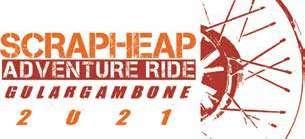
v All machines participating must be registered or have a valid Unregistered Vehicle Permit (UVP)
v Make a (suggested) $100 taxdeductible donation to register
v Set up your Scrapheap Adventure Ride challenge webpage (it only takes a minute). Add photos and blog entries so friends can check out the machine and sponsor the ride
v If you can’t find a suitable Scrapper, everyday bikes are welcome and can still participate
v Support vehicles for the Scrapheap riders are also welcome and carry fuel, water, food and any Scrappers that don’t make the distance. Find out more at: scrapheapadventureride.com.au.
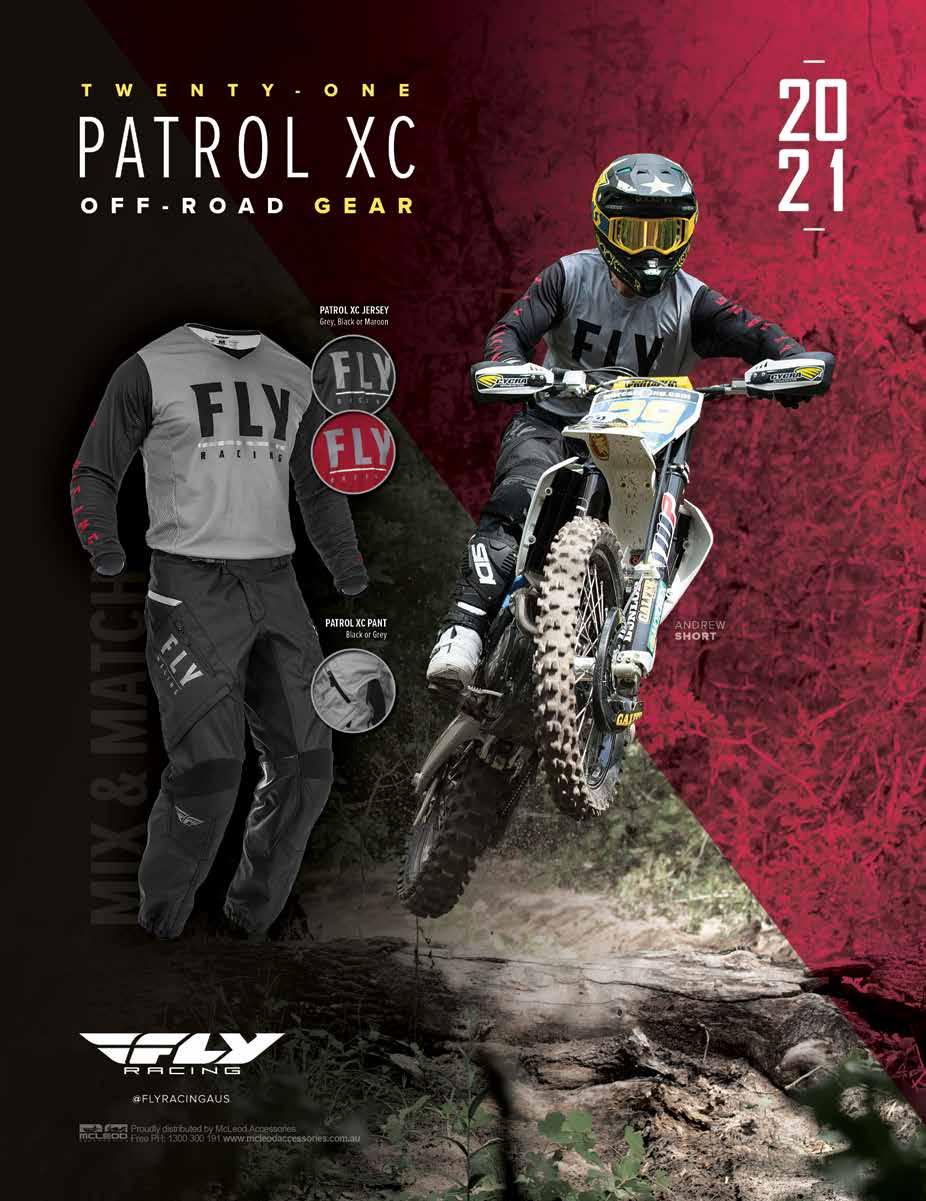
Coolah
weekend
Hopper had a chance to spend a dirty weekend with his ex. His ex-1090 that is, now owned by a mate.
Achance chat with ‘Angus the Gentleman’ –who’d bought my never-been-off-road 1090R –revealed he was doing a weekend ride to Coolah with a couple of mates. He threw out a casual invitation and I soon had my accommodation booked. I then tackled the far more challenging task of a short-notice gate pass.
A matching Yves Saint Laurent shoe-and-handbag combo did the trick.
Soft landing
I arrived at the popular Freemans Waterhole servo at 7.15am and was fuelled and ready for a 7.30am start. The group included Kevin on an Africa Twin, Greg with a 790R which looked a lot cleaner than mine, and trip

organiser and leader for the weekend, Lindsay, on his very tricked-up 800GS. With helmets on and tanks full we were ready to roll…except the GS had no power. Thankfully it didn’t take long to diagnose a loose earth lead on the battery as the culprit.

A short squirt on the blacktop had us at Mount Faulk Road and on the dirt into the Watagan National Park, a well-known playground for adventure riders and trailbikes. We roosted past Heaton Lookout, which is certainly worth a look and is a popular picnic spot, and joined Watagan Forest Road, a reasonably well-maintained dirt road with a few ruts in the corners to keep everyone engaged.


MOTOTREKK PANNIERS COYOTE SADDLEBAGS
Words: Hopper. Images: Hopper and Kevin Bonnettee
Above: Trip organiser and leader for the weekend, Lindsay, on his 800GS.
Below: A trailer was organised.
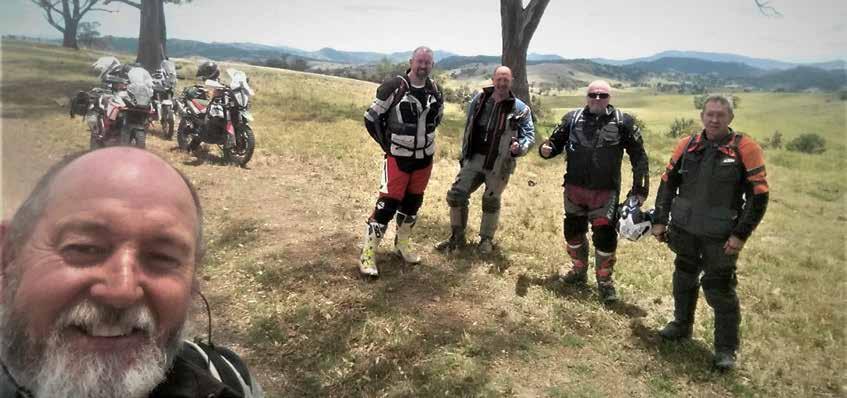
Watagan Creek Road was a lot more interesting on the big bikes and there were plenty of obstacles to keep the blood pumping. For a lot of years a bridge had been out preventing 4WDs from crossing, but the bridge has now been replaced (I believe by locals), and it’s certainly a lot better than the thin strip of trail that had been in use previously.
The track opened up through lush farmland before joining the Great North Road briefly before we headed into Yengo National Park on the Finchley Track. Someone had forgotten to turn off their ABS and it brought them undone on a loose right hander. Thankfully, the fall was only into sand and both rider and bike were okay.
We regrouped at Finchley Lookout, a viewing platform with several interpretation boards and offering superb 360-degree views across the remote wilderness with Mount Yengo standing tall in the distance.
“ Someone had forgotten to turn off their ABS and it brought them undone on a loose right hander.”
Onto Howes Trail we went. It was a little rougher and featured several sandy sections where we all had a few moments.
Full
of shirt
Out onto the iconic Putty Road we roared, but only briefly. We soon turned on to another adventure-bike favourite, Commission Road. It was a bit rougher than usual, but still a great run to Appletree Flat. Then we hit some backroads to Denman for fuel and lunch. At lunch we were joined by Angus. He’d had morning commitments he couldn’t get out of (a hair appointment, maybe?), and as we mounted up to leave Greg saw his rear brake was missing a calliper pin. I headed to the local hard-
Above: The motley crew. Below: Howes Trail was a little rough and featured several sandy sections. u
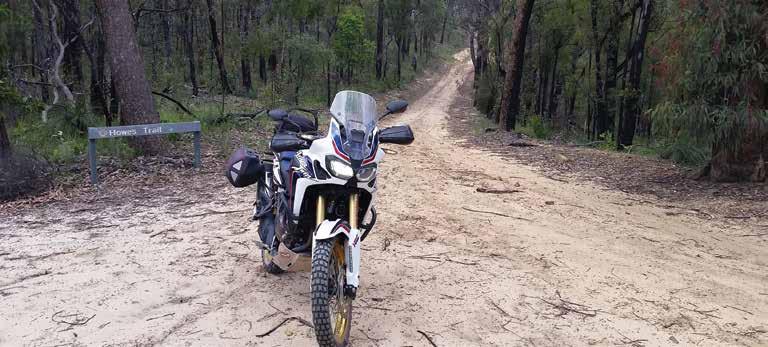


ware shop for a six-millimetre bolt which did the trick (patent pending).
We rolled out on to the well-known twisty sportsbike route, Bylong Valley
Above: Greg saw his rear brake was missing a calliper pin. A six-millimetre bolt did the trick (patent pending).
Below: Ready for a feed of ribs and chips after fuelling up and booking into Coolah pub.

Way, before heading towards Wallor and Goulburn River National Park, then the Golden Highway and backroads to our overnight at Coolah. After fuelling up and booking into the pub it was revealed I was the odd one out, not having an ‘Adventure before dementia’ T-shirt.
A feed of ribs and chips was good. There were plenty of verbal ribs as well, fuelled by the steady flow of alcohol.

Pump out
After the early-morning riders’ briefing which highlighted a dangerous causeway later in the day, we were on the road at 7.30am.
We hadn’t gone far when a different, short causeway brought our leader undone. His front wheel let go and he had a big off, but thankfully there were only minor marks on both rider and bike. While we sorted things, a debate raged on the correct way to cross a concrete causeway: clutch in or out? What gear? Weight back or forward?
If only the editor had been there to enlighten us with his wisdom.
Pandora Pass, a ridge across the Warrumbungle Range, offered great views of Liverpool Plains and a photo stop was essential.
Good backroads took us into Murrurundi for fuel and brunch, and that was followed by more great riding through Timor, Waverly and Grundy. We skirted Glenbawn Dam and rode on to Bowmans River Road, an awesome 30km or so of adventure paradise.
Fisted
After a stop at the top to appreciate the scenery, the group had just taken off when the mighty 1090 cut out. We did the normal things: fuses, loose wires and so forth, and all the signs pointed to the fuel pump. It seemed there was nothing we could do. Fortunately we had phone coverage and a trailer was organised. The others left while I stayed with Angus, who surfed the web and confirmed it was the fuel pump.
After 90 minutes Angus had a flashback to his troubled teenage years. He jumped up and bashed the side of the tank beside the fuel pump and, surprisingly, the bike started. It was apparently running normally, so a phone call cancelled the trailer and we rigged up and headed off.
End swell
We cruised on to Singleton, did some backroads to Maitland and then made it home. The 1090 didn’t falter again and I believe a new fuel filter has been ordered. Although there were some incidents we could’ve done without, it was a good two days of riding covering 850km with a great bunch of people. Hopefully they’ll invite me along on another of their adventures in the near future.











































HART Adventure Bike Technical skills
Thrills, spills and new skills
Training for adventure riding isn’t easy. There are some great people offering great coaching, but suitable venues are often a problem. The Honda Australia Roadcraft Training (HART) facility at St Ives in Sydney covers all the bases. Not only is the coaching first class, the venue is purpose-built.
f you go to the right,” explained trainer Karl Richards, standing thigh-deep in the stinking, 30-metre-long water crossing, “there’s this rock ledge. If you go to the left there’s a hole. Both of those will ruin your day.”
The assembled riders cast disbelieving looks at each other. “Where I’m standing there’s a gap between them about 30cm wide. That’s the spot you want to hit. Make sure you’re carrying enough momentum, because the soft bottom is going to grab your wheels and pull you up. All this bamboo hanging in from the sides will make vision difficult, too. So you’ll need some commitment.
“Right. Who’s keen for a go?” he grinned.
Crickets chirped and the sound of noisome gas bubbles popping through the surface of the deep, stagnant water were the only sounds to be heard.
“You guys think about it while I do a quick demo,” beamed Karl,

watched in awe as Karl hurled his Africa Twin into the drink, aimed at the spot, and with a muffled blubbing of a submerged pipe erupted in an explosion of water up the far bank.
After a moment of stunned silence there was a stampede to get mounted up and ‘give it a go’.

Top: “All this bamboo hanging in from the sides will make vision difficult, too.” Karl showed how to tackle the water crossing.
Above: Log crossings at HART are part of the installation, giving a clear approach and departure, and allowing close supervision from the coaches. Elvis Hyde made it look easy.
trudging back through the waterhole.
“Wouldn’t it be easier for him to just swim?” said someone from within the group.
Progress
The class, who just a few hours before had been clean, dry and full of enthusiasm,
The trainees may have been raw, but they were keen, and the HART facility and trainers combined to give a clearly optimistic group the confidence it needed to tackle obstacles which, just that morning, would’ve seemed impassable.
Working up
On an overcast day with the occasional patch of light drizzle, seven riders fronted up to a very busy training centre. While learner and provisional groups went through their road-licence paces in the designated bitumen areas, the adventure group kicked off in the classroom with introductions and a rundown on suitable apparel, safety gear and bike set up. From there it was out onto the ‘road’ – the bitumen circuit within the perimeter of
the training ground – to run through braking and body position. Standing up on the bike was a new concept to some of the riders, and everyone was shown the basics and given the chance to put those basics into practice under the watchful eyes of Karl and his fellow instructor Dave Trenear.
Confidence grew quickly, and by the time pulling skids to change direction came around a few of the group had cheerfully low-sided on the slippery wet clay. This was considered a great deal of fun, although there were a few less jokes thrown around when it became time to repeat the exercise with the front brake. With everyone feeling relatively comfortable about big bikes moving around, and the basics of controlling and adapting to that movement, the whole show moved to log crossings and, everyone’s favourite, sand.
Food for thought
The log crossings at HART are part of the installation, giving a clear approach and departure and allowing close supervision
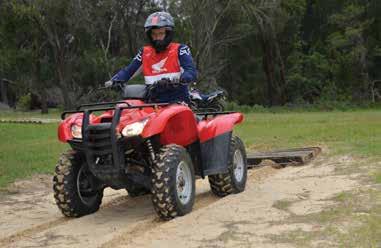
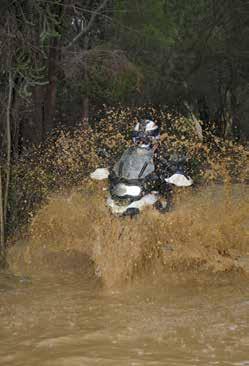
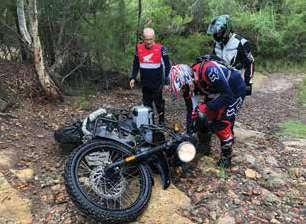
Above: Mike Franklin took a few goes to get comfortable with the Himalayan on the wet hill climb. He kept at it, though. Champion!
Below left: A quad dragged a raft of split logs across the sand section to help keep it manageable.
Below: Jim Prior only decked his Africa Twin to help out with the ‘lifting a big adventure bike’ part of the curriculum. Thanks, Jim! u

Top left: Pete Phillips got right into the rear-wheel lock up exercises.
Top: The level of enthusiasm for hitting the puddles was very high indeed. Dave Kefalas whooped it up on his new 1250GS.

from the coaches. After a pass or two and the odd bike spearing off in unexpected directions everyone pretty much had the hang of things. Advice was given and followed, thoughts shared on how Chris Birch may have tackled the obstacles, and a happy and comfortable group moved over to the manicured sand section.
With a quad dragging a raft of split logs to keep the sand section smooth things should’ve been very controlled. And so they were…mostly.
The reason time is spent on coaching in sand is because it can be bloody difficult, and it has to be admitted the odd bike went down. Jim Prior was first, although, to be fair, Jim insisted he only decked the Africa Twin to help out with the ‘lifting a big adventure bike’ part of the curriculum.
A few others had soft landings, and Mike Franklin’s Royal Enfield went rogue at one stage and, with a mind of its own, suddenly speared off in such a fashion as to cause unsightly marks in the underwear of Adventure Rider Magazine’s editor.
With the sand conquered and everyone feeling fairly pleased with themselves it was back to the classroom for lunch: pizza, fruit, coffee, cold drinks and what instructor Karl insisted were ‘energy bombs’. It turned out this was a bag of grapes, and despite the assertion they
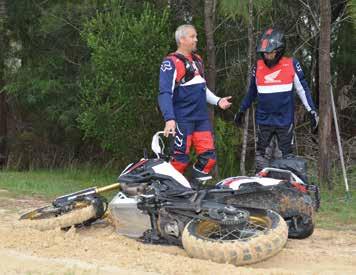
were ‘really chilled’ didn’t gain a high level of acceptance.
The real thing
After lunch it was time to put the morning’s learning into practice for reals.
Top left: The adventure group kicked off in the classroom with introductions and a rundown on suitable apparel, safety gear and bike set up.
Top right: Instructors Karl Richards (left) and Dave Trenear kept a close eye on everyone and offered plenty of great advice and awesome demos.
Below: Some drizzle kept the trails damp, and the dualsport tyres quickly packed up with sandy clay.
Bottom left & right: Phil Jamieson tackled the water crossing successfully, but didn’t go so well on the second run. He still looked like he was having a great time.
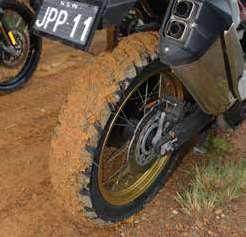
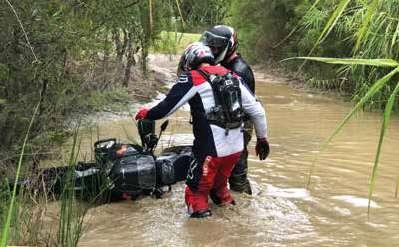
A wet, slippery, whooped-out loop was the venue for combining body position, braking and reading terrain, and the level of enthusiasm for hitting the puddles was very high indeed. It almost seemed as though there was more enthusiasm for a spectacular displacement of water than there was for applying the principles of safe and steady riding.
There was also a lot of yipping and yahooing going on.
But all that came to an end when, just off the loop, riders were introduced to the billabong which opened this story. The really funny thing about the water crossing was, the only other way out from that point was the hill climb.
Hilarious, eh?
The other funny thing was, once everyone adjusted to the idea, both the hillclimb and the water crossing copped a major pizzling. Bikes became stuck on the slippery hill and Phil Jamieson dunked his KLR in the crossing, but everyone kept fronting up for another go, even after a run where things hadn’t gone well.
That’s a very big demonstration of the real effectiveness of the training. That, and how much everyone seemed to enjoy themselves.
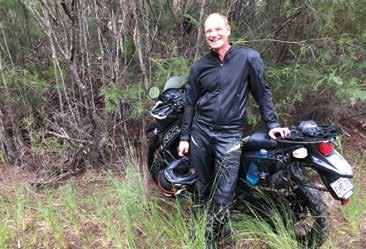
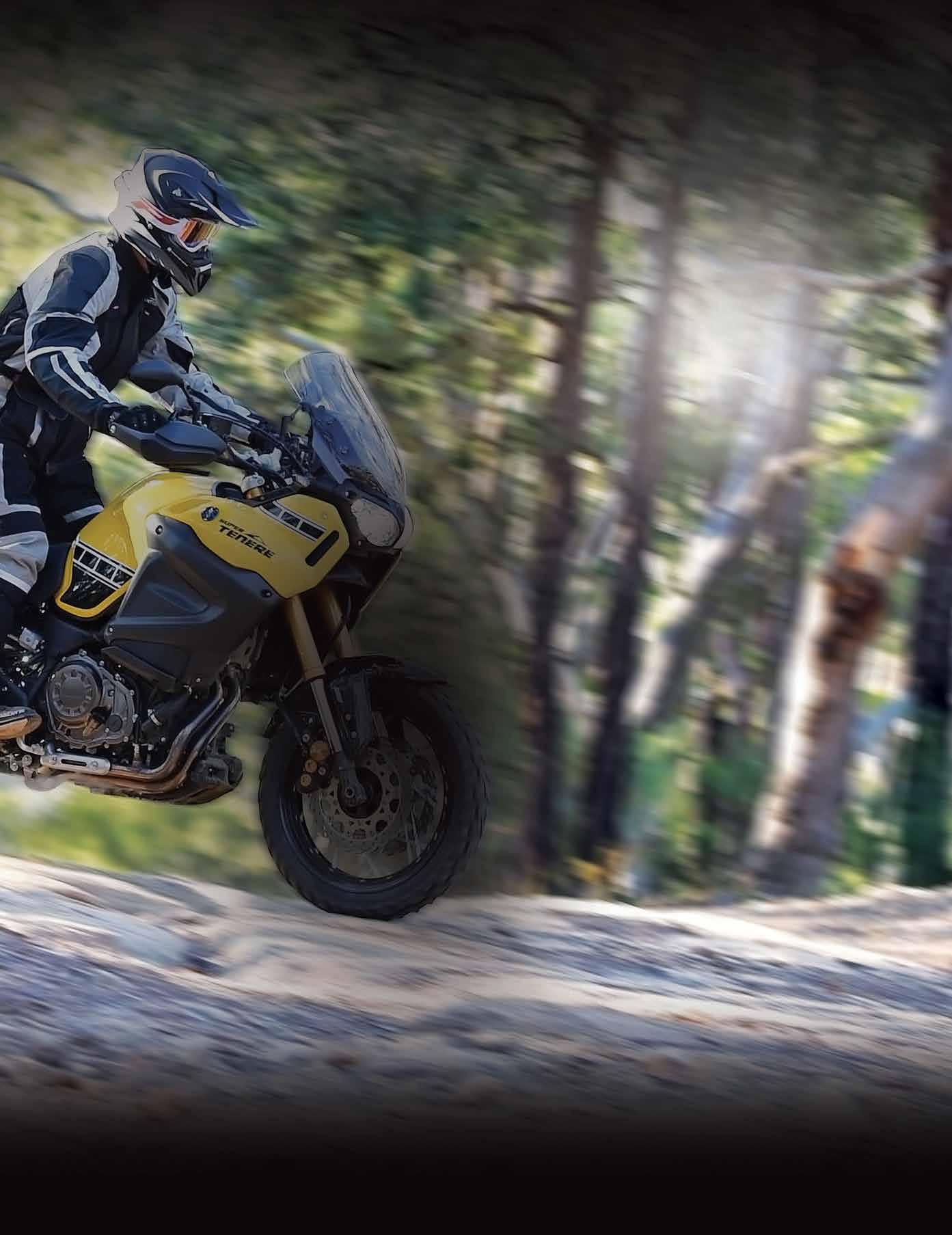


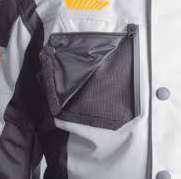
New Zealand Adventure Rallye: King Country KTM
2020 saw the annual KTM Rallye head to New Zealand’s north for five days of epic action on a route designed by, among others, Chris Birch. Kiwi Bike Rider Magazine’s Harry Duffy and Robert Kerber joined the orange armada for the first time.
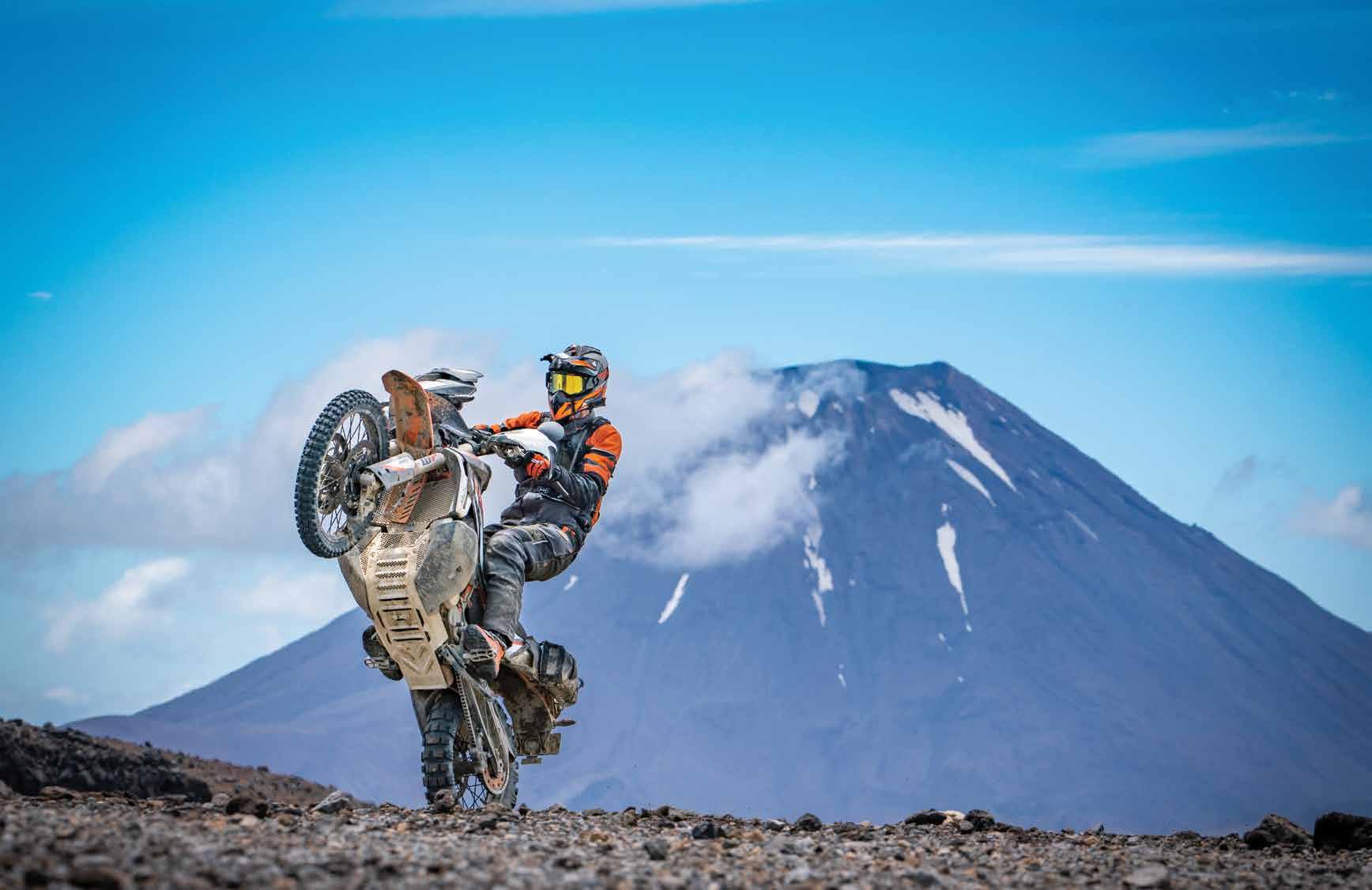

January 2020 marked a special year for me. Having graduated from university, a planned epic motorcycle ride with my old man from Singapore back to the United Kingdom over five months was due to start in mid-April. COVID19 ensured I didn’t go on that adventure. Needing something to look forward to, the 2020 KTM New Zealand Adventure Rallye: King Country became my consolation prize.
At 22, I’m a few grey hairs, slight beer belly and a significant amount of talent short of a textbook KTM adventure rider. With only four years of motorcycle experience, I’m definitely no Chris Birch on my KTM 790 Adventure R.
Every year a location is chosen, and KTM New Zealand, with the support of local riders, creates a Rallye that gives the riders special access to private farms and trails normally not accessible to the average Joe on his DR650. Each day consists of a main route as well as breakout sections of varying difficulty, with the Rallye catering to every ability and KTM adventure bike. The legend that is Chris Birch sets out the breakout sections, with his unique system of ‘chillies’ used to score the difficulty; the spicier the terrain, the more chillies.
Elliott Kent and Kevin Archer (both past KTM Ultimate Race Qualifier winners) planned days one and two. With both of these local riders being pretty handy, V8 Supercar driver Greg Murphy (MC for the week’s event) was quick to let everyone know there would be challenging days ahead. That included slippery riding conditions and the fact a three-chilli breakout for most was a one-chilli section for Elliot and Kevin.
Cambridge-Waitomo
Day one saw the riders negotiating a challenging main route from Cambridge to Waitomo. The 338km was spread over private roads, farm tracks, and gravel, along with 10 breakouts. Perfect! In true KTM Rallye fashion, day one was a grueller made to settle everyone into
u
Left: Every year KTM New Zealand, with the support of local riders, creates a Rallye that gives the riders special access to private farms and trails normally not accessible to the average Joe.
Top: Author Harry – at the back – was supposed to be riding from Singapore to the UK.
Right: Riders were told there’d be slippery riding conditions.
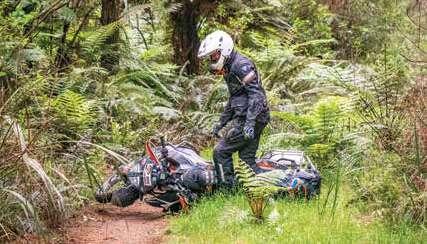

Above: The KTM mechanics worked into the night to get everyone Rallye-ready.
Right: With a steep and extremely slippery downhill bikes were dropping left, right and centre.
a week of exhilarating riding.
The greasy conditions meant a challenging day for the larger adventure bikes and rookie riders like myself. Day one’s breakouts weren’t for the faint-hearted, but were loved by the 690 Enduro riders, with the majority of the bigger bikes sticking to the main route or leaving with their tails between their legs.
Coastal gravel roads on the main route led to the surf of Raglan. One unnamed rider found himself with wide eyes and brown pants staring down a ute on a tight corner, and the result was a quick trip into the drain and a lie down for good measure. Being a great brand ambassador, Greg Murphy used the story to remind the rest of the riders to keep to the left at all times.
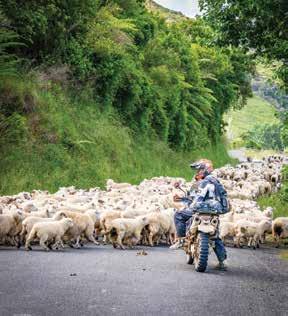

From Raglan, the top guns bashed through another seven breakouts. The rest rounded off the 338km with gravel and backroads to finish the day in Waitomo. And as always, the professional nature of the event meant the bivouac was set up and ready for riders and their bikes, with the tech team there to fix any of the day’s damages.
The compulsory sign-out with Annie Kerber, Karen Grover, Jo and Peter Birch and their dog Patzy kept things tight in the absence of KTM’s own Rallye queen Rosie Lalonde, exiled in Australia due to COVID19 restrictions.
Waitomo-Taupo
Waitomo to Taupo, which went straight on to exclusive farmland and offered a good warm-up for the eight breakouts to follow.
“The greasy conditions meant a challenging day for the larger adventure bikes and rookie riders.”
Below: A common road hazard in New Zealand. u
The second day saw a 374km ride from
Having survived day one, the day’s tactic for me was to venture off the main route and take on the breakouts. Breakout three was a very spicy three chillies, and it’s safe to say I probably wasn’t meant to be there. I guess it’s easier to beg for forgiveness than ask for permission when riding a KTM Rallye. With a steep and extremely slippery downhill bikes were dropping left, right and centre. After trying and failing to make my way down, myself and many riders were looking a bit beaten. Picking up bike after bike, ‘Uncle’ Chris Birch was there to save the day. He offered a quick

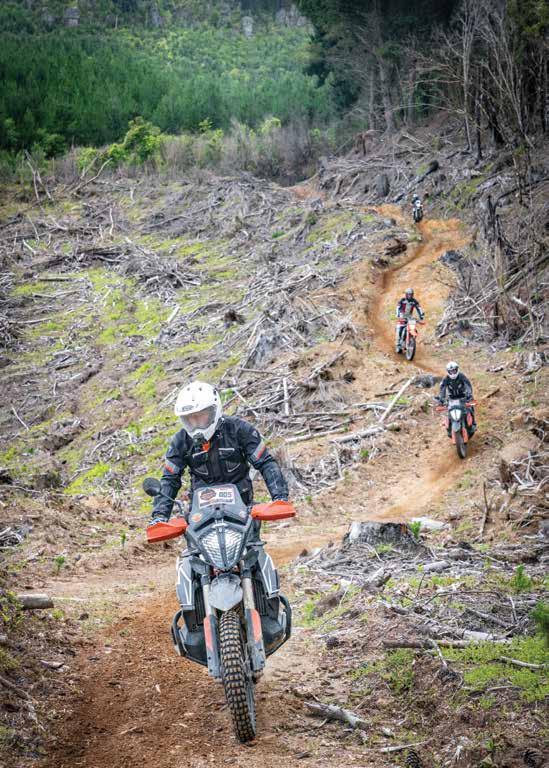

team talk and a great tip of turning the bike off, getting in a rut and rolling down on the clutch. It helped the masses and I start moving again. Thanks, Chris! After the mudslide both bikes and the riders deserved a break which came in the form of a fundraising sausage sizzle and fuel stop for Rachael Archer (daughter of Kevin Archer) who competes in the Grand National Cross-country Championships (GNCC) in the United States.
A spectacular afternoon’s riding back to Taupo offered epic tracks and gravel roads as well as ‘Kev’s Killer’, a four-chilli breakout, to test the 690s.
Back at the bivouac there was a mass assault on the tyre-changing machine with a few bikes looking worse for wear in the tech tent. The KTM mechanics, always up for a challenge, worked into the night to get everyone Rallye-ready for day three.
Taupo-Ohakune
Taupo to Ohakune was a well-deserved rest after the previous days, but with 390km of gravel roads and a breakout, it was still a ripper.
The morning’s weather was wet, cold, and miserable. Necessity is the mother of invention, and a new piece of riding gear was born. One rider made a quick roadside stop to grab some hot chips and, instead of consuming them, he stuffed them under his jacket, creating a roughand-ready heated vest – you can have that tip for free!
After a coffee and sausage roll, a staple of adventure riding, the cloud burnt off and the day was back in full swing. Gravel was eaten up by everyone with the opportunity to go sideways at times. Riding with the Nelson KTM tribe saw us take on the breakout of Fishers Track. Fishers was a slippy but flowing trail, iconic in the region, with a big drop off. Riders needed to keep their wits about them. I soon found this out when my 790 decided it needed a rest and a lie down after taking the worst possible line out of a muddy creek. In typical Rallye fashion help wasn’t far away in the form of Nelson rider, Gary Donaldson, who offered to get me back on the move.
After a quick lift and some fatherly advice I was back on my way, but not without showering Gary with a muddy roost as a quick thank you for his assistance. The final stop of the day was up a racetrack-like road to Mount Ruapehu. It was a great section of bitumen with a wicked
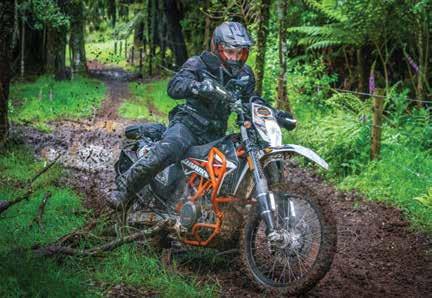
Top left: There was a bit of everything, including single trail.
Below left: A slippy but flowing trail, iconic in the region. Bikes were dropping left, right and centre.
Above: Riders needed to keep their wits about them.
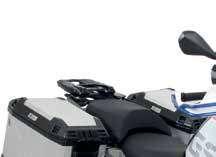
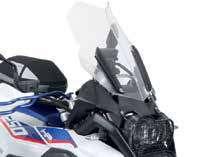
view and an amazing photo opportunity at the top. It was another great day on the Rallye ticked off with a beer in Ohakune.
Ohakune-Taupo
The fourth day brought us back to Taupo for the evening with some great gravel, backroads, and a spectacular breakout. Meeting up with Rob Kerber, Marcin Slusarczyk and Jerry Szuliński made day four. What was expected to be a relatively relaxing ride became one for me to hone my skills.
The day’s breakout was electrifying. Turning off the desert road and riding to Tukino Ski Field was undeniably the highlight of the day. The fast volcanic sand on the foothills progressively became more technical and rocky as riders climbed to the summit. It was a brilliant trail.
Below: V8 Supercar driver Greg Murphy (left) and Chris Birch were quick to let everyone know there were tough days ahead. u






















Of course, Rob Kerber was on hand at the top to take a few candid shots as the riders whipped out their best wheelies and power slides in front of a spectacular view. Yet another great day that was made by the riders of the event.
Taupo-Rotorua
The fifth day had 329km to cover from Taupo to Rotorua and eight breakouts, and words fail me. But with Rallye god Edd Shepherd coining it ‘the best day I’ve ever had on an adventure bike,’ it must’ve been pretty good. Not just because of the awesome terrain and its variety, but thanks to the camaraderie and atmosphere.

“A huge aspect of the Rallye is riders get to access some of New Zealand’s best and most exclusive trails.”
u
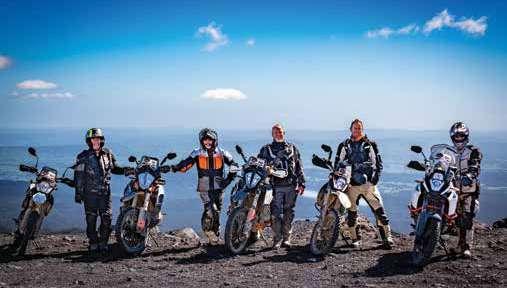
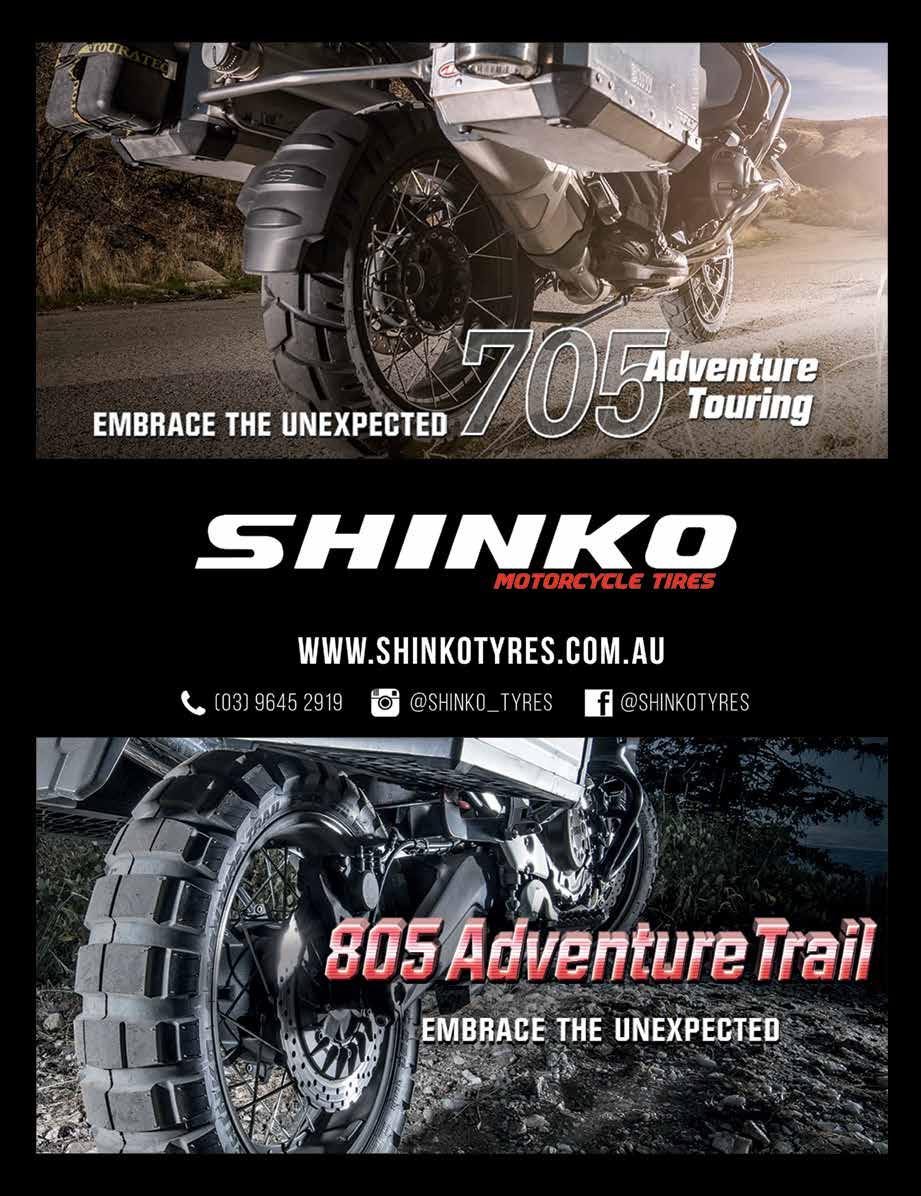
Above: Gravel was eaten up by everyone with the opportunity to go sideways at times.
Below left: Chris Birch made it all look so easy.
Below: Great camaraderie and atmosphere.
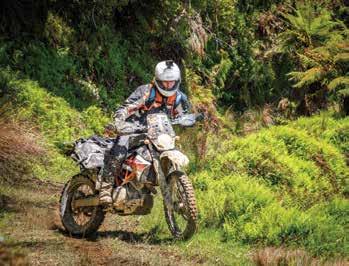


Left: An awesome variety of incredible terrain.
Left middle: Riders of every ability were pushed and challenged.
Bottom left: A week of exhilarating riding.
Below: The majority of the bigger bikes stuck to the main route or left with their tails between their legs.
Right: Riders could tackle tough sections knowing help was never far away.
Insert right: Author Harry Duffy was the youngest rider on the Rallye by a significant margin.
A huge aspect of the Rallye is riders get to access some of New Zealand’s best and most exclusive trails. Local hero Sean Clarke was the man behind day five, and he smashed it, with a tough main route and awesome breakouts, and riders of every ability were pushed and challenged.
The atmosphere on the trails grew as each rider helped the other, handing out tips and lending some muscle when the going got tough. With spectacular single track, technical breakouts, and the use of old crosscountry tracks, day five was the epitome of what a KTM Rallye is all about. With 120-plus riders and sweeps there’s always someone to help pick up a bike and get a rider to the bivouac by day’s end. It was a challenging day for some, but each rider definitely earned their beer that night, having completed the tough 1800km in five days.
Looking back on 2020, it was a year of cancelled plans and great opportunities. My final year at university was spent planning our Singaporeto-London ride through 30 countries. That dream, like many other people’s dreams, was left unfinished by COVID19. Hopefully, I can save that one for another day.
The KTM 2020 Rallye was for me an amazing opportunity to salvage a win from the year. It’s fair to say that at the end of five days of riding I’d gained 120 or so ‘uncles’ who were just there to ride, help each other out, and have a good yarn at the end of the day. The week exceeded all my expectations, and I’m a better rider for it.
While being the youngest (by a significant margin), never felt out of place playing at the ‘old man’s game’, but I could use a few fresher faces in the mix.
While riding the Rallye by myself opened doors in its own way, the plan was to be with my Dad, which would have been awesome. However, a bike misadventure and the resulting concussion pre-event ruled him out of the Rallye, typical of 2020.
To the adventurers out there with the next generation of Rallye riders left at home, bring them along next time. It’s not a bad idea to have them there to help you pick up your bike while spending some quality time together, and they might just love it as well. It’s hard not to!
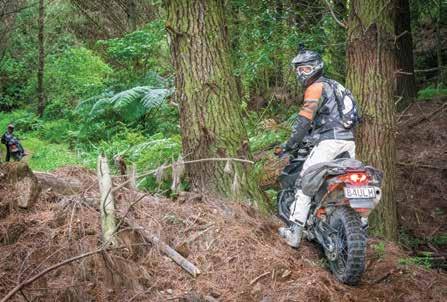
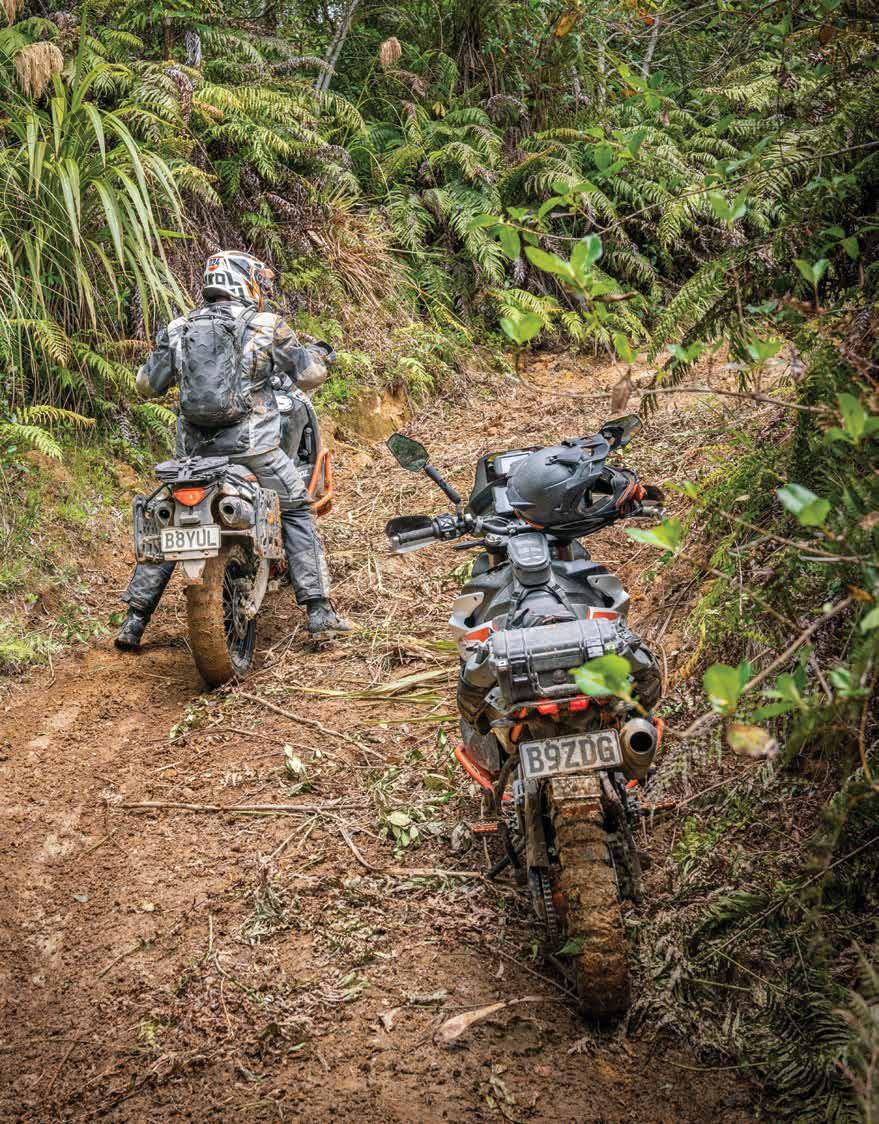

Glory days
Chris Harris’ 1986 BMW
R80 G/S Paris Dakar
Bike and rider are both classics

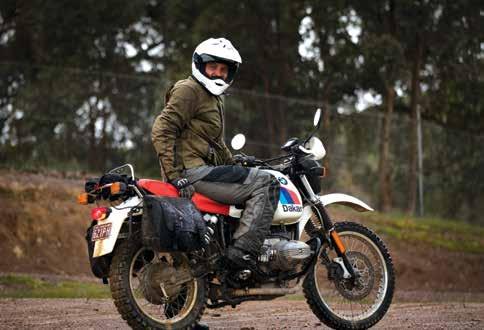
Left: The R80 G/S’s 797.5cc air-cooled boxer twin was shoehorned into the compact frame of the R65 road bike, fitted with long-travel suspension, conventional off-road size wheels, and BMW’s Monolever shaft drive and single-sided swingarm.
Above: The Paris Dakar is the jewel in Charris’ small collection.
BMW is just two years from celebrating 100 years of making motorcycles.
In that time its most iconic model lineage would surely have to be the GS adventure machines.
Kick-started by the original R80 G/S way back in 1980, the idea was to offer thrill-seeking, horizon-chasing enthusiasts a bike that could do it all with all-day comfort and reliability, on- and off-road. Thus, the adventure travel machine was born.
The R80 G/S’s 797.5cc air-cooled boxer twin was shoehorned into the compact frame of the R65 road bike, fitted with long-travel suspension, conventional offroad size wheels, and BMW’s Monolever shaft drive and single-sided swingarm. While it didn’t immediately enamour the world’s motoring press, in showrooms, the R80 G/S was a hit.
With some high-powered engineering input and a great rider in France’s Hubert Auriol (who passed away earlier this year), an ‘R 8 G/S’ won the Paris-Dakar Rally in 1981, followed by an enviable winning streak and impressive results throughout the decade.
Enter the R80 G/S Paris Dakar in 1986 – a special production version of the R80 G/S with notable upgrades to celebrate BMW’s rally success.
Over the regular R80 G/S, the Paris Dakar featured a beautiful, big, 32-litre steel fuel tank for a massive riding range of more than 500 kilometres. It could be considered the grandfather of today’s R 1250 GS Adventure. It was also distinguished by its bright red solo seat and rear luggage rack. It’s taken a little while to get there, but
these early G/Ss – and the R80 G/S Paris Dakar in particular – are now in high demand for collectors.
Chris Harris is the proud owner of this fine example, and while it understandably doesn’t see gnarly single-track, it’s no garage queen either.
“It’s the unicorn bike I thought I’d never be able to own. Yet, by sheer luck, this one now lives in my shed and it’s the family heirloom!” said Chris.
Chris who?
The new boy
Chris Harris is the new Head Of Marketing and Product at BMW Motorrad Australia. If his name sounds familiar, it’s no surprise. Not to be confused with Chris Harris the ‘other’ car journo and Top Gear host, Chris Harris the New Zealand cricketer or Chris Harris the English speedway racer, this Chris Harris, or ‘Charris’ as he’s perhaps better known, is the former editor of Motorcycle Trader and Café Racer magazines.
A hard-nosed car and motorcycle journo, Charris lives and breathes bikes and has a few sweet machines in his shed, including a now-perfect Triumph Daytona 1200, a Buell Lightning XB1200S and, more recently, an old AG bike baked in 20 years of Victoria’s finest cow dung.
But the Paris Dakar is the jewel in his small collection.
“I’ve owned and loved various makes and models over the years but, for me, there’s something about this old G/S, my second airhead, which I’ve owned for about three years now,” said Chris. “It’s ultra-reliable, capable and more than comfortable enough for 800km days, no probs, even by modern standards.”
Acquiring an old G/S has been a long time coming, however.
The dream come true
“I knew I’d never afford an R80 G/S Paris Dakar – let alone find one – when I started looking,” he remembered, “so I turned my attention to its successor, the R100GS, as something of a ripple effect from the R80 G/S as far as affordability and collectability. I actually missed three opportunities: an Alpine White R100GS and two Bumblebees. It still hurts.
“As for the R80 G/S, the mag borrowed this example for a feature story alongside the R nineT Urban G/S from a guy working in a nearby office, but it was firmly not
u
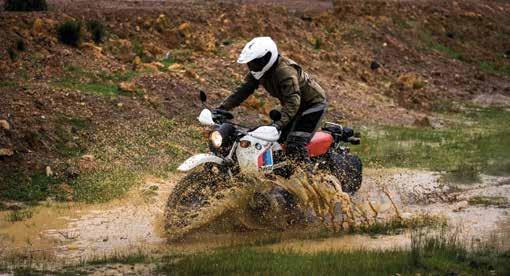
for sale. Fast forward many months later and ol’ mate changed his tune. He was going through a bit of a nasty divorce and needed to sell the G/S and wanted me to have the first right of refusal.
“It also involved writing up two receipts...”
It was the right bike at the wrong time for Chris who was still neck-deep building a new home. But opportunities like those don’t come up too often so, with the support of his wife, he pulled the trigger. It also helped that the seller wasn’t in a mad rush, which afforded Chris time to get the finances in order, including selling his quick R80 cafe racer.
In the detail
The feeling of bringing a new bike home is a special moment which etches into motorcycling memories. For Chris it was special alright – all for the wrong reasons.
“That bloody dog!” Chris growled.
“Within the first hour – nay, 10 minutes –of the beautiful R80 G/S Paris Dakar being at home, our dog, Cyril, the thennine-month-old rottweiler, chewed the driveshaft boot into a thousand pieces. I didn’t catch him in the act, but he’s lucky to be alive and still with us after that shenanigan!”
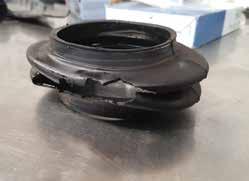

The lesson: Lock up your daughters and your bikes.
With the bike of his dreams in his possession, Chris set about sorting it out for his own needs. It’s a well-used future collectable, not a showpiece, so all changes are in the name of functionality and reliability while remaining as close to original as possible. A few examples include the Barkbuster handguards instead of the plastic originals, Oxford Retro heated grips, Pivotpegz, ’bar risers, a Megacycle exhaust and versatile Continental TKC80 tyres. The biggest upgrade – and the most beneficial – was the fitting of Wilbers suspension front and rear, which transformed the bike’s handling from horribly soggy to as good as it gets.
“Cam Donald once mentioned, ‘You can get the best out of a bad bike with a good set of tyres,’ and he wasn’t wrong,” said Chris. “After that, it’s all about suspension. Money well spent.”
The whole story is laid out on Chris’ website, www.parisdakarmelbourne.com, and Chris is clearly a very happy owner.
The future
While the bike’s glory days may have been late last century, it’s now to be enjoyed by Chris and his wife for a long time to come. After that, maybe one of his four kids. Cyril the rottweiler has since matured, thankfully.
With a fleet of shiny, new press bikes at Chris’ disposal, including the latest R 1250 GS and GSA, in his new job at BMW Motorrad Australia, it must be tough deciding what to ride.
Do you have a bike like Chris’ R 80 G/S Paris Dakar? A bike with a story, a bike you’ve had for years, or perhaps the bike of your dreams? Adventure Rider Magazine would love to share your passion for that bike with other Australian adventure riders. E-mail tom@maynemedia.com.au and tell us about your bike and its glory days.
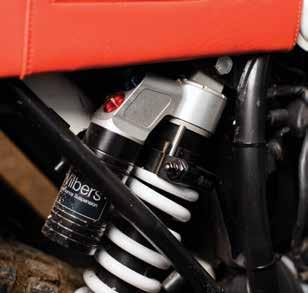
Top left: It’s no garage queen.
Above: Wilbers suspension front and rear transformed the bike’s handling from horribly soggy to as good as it gets.
Below: The Paris Dakar model featured a beautiful, big, 32-litre steel tank for a range of more than 500 kilometres.
Bottom: Cyril, the rottweiler (left), Chris, and the unicorn bike Chris thought he’d never be able to own.
Below left: One chewed driveshaft boot.
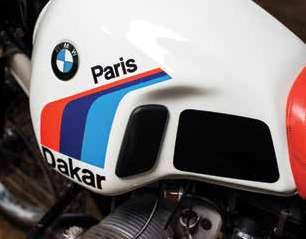


TheFly Line
Australia’s southern Fruit Fly Exclusion Zone (FFEZ) spans three states and marks a control line to protect producegrowing regions. Graeme Sedgwick found ‘The Fly Line’ an adventure route chock-a-block with peaceful localities, characters keen to tell a story, any number of curious pubs and countless under-the-stars camping opportunities.
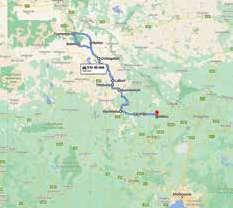
Above: 1486km along The Fly Line surpassed all expectations.
Main: A cloudless blue sky south of Hattah Kulkyne National Park.
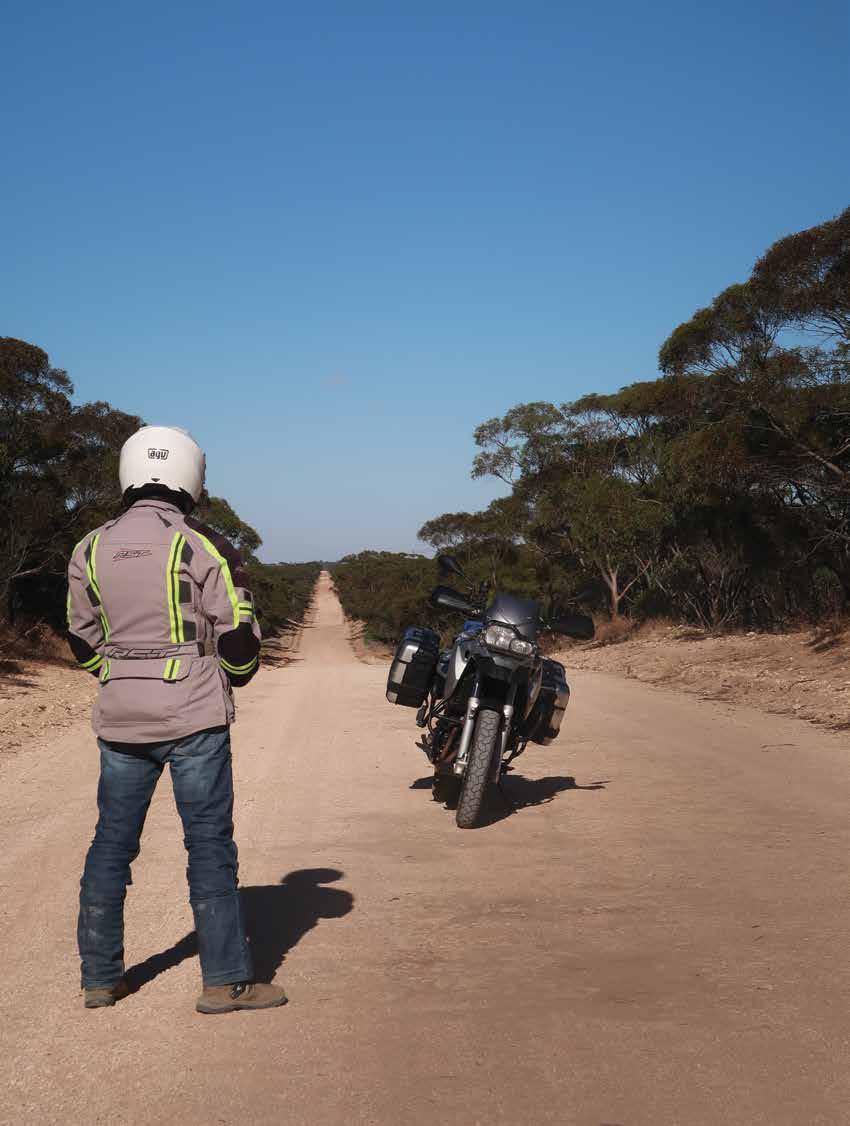
he Fly Line’ is approximately 2585km: 675km through eastern South Australia and the Danggali Conservation Park, 815km through northern Victoria and 1095km slicing through New South Wales’ southern Riverland country and the Mundi Mundi Range west of Broken Hill.
Without the luxury of predictable border crossings I decided Victoria’s western section of The Fly Line presented the best adventure and
quickest get-to-start point, an offset intersection south of Milloo in central Victoria, 258km from home. It meant I’d finish 648km further on. Getting to Milloo was a zig-zag run through the shallow, undulating scrub of Whipstick Forest Park and Kamarooka State Park north of Bendigo, a welcome alternative to grinding along main roads.
The ride began with Kamarooka’s Ironbark, Yellow and Box gums and one of the scarce eucalyptus-oil distillation plants along the scrubby forest’s main north-south boundary road, before taking Camp Road and Kelly Road to arrive at my unofficial start point.
Buy line
The Fly Line tracks pretty much in sync with a collection of corridors, mapped and unmapped, sealed and unsealed, criss-crossing what can first appear as featureless country. In reality, the region couldn’t be more curious and laden with variety. Turning north on Pyramid Road at East Loddon then west along narrow tar via Calivil, the Loddon Valley Highway and a right just north of Bears Lagoon, I rolled along narrow tar that briefly morphed into a wider, super-smooth tarmac run punctuated with flowing curves and an offset five-way intersection split by railway lines and various sized buildings. One in particular, a tin

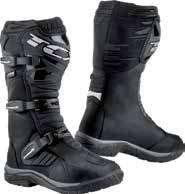

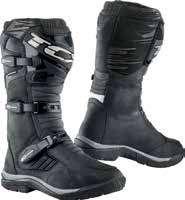
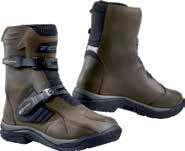
Words and images: Graeme Sedgwick
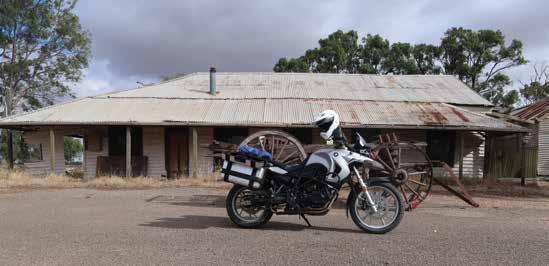
shed with a rusty car out front, prompted me to stop and snap a pic. Suddenly I heard growling. I froze and the volume increased until a shouting figure appeared.
“It’s a Ford!” screeched the scarecrow-like shape. “You wanna buy it? It’s for sale?’’
I extended my hand and offered, “My name’s Graeme! What’s yours?”
“Robert!” replied the bloke, who was clearly up for a chat, including a yarn about how a policeman dinked him on his motorcycle in Tasmania when he was visiting his mother.
Pull a crowd
Mysia came next, scattered around a similar intersection split by railway lines and, judging by surveillance cameras trained upon its remains, what must have once been a significant building.
After Mysia was Boort, a township on a rise that afforded sweeping views of surrounding agriculture.
Boort was a surprise. Its public and private buildings, including the Railway Hotel, stood clean and proud and the main street was a-buzz with locals. I continued west along Wycheproof Road then
turned onto Jeruk River Road, an unsealed thoroughfare that weaved its way between river gums before becoming a rougher, exposed shale, almost to Quambatook.
Quamby – as it’s locally known – is another rural township caught in generational change. Its streetscape showed evidence of more prosperous times, with standout buildings which included a pub, general store, post office and many others. One can only hope Quamby’s not-to-be-missed tractor pull, now lost in time, will have a resurgence to encourage visitors.
After Quamby, Tittybong and Lalbert came and went as the afternoon shadows lengthened and 488km rolled over on the trip meter. It occurred to me it was time to find a sheltered spot somewhere to camp and review what remained of my Fly Line ride objective: Boltons, on the Victorian side of the South Australian border.
Closer
The Google weather forecast the next morning confirmed another scorcher for what I expected to be the toughest leg of my Fly Line ride.


Top
Once packed I continued northward, crossing Long Plains via Springfield Road’s gravel and passing nearby Waitchie to the east. Waitchie wasn’t far from Pentarch’s new Mallee Hay processing plant at Ultima. The facility takes advantage of the Manangatang rail line upgrade to become one of 10 Victorian plants that compresses hay for export to feed dairy and beef stock.
After a waterless Lake Wahpool, Springfield Road became a scratchy, whitish, narrow, sealed run into Chillingollah, at which point I decided the track to my left between the upgraded rail line and tar to Chinkapook needed to be ridden. From Chinkapook my Fly Line ride changed direction again and headed west along an unsealed road, then north through Mittyack and on to Kulwin, a mapped point on the Mallee Highway where I crossed on to Hogan’s Road to begin a less straightforward course that progressively tracked north, then west via Cramenton south of Hattah Kulkyne National Park.
A cloudless blue sky confirmed it was gunna be a stinker and the mallee and Sunset country loomed larger with every kilometre.
Fear factor
I crossed the Sunraysia Highway just north of Trinita and into the southern Murray Sunset country’s semi-arid woodlands and open plains. There were plenty of large Grey and Red kangaroos alert to my passing and I felt fear wash over me. Had I bitten off too much? Had I sufficient water? Would my panniers be a hindrance? Would one tin of sardines, scroggin mix and a PLB be all I needed if things turned ugly? Ahead, 140km of unsealed roads and tracks were punctuated with the unpredictability of sand. It wasn’t the time to be doubting my plan to float like a butterfly as best as I could. It’s not impossible. Grass grows, and birds fly. I figured I could stay loose and ride.
There was plenty of daylight to reach my goal, so I made lots of rehydration stops. I stayed wide-eyed and picked ways around sections that would max out my talent in a blink. Having been caught out before in deep bulldust I knew how quickly things could change.
The well-maintained gravel roads through Wymlet were a memory as I bolted west along Honeymoon Hut Track. It was hot going and that was probably why I found myself heading south when I ought to have been continuing west along what would have become Sunset Track. Luckily my unintentional southward run became easier and eventually landed me among the scattered salt lakes referred to as the ‘Pink Lakes’. Due to a red pigment, carotene, secreted from the lakes’ algae, the waterholes change from deep pink to a glistening white throughout the year, particularly after winter and spring rains. When arrived in the heat of summer evaporation had left a concentrated salt crust over black mud.
Bolt ons
The navigational error added 36km or so and some extra time, and that meant riding towards a sinking sun. My passage along Sunset Track, which commenced as a grind, ended up including some heavy front-end ploughing and twice getting bogged.
The latter, in truth, was more a result of my daydreaming. It could’ve been worse had I not had the presence of mind to unload the bike and make the task of extraction a little easier. But I was left to ponder facing the challenge of darting wildlife as the afternoon wound down to a big, expansive mallee sunset. Thankfully things became less intimidating the further went and, with some patient navigation, I was able to skirt around the deepest sand wallows helped by vegetation on the verges. There was good news, though. The Murray-Sunset National Park is one of few remaining semi-arid regions where the environment is relatively untouched, with wide, open landscapes, amazing sunsets and starry nights adding to its 633,000 hectares of vastness and isolation. My east-west crossing had at first appeared daunting but unfolded into a relatively drama-free ride to my planned destination.
At Boltons I turned to ride the Border Track southward to the main highway where I turned east to Murrayville’s pub for several drinks, food and a good night’s sleep.
More than expected
I had accomplished a ride inspired by the FFEZ that opened eyes and mind to places I’d not considered. Furthermore, my return allowed an opportunity to enjoy a drink at Ouyen’s only hotel – the Victoria – and to reflect on Channel Nine’s A Current Affair
program which, in 2020, reported the historic pub had faced an uncertain future. The report claimed big business had blown into town and then packed up without paying a $125,000 debt when a solar-farm project stalled.
I was glad to see the pub still there and still going strong. Also, I was able to stop at once-vibrant – but now less-so – townships which really deserved a visit and a spend-andengage with locals. It was great to get a feel for localities that don’t rate within the daily cut and thrust of urban life. When I pulled the key after 1486km in southern Victoria I felt The Fly Line had surpassed all expectations.
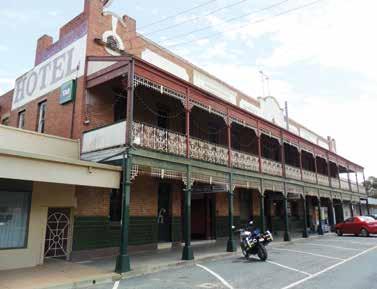

Above left: It was great to get a feel for localities that don’t rate within the daily cut and thrust of urban life.
Above: Waitchie takes advantage of the Manangatang rail line upgrade.
Below: Heading for Ouyen.
right: Ouyen’s only hotel – the Victoria.

Alpinestars Tech-Air 5
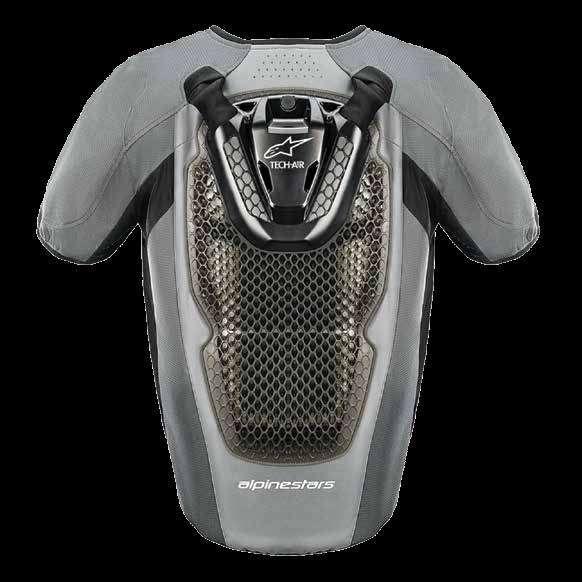
comparatively inexpensive, and when the jacket or vest does its job, everyone’s happy. The limitations from the tether arrangement come from the rider needing protection in an incident where he’s not separated from his bike by more than the length of the tether. A collision where he’s thrown forward into the tank, ’bars and screen could be one instance, and where the rider’s trapped under the fallen bike could be another.
The next big thing in rider safety gear is here: the ‘air-bag vest’. As usual, Alpinestars has a first-rate example.
Those who watch MotoGP or SBK will be familiar with the sight of a rider crashing, pounding along the deck, then jumping up and walking away looking a bit like an upside-down triangle on legs.
It’s the result of airbags built into their racing leathers.
Unlike like the airbags in most cars, the Tech-Air 5 has multipile sensors which trigger a deployment – make the airbags inflate – before an impact in the tiniest fractions of a second, thus offering a very high level of protection to the rider.
That’s the concept.
The practicality is a lot more involved and looks set to offer adventure riders a seriously high-level protection option.
Tethers
Air-bag jackets and vests have been around for a while. Typically they work off a tether or lanyard. When the rider is separated from the bike, the tether extends so far and then ‘pulls the pin’ on an air canister. The airbags inflate and do their job.
It’s a good system because it’s
A second consideration is the time it takes to inflate the vest, and once we start talking about ‘time’ with these things, be prepared to have your mind boggled.
We’re going to be comparing tiny, tiny splinters of fractions of a second that will be beyond most of us to comprehend.
Electronics
Obviously high-level road racers aren’t tethered to their bikes.
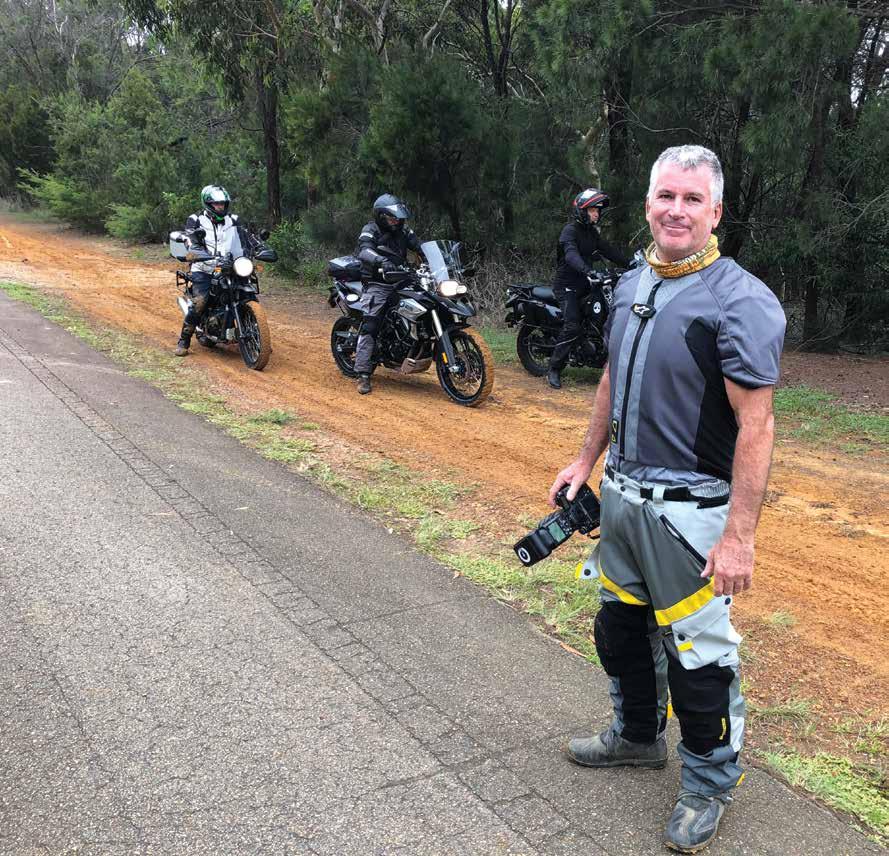

Above: Very comfortable and easy to wear. It holds body heat, and on hot days or hard rides will need to be removed as soon as the rider pulls up. Otherwise it can stay on
Above insert: Alpinestars calls it the ‘envelope of protection’. It’s like a short-sleeved shirt and gives almost wrap-around coverage, including shoulders and a high percentage of the torso.
As always, it takes time for the technology tested and proven in racing to reach the average punter, and that’s what we’re now seeing in the latest offerings of air-bag vests and jackets. Adventure Rider Magazine was incredibly Air 5 can be used with any brand of jacket which has the necessary room. Adventure Rider Magazine’s editor found nearly all his jackets were suitable. According to the manual, a jacket will be suitable if the jacket width is ‘0.5 x the rider’s chest measurements in centimetres, although that’s not specified in the manual that we could see. The vest doesn’t expand to twice its normal size or anything so ridiculous, but owners will need to ensure there’s room for some puffing up.
The second big feature of the TechAir 5 is it’s chocka with accelerometers and gyroscopes.
So instead of relying on a rider being hurled a set distance relative to the bike, the vest measures and stores regular movement. Then it interprets irregular
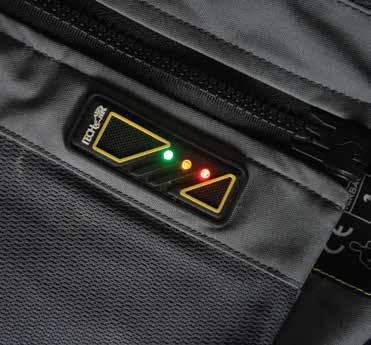
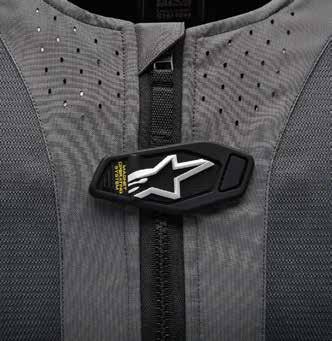
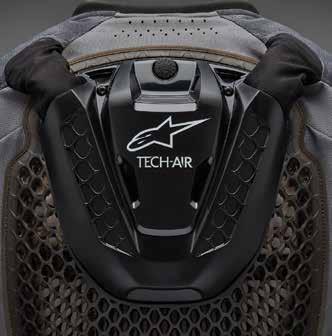
movement which triggers the inflation. That would include things like sudden, cataclysmic changes of speed or direction.
‘Sudden’ in this context, is shit-fast.
The Tech-Air 5 measures things in thousandths of a second.
Interestingly, it doesn’t include laying the bike down in the car park when a foot slips, or stepping off on wet grass when the whole thing slithers sideways at walking pace.
Unless the rider is somehow thrown or has a very rapid change of direction, it’s very unlikely the vest would deploy.
There’s certainly no need to worry about setting off the vest when it’s time to walk away from the bike.
On the other side of that coin, the Tech-Air 5 isn’t suitable for racing or off-road situations where the rider’s likely to be flung around a bit in the normal process of riding. That rider movement might be enough to set it off.
Blow up
Another big feature of the Tech-Air 5 is its gas supply.
A lot of air-bag vests use a CO2 canister, which is good because it’s very inexpensive and can be replaced easily. The downside is CO2 bottles typically inflate a vest to around 80psi and are comparatively slow in operation. The twin argon canisters used in the Tech-Air 5 inflate the vest to around 180psi, and the inflation is triggered by a pyrotechnic charge. The result of that is inflation is typically complete in between 25 milliseconds and 40 milliseconds.
Here’s where the tiny time increments we mentioned before become a bit dazzling.
We had a briefing on the jacket from Australia’s Alpinestars brand manager Steve Jennings, and amid all the instruction and explanation on the app – yes, the vest has its own app – and high-tech electronics, he had a good illustration of the
time interval he was trying to explain.
“Most people don’t equate 25 milliseconds to what that looks like in real time,” he explained. “If you look at alpinestars.com/techair, there’s a graphic scale of one second which spans the entire page, and it shows what 25 milliseconds looks like.
“Very few people realise how quickly this vest inflates. It’s crucial, especially on adventure-touring bikes. If you were to hit a car, or a car were to pull out and you collided, or you were going to go through the front of the bike, the vest would be fully inflated before you actually hit you hit the windscreen of your own bike.
“That’s a big, big difference between a tethered version and the Tech-Air 5. It’s definitely one of the biggest positives with this set up.”
Envelope of protection
Another interesting facet of the Tech-Air 5 is the coverage it offers. Alpinestars calls it the ‘envelope of protection’.
Very early airbag gear only protected shoulders. This latest version is like a short-sleeved shirt and gives almost wrap-around protection, including shoulders and a high percentage of the torso. There’s a back protector built in, and a flattish plastic housing at the top, between the rider’s shoulderblades, houses the electronics.
The vest needs to be charged via a discreet USB port on the back, and the app allows the rider to register the vest, alerts the owner to any firmware updates, and also offers tracking. A ride can be mapped just like a GPS tracker, courtesy of the vest and app.
Real world
The spec sheet is impressive, but what’s the Tech-Air 5 like to wear?
Putting it on or taking it off couldn’t be easier. Just put the arms in and zip it up. When the Velcro tag at the top is in place across the zipper, the LED lights start flashing, the vest goes through its start up and the rider’s
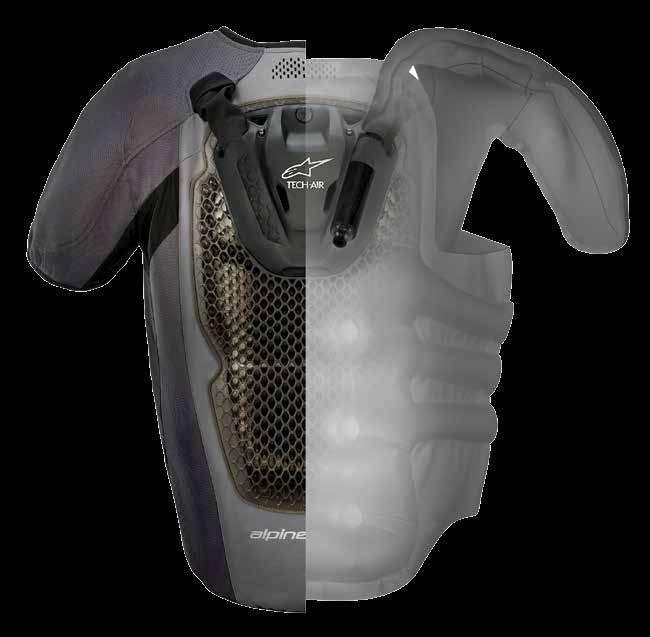
good to go. Taking it off is the same in reverse. Just flip the Velcro tab over – which shuts the vest down – unzip it, slip it off and you’re good to go. Initially it felt as though there was some weight in it, but it compared favourably to several of the riding jackets in the magazine’s current collection, and the weight of the vest wasn’t noticeable at all once the riding started. It’s a tough bit of clobber as well. Even though the manual points out the Tech-Air 5 shouldn’t be used as an external riding jacket, Steve Jennings has never seen one punctured. After a couple of multi-day rides and a few regular work days, about the only negative we can offer on this vest so far is it holds a lot of rider body heat. We found ourselves stripping liners out jackets right, left and centre, and on hot days throwing off the vest at stops became a priority. That seems like a small price to pay for the protection this equipment offers, and once we became used to it we reckon we’d know how to set up the outer jacket before we started riding. Right now it’s still very new to us. What’s it like during a crash?
So far we don’t know. But the editor’s wearing it, so we’re guessing it won’t be long before we can
The Tech-Air 5 retails for around $1000, you can grab or order one from your nearest bike shop, and you can find out a whole lot more about it at

Top left: The LEDs work through a sequence then the green stays on to signal the rider’s good to go. It only takes a few seconds.
Middle left: Once the Velcro closure is in place, the system is live. Undo the Velcro and it switches off. Simples.
Left: A flattish plastic housing at the top, between the rider’s shoulderblades, houses the electronics.
Left: According to the manual, a jacket will be suitable if the jacket width is ‘0.5 x the
Australia’s top five Wildest
rides
The Fitzgerald River National Park
Located on the southern coastline of Western Australia, The FRNP was a stunning surprise. Approximately halfway between Albany and Esperance, the whole stretch of coast is untamed and incredibly rugged. There are some beautiful, isolated beaches along the stretch of coast, and by complete accident I stumbled across a section of huge granite cliffs and thundering surf. At the base of the cliffs was a small, pristine, white-sand beach with the mouth of a river tucked away toward the rear. Schools of fish swam lazily past, unfazed by human presence. It was a shipwrecked sailor’s paradise. spent the better part of the day at this secret beach and ran up and down it buck naked like a child. I did not see another vehicle.
It needs a bike or a 4x4 to get the most out of this park. And take your time. I only got to scratch the surface of what was on offer.
Benji Brundin set a world record crossing Australian deserts and has ridden up, down and across the country in a quest to touch the cardinal compass points. Here’s his list of the five wildest places to ride in the Wide Brown Land. If you’re planning your own rides, maybe you can tick a few off yourself.

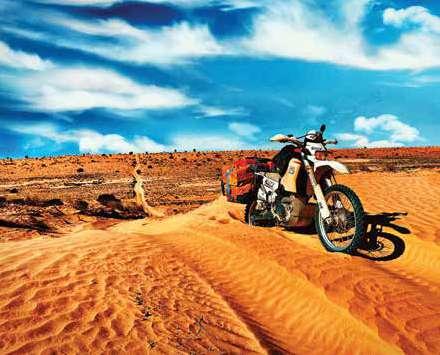
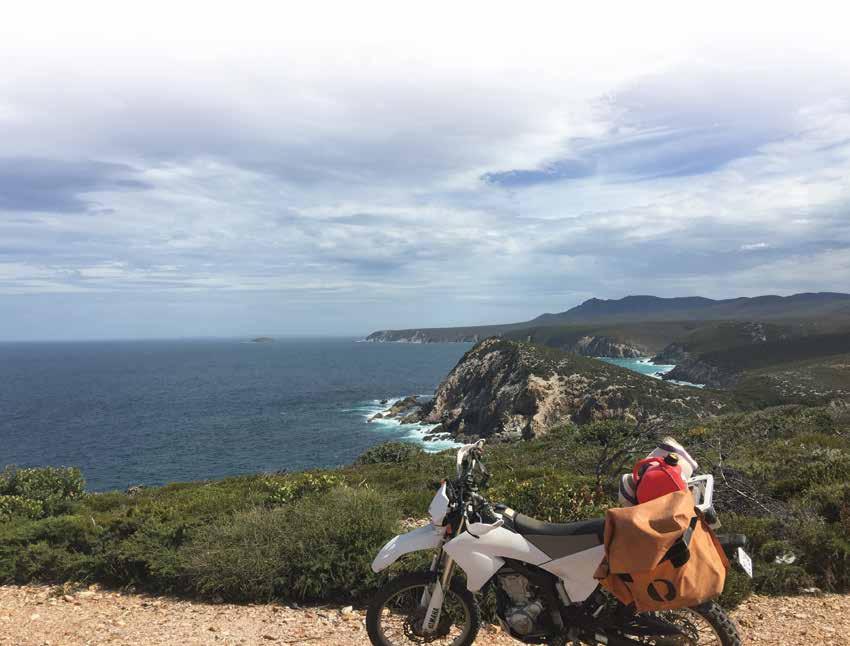
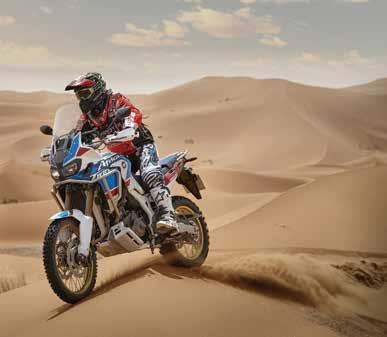
TheDesert is located deep in the heart of Australia’s vast interior. The eastern edge is Birdsville and western edge Dalhousie Springs, so just getting to either side to start a crossing is an adventure in itself.
It’s usually recommended to cross in the same direction as the prevailing winds – west to east – as the dunes are easier to climb from the west, and have a softer, steeper descent on the leeward side.
spent three days crossing the largest parallel sand-dune desert in the world and was constantly awestruck as climbed to the top and looked over the seemingly endless mounds of sand rippling across the landscape to the horizon. The dunes were relentless, constantly rising up like a giant, rolling ocean swell. By the end of each day I was simply exhausted.
At night I made camp on the clay pans between the dunes. I could hear families of dingoes howling to one another, and the sunset from the top of Big Red was simply stunning.
The Simpson really is an adventurer’s playground, and it’s considered one of the world’s great riding challenges for a good reason. Having made the crossing on a bike is something of which a rider can be proud.
Make sure you take at least six litres of water per person, per day, and be sure to stop into Dalhousie Springs to enjoy a soak. You won’t be disappointed. u



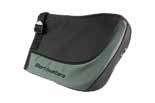

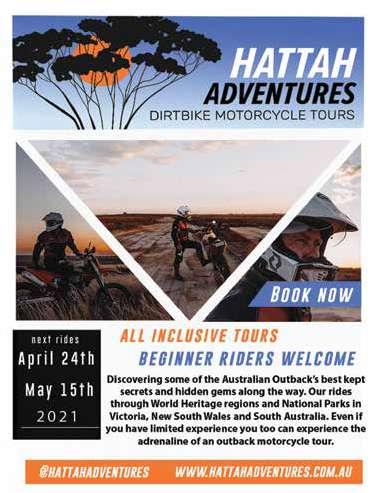
Words and images: Benji Brundin
The Simpson Desert
Simpson

Fraser Island
Located on the eastern point of Australia, Fraser Island took me by surprise.
decided to explore the island almost as an afterthought, and I assumed it was going to be an overcrowded tourist attraction. How wrong was.
Fraser Island is a natural anomaly. It is the largest sand island in the world, made by the tides from the south washing the sand up on the currents. It stretches north to south with an incredible 120km beach running almost the entire length of its eastern shores, and is home to over 74 different species of reptiles, 350 different species of birds and over 50 species of mammals. There are lots of dingoes. Hundreds. Vegetation consists mostly of dense tropical jungles interspersed with sand dunes, and it’s the only place in the world where tall rainforests grow in sand. It also has over 100 freshwater lakes and creeks. The aboriginal name for the island is K’gari, which translates as ‘Paradise’. Those first inhabitants got it right. It is incredibly stunning. Make sure you plan to spend at least a few days exploring the island. Be sure to check the tides before you start your trip up the famous beach. At low tide it’s hardpacked and a joy to ride on, but as the tides change, the sand can turn to soup and will easily swallow a bike like quicksand.
There are a few different options for resort-style accommodation, but if you want to get a little further away from the tourist hoards, head to the northernmost point of the island and check out the lighthouse.
Of the inland sand tracks, some are by far the deepest in Australia, so a well-equipped bike is a must.
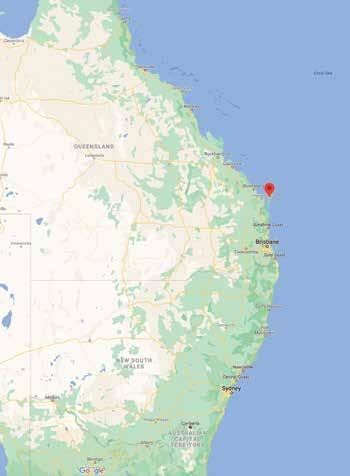

Cape York
Cape York is still regarded as one of the last great odysseys in Australia. The bush is wild and the rivers deep and full of crocodiles.
Cairns is the perfect place to launch an expedition to the tip. But to get there you’ll need to traverse the steep, thick, jungle of the Great Dividing Range, and then close to 1000km of some of Australia’s most remote regions. It’s certainly achievable, and the Peninsula Development Road is becoming more and more accessible each year as long stretches become blacktop. But the hard-core adventurers just won’t be able to resist the challenge of the CREB Track and Old Telegraph Track. Lines of broken-down bikes and 4x4s along these red-clay sections should be warning enough, but if you’re well-equipped and feeling confident, you just have to give these wild, unmaintained sections of tropical bush a go. I spent six days riding from Cairns to finally arrive at The Tip itself. I remember sitting by the little sign. I watched the currents of the Torres Straight roar past, taking turtles and seaweed with it. The walk up to The Tip itself climbs over a rocky headland. From the top you can see out over the islands that pepper the ocean all the way to Papua New Guinea. The palm trees and tropical jungles stop abruptly at the edge of pristine, white, sandy beaches, and both beaches and jungle are teeming with wild inhabitants – snakes, crocodiles and wild pigs, to name a few.
Isolated and untouched, it’s a wild, beautiful, savage place. It is still one of the last true motorcycle adventures left in the world. Get in quick before this frontier is opened to every bus and tour group under the sun. u


JUMP STARTERS
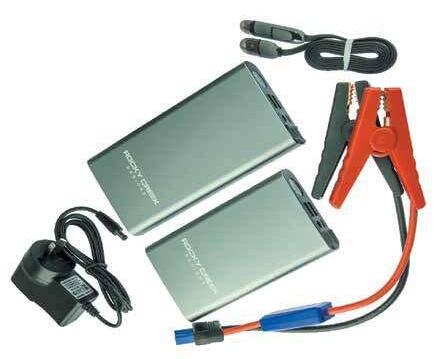
Jump Starter Packs contain:
Carry case
12v accessory plug for on-bike charging
Battery leads
Combination
important pieces of emergency kit you can carry with you. Whether you’re on an outback track or heading home late at night, a jumper starter will protect you if you get stranded with a flat battery.
Our jump starters will start motorcycles, watercraft, ATV/ UTV, snowmobiles and petrol car engines up to 4.0L (300A Jump Starter) and up to a 6.0L AND 3.0L Diesel automotive engines (400A Jump Starter)
They will also charge your phone or tablet through the USB outlets and all have a built in LED light.
For further information on this and all our products, please check our website for details. Also available from all good motorcycle shops through Pro Accessories

Kakadu
My number one wildest place in all of Australia comes in miles ahead of the rest. The non-negotiable, undisputed champion of Australia’s wild rides just has to be Kakadu.
Kakadu is the largest national park in Australia. It’s located about 200 kilometres from Darwin and covers an area of over 20,000 square kilometres. Shaped like a giant playing card, it has a huge escarpment wall that stretches from Katherine Gorge in the south all the way up into Arnhem Land in the north. This wall is a sheer vertical cliff, reaching over 200 metres high in some areas. Most of Kakadu was under a shallow sea nearly 150 million years ago, and the escarpment made giant, immovable sea cliffs.
Up on the escarpment wall, more commonly known as ‘stone country’, the land is harsh and dry. Huge crevasses open up under foot as the water of a million years of flood and rain has washed away much of the topsoil, leaving the stony plateau barren and dry. Creeks have cut huge gorges in the soft rock, leaving pockets of dense, monsoonal rainforest protected by the shadow of the wall from the harsh tropical sun. Dozens of waterfalls cascade off this wall into the rivers and creeks below. Some run dry in the hotter months, while in the peak of the wet season, they can produce their own cloud systems high above.
Kakadu is also the only national park in Australia that is home to an entire river system. The South Alligator runs from its source in stone country to the coast in the north. It is one of the most densely populated rivers in the world – populated with big estuarine crocodiles.
Here is another fun fact: the whole world’s water quality is measured against the water of the stone country. Up on the plateau there is no human impact – no farming, mining or agriculture to pollute the quality of the water for thousands of kilometres – so the water there is used as the benchmark to test all freshwater river systems around the world.
Below the escarpment wall stretch the endless floodplains, as far as the eye can see. These floodplains cover almost 70 per cent of the entire park. In the wet season, most of Kakadu is under water as the monsoonal rain floods over the escarpment wall like the raging torrent of a burst river dam.
Kakadu is also home to the oldest practising culture in the world. You can walk through the stone country and along the escarpment wall and find rock art everywhere. Rock art depicting thylacines (Tasmanian tigers) has been dated at up to 65,000 years old. There are over 280 bird species alone in the park, many of which migrate there to breed during the dry season, and over 70 species of mammals and 117 species of reptiles, including freshwater and saltwater crocodiles. Buffalos, pigs and horses run wild. It isn’t uncommon to see them walking along the highway. Kakadu is one of only five sites in Australia to hold a World Heritage listing

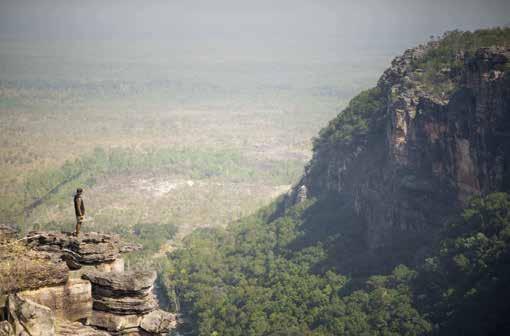
for both cultural and natural universal values. It’s rich with history, culture and wildlife. It’s rugged and isolated – literally cut off from the rest of the world. It’s the wildest place in all of Australia. was lucky enough to spend the better part of the dry season there and was able to explore the park intimately on the 250R. If you can only spare a few days, make sure you get out to Ubirr to check out the sunset, and be sure to stay well away from the water’s edge of any billabongs and rivers. Their inhabitants aren’t friendly.
If you have time, the one thing you should do is climb the escarpment wall at the base of Jim Jim Falls and hike across the stone country to the top of the falls. The view is absolutely priceless.
You can do it
So,
there you have it; my top five. Just writing this article has got my pulse racing as reminisce about the wild adventures of days gone by.
If this article has got you excited and planning your next adventure, then please, check out my website daring2venture.com.au and some of the other places I’ve ticked off: Esperance, The Kimberley, The Canning Stock Route. I talk about these and many other places in my self-published book Hunting Fear. Have a look, and if you enjoy a tale of wild adventure, then perhaps the book could be a companion on your next ride. Safe travels everyone.
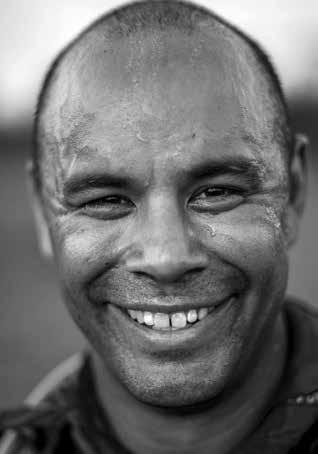
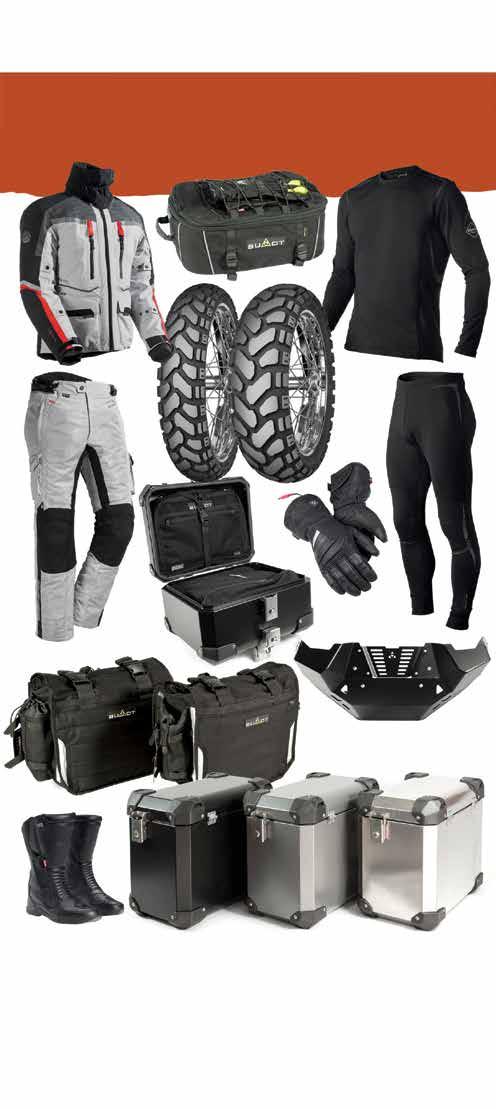








Great Dividing Range West of the
Bob Wozga and Rod Pedemont went for a midsummer ramble through the Blue Mountains west of Sydney.
Words and images: Bob Wozga
At face value, places visited or travelled through can be taken for granted. Sometimes it’s not until after I return from a ride and research places visited that I appreciate the history of the area. Then I stare at the computer screen and think, “Bugger. I should’ve spent more time looking around.”
The good thing is, it gives a good reason to return.
Iron man
Once upon a time Mount Victoria was a major tourist stop. People would catch a train, stay overnight before
travelling to Jenolan caves by horse and cart, or risk their lives in one of those fandangled motor cars.
Now it’s a stopping point for a cup of coffee and breakfast, or a meeting place before continuing further west. With a wife or partner as pillion, a browse through old cottages converted into antique shops might be your thing.
It’s important to keep in mind the speed cameras and speed limits, especially during double-demerit point periods. Maybe apply to receive the photo from the RMS with your arms in the air or look of sheer
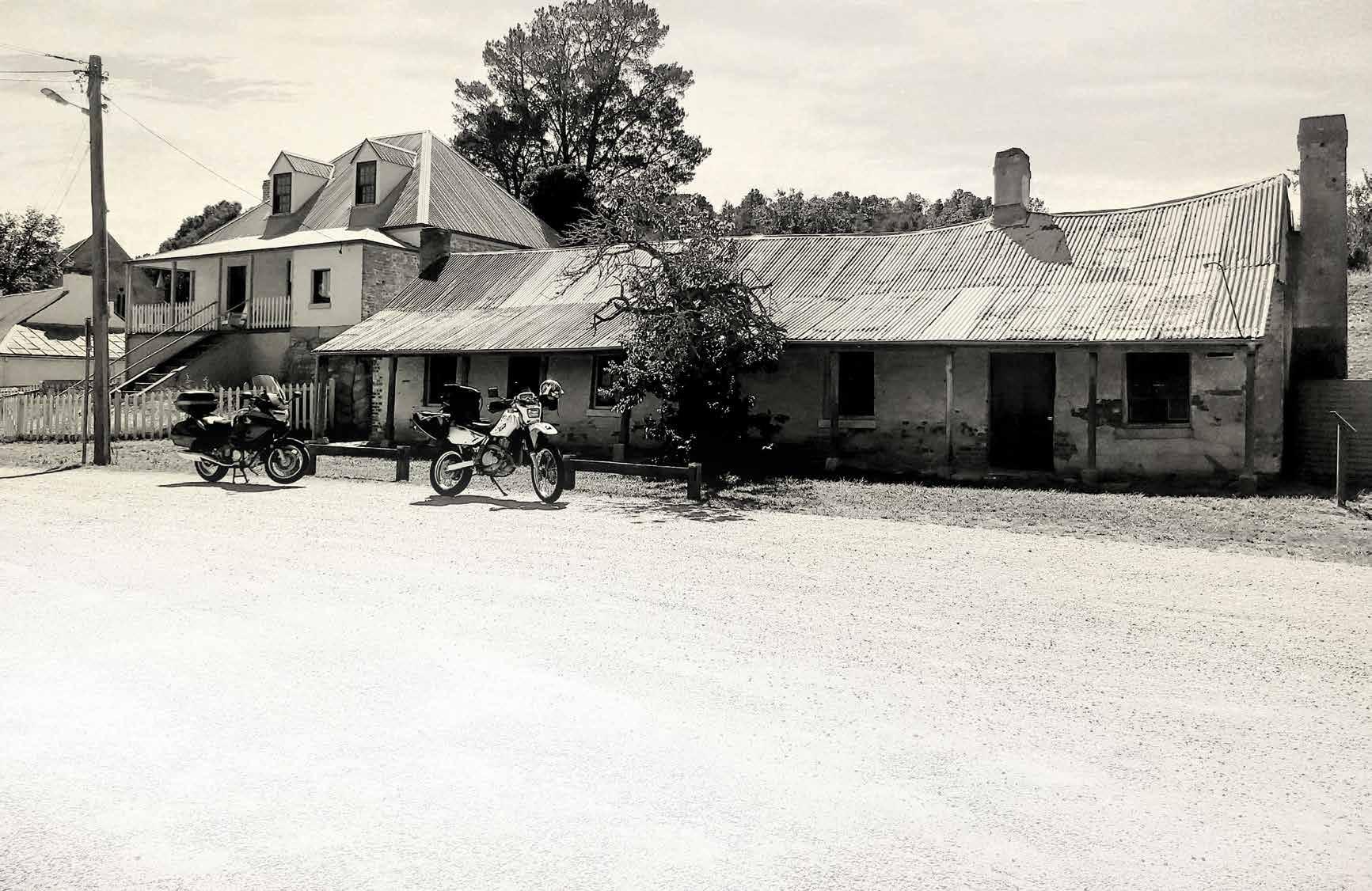
terror on your face from the descent – or maybe from an encounter with Henry Lawson’s ghost at the second bridge – as you pass the bottom camera?
The high winds had eased by the time we stopped at Hartley and the temperature had risen to the low 30s. Colonial buildings made a good backdrop for photos of the bikes and, for those old enough, there may be a few memories of driving through with parents on the way to Jenolan Caves or the pine forests of Oberon. The blacksmith in the Talisman Gallery admitted COVID19 had been a blessing to him and other people in country communities as more people were now enjoying day
Above: Appreciating the history of the area.
Below: Local colour.
Right: As a day ride, 460km, 12 hours, four seasons and some history, you can’t get better than exploring west of the Great Divide. u



trips, stopping to explore tracks along the River Lett and rock formations behind the town, before watching him create one-off metal sculptures and, more importantly, buying them.
A big fan
Turning onto Jenolan Caves Road, a sign warned of poor road conditions for the
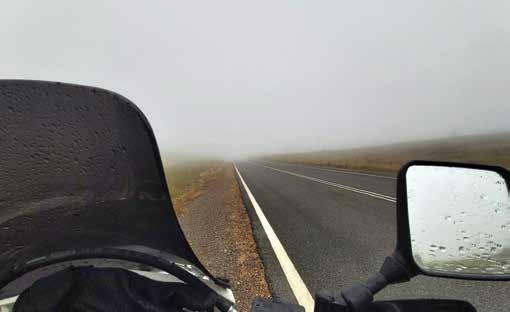
next 46km. Riding on the ridge line on a windy day, I could understand why the sign was there. Not only were the views spectacular, but the buffeting of the wind kept us on our toes, as did the odd car that veered to the wrong side of the road while drivers looked at the scenery instead of the bitumen. The long grass flowed in waves across fields like whitecaps lapping the shore of a lake, and ribbons of gravel roads followed the contours of hills leading to the valley floor.
Passing through Hampton, blades of a wind generator popped up from a canopy of trees, slowly rotating on a hilltop, providing power for the village and surrounds.
Signs
Regardless of traveling on a bike or in a car, having good travelling companions is a real advantage. You don’t need to travel in a cluster. Different people catch different things from the corners of their eyes that grab their attention. Not everyone wants to stop and investigate an old building, read a plaque or take in the scenery. It’s good to have easy-going travel companions who are more than

happy to meet at the next intersection or town. It gives riding partners the freedom to ride as fast or as leisurely as they wish. The idea is to enjoy the ride and look after each other. The guy at the end not only looks at the views, but also watches for any telltale signs of skid marks, debris, breakdowns or anything else that could indicate problems for those ahead.
If a tree falls…
As the vegetation changed from eucalypt
to pine trees, the air became cooler and smelled like…a pine forest. A little ahead, Rod waited patiently on his Honda Deauville at the Millionth Acre Recreation Area commemorating the millionth acre of Radiata Pine planted in Australia. The plantations were created for commercial wood production, but also help with fighting soil erosion and generating employment in regional areas. Unlike the native bush where trees and shrubs grow in what looks like chaos, the pine trees stand in straight lines, ordered in blocks and rows, each one socially distanced from the other. Each one on a conveyor waiting to be felled when the time is right.
I can’t confirm if they fall on their own because I’ve never heard one.
It’s one of life’s mysteries.
Local knowledge
Billboards appeared in Duckmaloi advertising services in Oberon. Some had faded and weathered over the years, and some were obscured by growing
vegetation, and they all seemed a dying artform that used to let visitors know they were closer to a fuel stop than they thought.
Utes and 4x4s lined Oberon’s main street, parked in the customary 45-degree angle. Locals were in the shops and cafes, recovering from Christmas and its build up. As we paid for fuel the girl at the counter warned us of a storm predicted for the afternoon and bid us a safe ride. Rain would have been very welcome as this time a year ago the dam had fallen to 20-per-cent capacity and fires had raged around the state. No one wanted a repeat of that.
A few clouds began to roll over the horizon and the air was still warm as we gazed at Oberon Dam. It was built in two stages from 1943 to 1949 and 1954 to 1959, overseen by JJ Cahill, a man that looked to the future. Originally built due to water shortages in the region brought on by the 1940 drought, it also supplied water for
u

Above: The odd flash of sheet lightning was followed by a deep throng of thunder.
Below left: The road to was cloaked in thick fog.
Top right: Pine plantations were created for commercial wood production, but also help with fighting soil erosion and generating employment in regional areas.
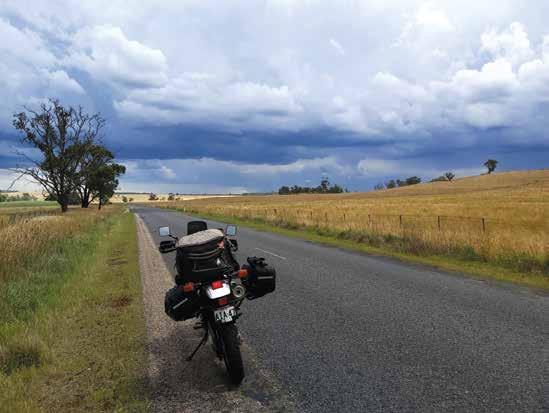
the now derelict National Oil Proprietary Limited’s refinery at Glen Davis and factories at Lithgow. Listed as a National Engineering Landmark, it was a first in many regards. The total length of the pipeline to Glen Davis was 105km, and it now supplies water to Mount Piper and Wallerawang power stations, as well as some parts of the Blue Mountains. Stocked with Brown and Rainbow trout, it’s also a popular fishing lake. Riding out of town, locals looked at the sky as they crossed the road. Maybe they knew something.
Fun guy
We stopped at Black Springs for a lunch break where a couple of cars were setting up their camper trailers against a backdrop of giant pines in the rest area. Nearby, a monument had been erected in honour of Charles Throsby, who, with his party, discovered the area in 1819 while
paving a way from Camden to Bathurst. In 1821 James Meehan surveyed and marked a track from present-day Taralga through Porters Retreat to the source of the Campbells River. For a flea speck on the map, it is steeped in history. I only knew it from childhood family weekends foraging for pine mushrooms, camping in the pine forest and looking for sapphires along the tracks.
Taken by storm
With the skies getting darker and the temperature dropping, we headed toward Goulburn. I let Rod go ahead as I wanted to stop with the camera every now and then. It’s a straight road with no towns before Taralga, and not far past the snow-warning sign, the roadside and ground under the pines began to turn white as small hail stones plummeted from the sky.
It wasn’t snow, but it was still a great sight.
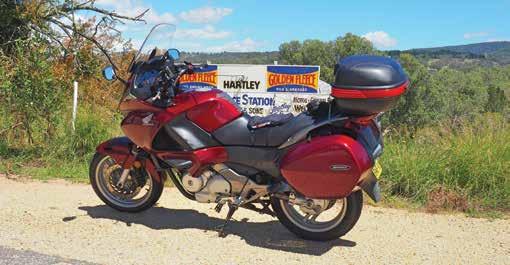
Left: Storms are spectacular. Watching and hearing them move over a valley can be thrilling.
Below: Rod’s Honda made for a comfortable backroad’s cruiser.
Right: A sign warned of poor road conditions for the next 46km.
The hail didn’t last long and I met up with Rod at an intersection a little further on as he pulled on his wet-weather gear. Ahead, dark clouds were building and rain fronts swept to the east. Jethro Tull’s song Broadsword came to mind as I rode into dark clouds.
I see a dark sail on the horizon
Set under a black cloud that hides the sun. Bring me my broadsword and clear understanding.
Bring me my cross of gold as a talisman. Get up to the roundhouse on the clifftop standing.
Take women and children and bed them down
Pulling over near Porters Retreat to take some holiday snaps, the odd flash of sheet lightning was followed by a deep throng of thunder rolling in the hills around us. I don’t know why I get excited riding into storms. Some get an adrenaline hit riding in and some get an adrenaline hit escaping. Storms are spectacular. Watching and hearing them move over a valley can be thrilling.
I wondered how much of the landscape had changed since James Meehan, Charles Throsby and Co walked along the same ridge.
Chilled
Visibility dropped to less than 50 metres as we rode into the clouds. Road markings disappeared in the low light and I kept a watchful eye on my mirrors to ensure I allowed any cars to pass. I also scanned the road in front for skid marks.
The sleepy town of Taralga was shrouded in fog as I rolled in. For a midsummer day, the town looked to be in midwinter. Rod’s bike was parked opposite the Taralga Hotel and he was waiting with a beer on the veranda. Music from the pub’s sound system filled the top end of town and created a welcoming atmosphere in the deserted street. In a short space of time the temperature dropped from the mid-30s to eight degrees, something I’d never experienced.
Shivering from the cold, I looked for an open fireplace for warmth – even a hot
kettle would have sufficed – as we shared stories of what we’d seen, and in some cases, not seen.
Mist it
The road to Goulburn was cloaked in thick fog and riding through it reminded me of playing a 1980s arcade game where all you saw was the side of the road and nothing else. Sitting in a truck stop at Marulan enjoying a hot roast meal, we compared notes of what we’d seen and experienced.
It’s amazing how quickly we adapt to riding conditions. Riding is about a frame of mind, being calm even when curveballs are thrown at you, having foresight to prepare for weather change and experiencing four seasons within a few hours (remember what your mother said about taking a jumper? My mother rode a BMW in Poland).
Ride with good companions – those who will look after you as much as you keep an eye out for them. You don’t need to sit on each other’s tail the whole way. On some stretches, keep an eye on their headlights in your mirrors or their taillight up ahead. If you see them pull over, it’s usually for a good reason. Pull over and check they’re okay. Watch to see if they’re meandering due to fatigue, tyre issues or anything else. On other stretches, let them loose. You’ll know where to find them.
As a day ride, 460km, 12 hours, four seasons and taking in some history, you can’t get better than exploring west of the Great Divide.
Once you get back, check out where you’ve been…just to give you the excuse to return.

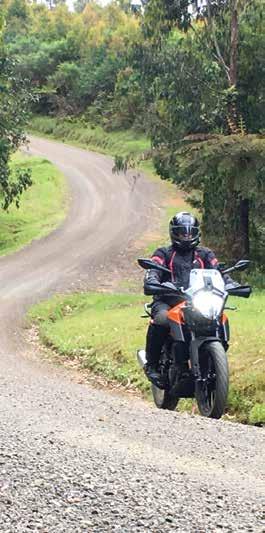


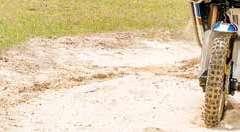




Adventurecorn Project
Chris Bostelman went on the quest for the ultimate lightweight adventure bike using only Australian parts and suppliers. The unicorn of adventure…the adventurecorn.
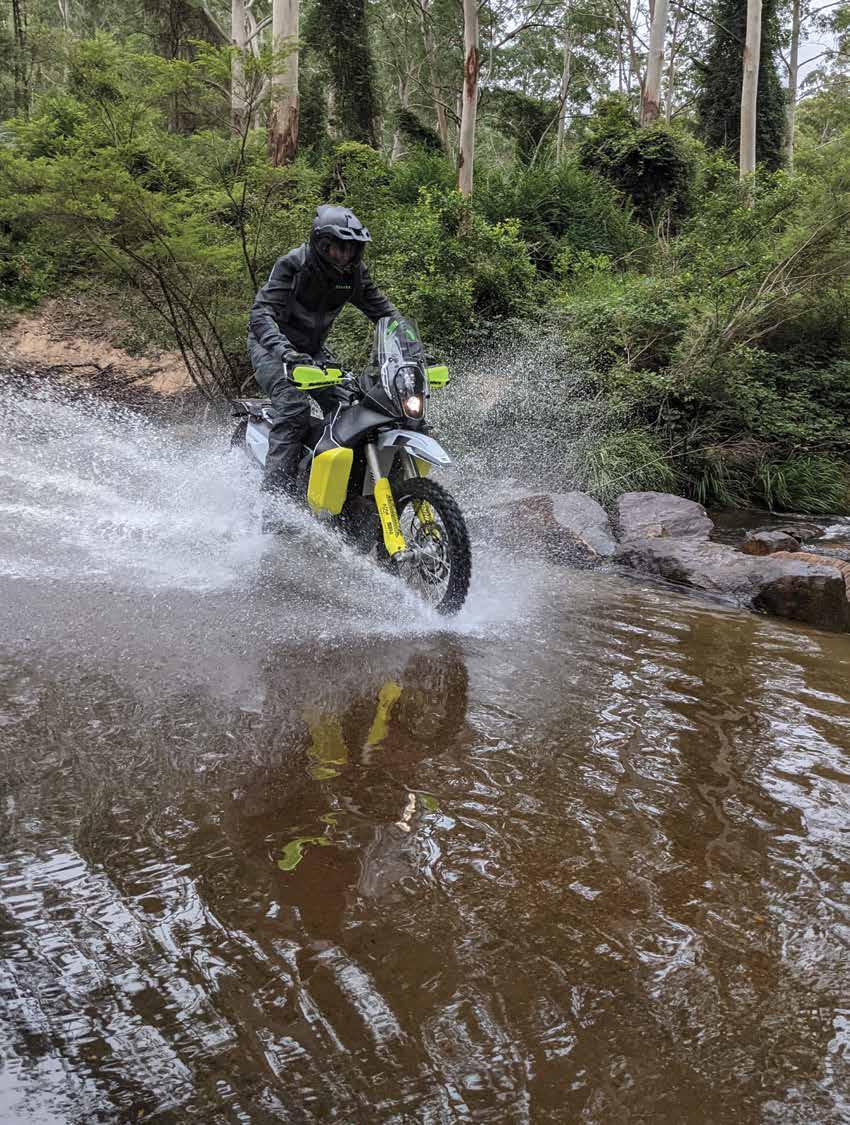
Lightweight, powerful, good fuel range, good suspension, good lighting, can carry enough gear for a desert crossing, some wind protection, enough space for nav gear, comfortable enough for long road sections, ABS, cruise control… the mystical, magical and majestic ‘adventurecorn’.
Who wouldn’t want a bike with endurobike manners and adventure-bike range?
Husqvarna’s 701 LR had hit the international market and at approximately 155kgs, and with 55kW of grunt and a fuel range of over 500km straight out of the box, it made a great starting point. When the project started Australia and the rest of the world was coming to terms with a raft of changes in 2020. Businesses closed, people lost or stopped work, shipping and freight went haywire, materials became hard to get and production slowed. In many cases, production stopped completely.
A big shout out to Ultimate Husqvarna in Springwood, Queensland, for finding and supplying a bike during these unusual times.
Buy local
The challenge was to create this mythical adventurecorn beast starting with the Austrian bike, but with only OEM or Australian hardware.
Although it seemed a simple concept, the availability of the parts needed without going overseas was a possible concern. As it turned out there were a lot of amazing Australian-made products available, and every one of the contributors went out of their way to support this all-Aussie-products build. Most of the components were supplied within a few months.


An interesting side effect of the COVID19 crisis – once consumer confidence improved and toilet paper was back on the shelves – was international travel budgets were diverted to domestic travel and toys. Australian motorcyclerelated businesses couldn’t keep up with demand and manufacturers found it a real challenge to get raw materials. What’s more, the export market opened up more to Aussie products. Being involved in the design and manufacture of the rally fairing kit used here, saw up close complexities with materials, prototyping and manufacturing made more difficult by COVID19 complications. It took serious perseverance in tough times to end up with this cracking Aussie product. Bolting on all the parts was a breeze and the fit and finish was world class.
Here’s a rundown of the great Australian parts fitted.
B&B Off Road products
The quality of B&B gear is excellent, the finish is great and the fit perfect.
I went with the black PPA coating to match the bike’s colours. I’d also found in the past that touching up anything black in order to keep the bike looking fresh was relatively easy. I’ve done over 50,000km of true off-road riding on previous bikes fitted with B&B gear, and I believe in the products. I’ve had a chain
break in anger and the B&B case saver did exactly what it was designed to do. I could pull the bunched-up chain back out and put in a temporary link to get going again. Without the case saver I’d have incurred significant cost for repair and the major inconvenience of a remote breakdown.
The B&B skidplate has also proven its worth time and time again. There are moments for all of us where we run out of talent and without good protection the ride can stop unceremoniously.
The rear rack is the perfect size for a decent tailbag or duffle and is very well made. I typically carry between 10kg and 15kg on the back, so a well-engineered rack is a must. Anything B&B is money well spent.
MCCruise cruise control
The MCCruise team has developed a simple-to-use, CANBUS-friendly, rideby-wire cruise control. This homegrown system is available

Top right: Black, PPA-dipped B&B Off Road skidplate.
Left: B&B Off Road case saver. It works.
Right: B&B Off Road rear rack. Strong and good looking.
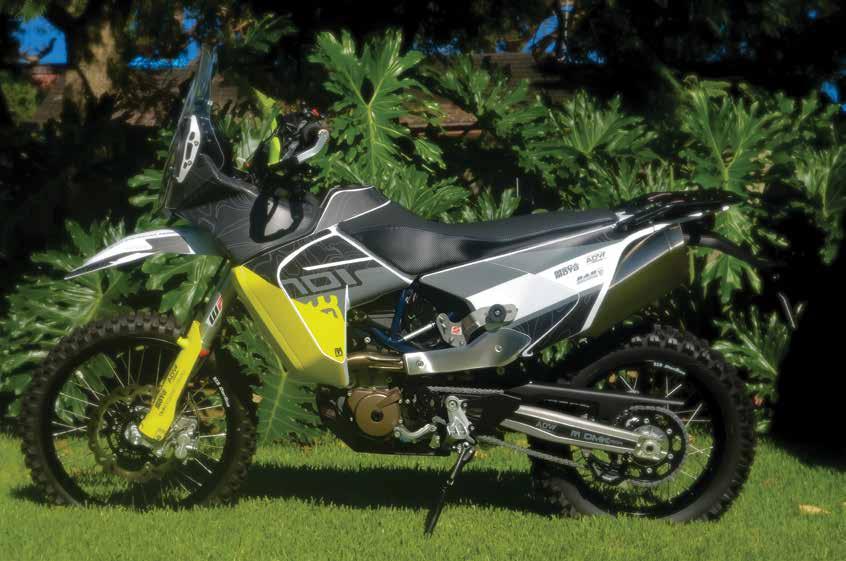
for a wide range of road and adventure bikes and makes long road sections far less fatiguing. Speed adjustments are simple and intuitive, and the buttons are backlit for use anytime. Installation was easy. The instructions were great and it’s slightly more detailed than plug-andplay, but not by much, thanks to the excellent install video and quality written instructions.
There are three handlebar switchblock options available to suit any bike setup. I’ve used the slimline switchblock as it fits in the tiniest of spots.
Being fitted to an adventure bike, it’s good to know if there is ever an issue

the system is easily bypassed to return the bike to its normal operation. Cleverly, there’s also a self-diagnostic function integrated with the bike’s CANBUS that helps decode a problem by using flashing light sequences on the handlebarmounted switchblock.
Steg Pegz
If you haven’t used Steg Pegz you should really try them.
I stand up most of the time when riding off road, and the fatigue reduction and increased level of control make these a must in my opinion. I never really appreciated the difference they made until I rode a friend’s bike which had a pair fitted. I now have these on every offroad bike. They’re a really nice piece of kit and fitting them is a breeze. Adjustments can be made to the black circular Pegz easily with a single tool as the bolt through the puck is captive in the slot at

kit or to have DMK Designs do a custom kit and trick up your own bike. It’s the best sticker kit I’ve fitted to any bike and I love the matte finish over the full gloss most commonly seen.
Barkbusters handguards
Everyone who’s been riding bikes for a while is familiar with Barkbusters. Beyond the strength and protection provided by this system, they look great. There are some fantastic new handguard colours and there’s a really great range

Above: Barkbusters VPS
Right: MSC Moto gear looks trick. The top brace stiffens up the wide ’bars and the damper is super adjustable.
of end weights, end caps, running lights, blinkers, and the handguard styles themselves. My choice from the range was the VPS guards. My two favourite parts of this system are the wind deflectors which can be easily adjusted for summer and winter, and the neat black skidplate set at the end. We all drop the bike occasionally and replacing the skid plates is far better than replacing the whole plastic handguard. These really are good looking and cost-effective protection for riders’ hands and levers. This is the tenth bike I’ve

fitted these to, and for me they’re an off-road must.
Ralle Moto steering damper
MSC Moto has created the Ralle Moto series of steering dampers specifically for adventure bikes.
Beyond the dampening of handlebar movement and resulting increase in bike control, this kit also lifts the ’bars and opens up the cockpit of the bike nicely. Then there’s the ’bar brace. You can feel the difference when you have wide
u
the rear. It’s another example of a great product and Aussie ingenuity. They’re simple to use and a really effective way to improve bike control.
DMK Designs sticker kit
Jack at DMK Designs has created an awesome-looking sticker kit.
The quality of the vinyl and adhesive makes the install so easy. If it’s not right first go it can simply but carefully be removed reapplied.
This is a custom kit and all the complex shapes of the LR took some time to create. DMK Designs can now supply a 701LR kit off the shelf. Contact the team to order a

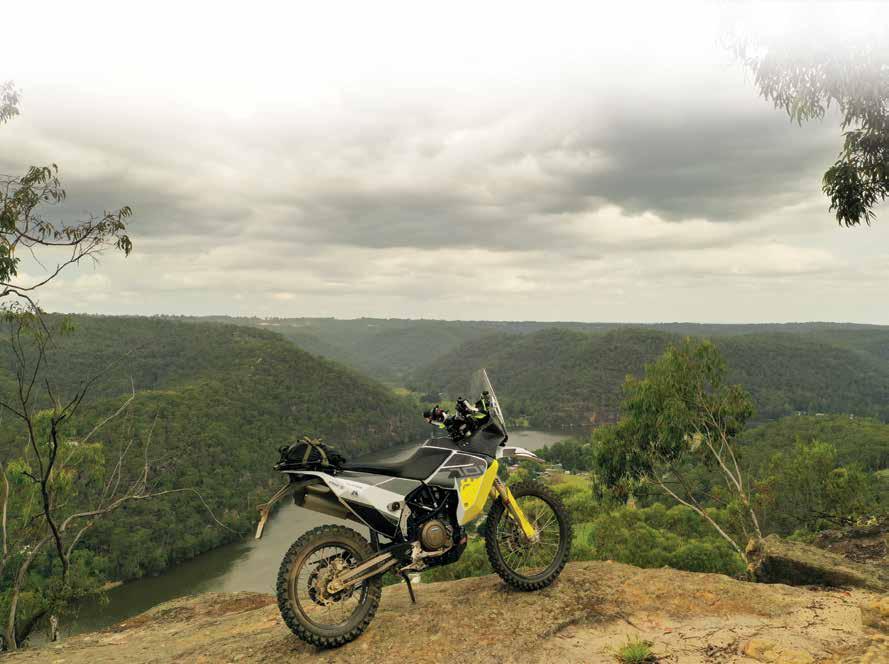
Top: Adventurecorn: the ultimate lightweight adventure bike?
Left: The MCCruise slimline switchblock is simple to install and use.
Right: Steg Pegz are a really effective way to improve bike control and reduce fatigue.
Left: DMK Designs sticker kit for the 701LR with Yenkro rally fairing.
handguards with skid plate.



handlebars and it’s sexy as. The damper and the ’bar brace combine as a system and really add to the rally-bike feel. Everyone who has seen and ridden this setup loves it.
I met the family team at MSC headquarters and was amazed at the machinery shop set in a rural area. It’s keeping jobs and Aussie manufacturing local and the quality of the products is truly fantastic.
I was only told yesterday about a friend with an eight-year-old MSC damper that needed a rebuild kit and the only cost to him was to cover the shipping. It’s a great product and MSC gives excellent customer service.
Yenkro adventure rally fairing kit
The fairing design started with cardboard and then plastic mockups to attain the basic shapes. This quickly turned to CAD and 3D printing. It’s easy to say that in two sentences, but the time and effort it took was considerable.
The clear screen is Australian-made high-impact acrylic. You can literally tread on the screen until it’s flat and it will return to its shape with no cracks. The screen sits on posts, so no tools are required to remove it, and the side panels work the same way. During a crash the parts can pop off without major damage. That means it’ll all clip back on and make it home without needing significant repairs.
In case you’re wondering, this fairing has been torture tested on some of Australia’s worst goat tracks without a hitch, all while obeying the border restrictions. Honest officer!
There are two size options for the screen, which is a nice touch. I’m taller than average so I prefer the taller screen option.
The Yenkro rally kit comes with a blank dash. There’s a generous mounting space for customisation, from mounting a full rally roadbook to simply adding RAM or phone mounts. There’s even enough room to mount a seven-inch tablet. The wiring is plug-and-play and will connect directly to the bike’s OEM wiring harness. There’s also

several headlight options.
The way I’ve set this tower up is to have ample – as Jeremy Clarkson would say –‘power’, with two USB charging points and a merit socket split across two circuits. Additional power is available from two SAE connectors, one switched and one with permanent power, and an EC5 connector for jumpstarting duties. You do need plenty of reliable power to run all the electronics we drag along on our adventures.
Team effort
Material selections, prototypes, manufacturing processes…the list of variables is


Left: A great bike to start with, the 701LR is an excellent platform for personalisation.
Right: Austria and Australia combine to make an awesome adventure bike even better.
endless and the level of detail required was amazing. Every Australian product on this bike build has been through the same extraordinary journey and the behind-the-scenes work has resulted in very high quality.
For me, this is the ultimate lightweight adventure bike. It has the creature comforts to make it a pleasure to ride and lots of space for nav gear. It also has plenty of power, great fuel range, the best standard suspension on the market, good wind protection, cruise control, ABS, quick shifter, good lighting, it’s lightweight, has good gear carrying capacity, has two fuel tanks and two fuel pumps, ride modes, and traction control.
So that’s the recipe I’ve used to create my ultimate Aussie-parts adventure bike. A huge thanks to everyone who has helped with this project.
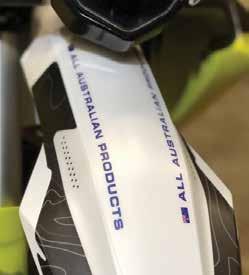
Barkbusters.net
Yenkro.com
MSCmoto.com
MCCruise.com
Stegzmoto.com.au
BBoffroad.com.au
DMKdesigns.com.au
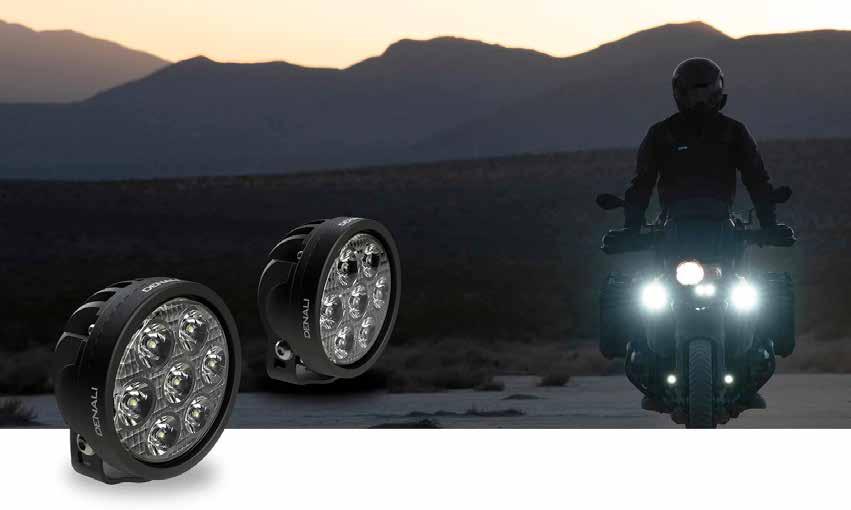

Left: Who doesn’t love a bit of CAD work? Middle left: Mockups help set the basic shape. Bottom left: Prepping the mould for the tower, the heart of the rally kit.
Right: The Yenkro adventure rally fairing on the 701LR. Bottom right: The multifit rally fairing with optional 701LR side panels.











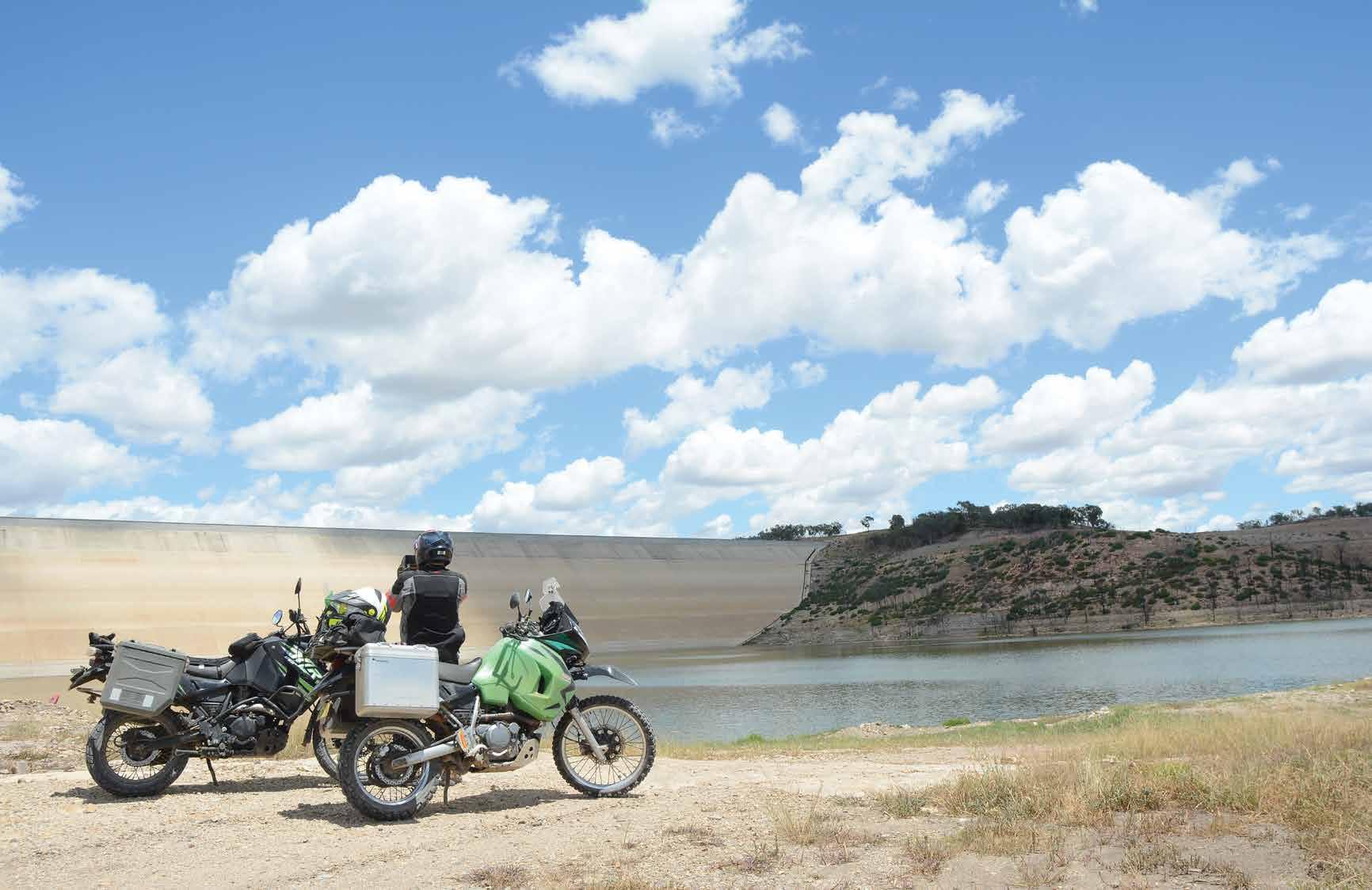
Dam. Dam. Dam. Dam. And
a museum
The Mac Attack and Adventure Rider Magazine’s editor were a little anxious for both riders and both bikes to finish a ride.
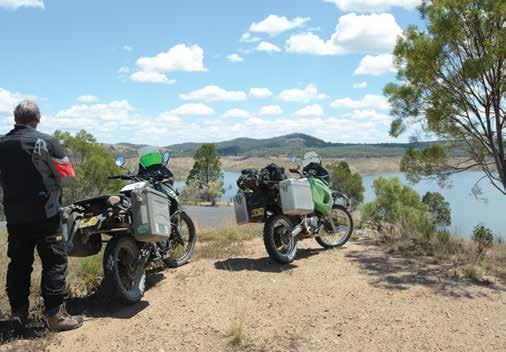
reckon we could see four dams in a single day,” offered The Mac Attack in his usual quiet and considered way. “And there’s a motorcycle museum in Tamworth. We could try and make it around all four dams, stay overnight in Tamworth, see the museum in the morning and be home before dark.”
It sounded good to me.
But I knew where we were heading… “Excellent,” I nodded knowingly before quickly blurting, “and it’s your turn to navigate.”
Ha!
That stumped him.
First in, best dressed. That’s the rule. I was ready to put my feet up and spend a couple of lazy days following Mac and wondering what might go wrong with the KLR this time.
The story so far Mac and I had become good riding mates over the past few years. It started in 2016 when I’d just launched into a secondhand KLR. An ad came up somewhere saying someone nearby had a few KLR parts for sale, and as I stocked up on radiator hoses and other bits and pieces it became clear Mac – the bloke selling the parts – and I had plenty in common. We went on a few rides here and there and, in a strange twist of fate, our normally totally reliable bikes seemed to come up with niggling little problems whenever the two were put together. Tyres blew, chains broke and radiators leaked.
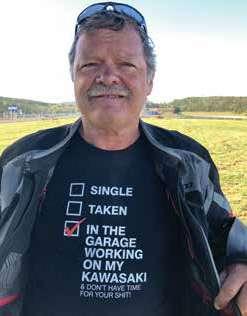
It began to feel as though running the two bikes together was a jinx.
On our last run out to Texas in Queensland both bikes had chucked hissy fits and the end result was Mac loading his bike on a trailer to head home for a repair on the first day while I carried on to put my bike on the same trailer to make it home a couple of days later. You can run through the details of that outing by having a quick look back at issue #43.
There was clearly some bad juju going on, and it was time to put a stop to it. A ride was planned that wasn’t too challenging, but wasn’t too soft either, and the whole aim of the thing was for both bikes to be trouble-free. That, and to get in a ride, of course. And there was gear needed assessing,
u
Left: An engineering marvel and well worth risking serious injury to see.
Above: The view from above Pindari Dam wall wasn’t majestic enough for The Mac Attack. He wanted to get up close and personal with that concrete.
Right: The international-playboy exterior hides a core of steel.

so it was work as well. Mostly work, actually. The more I thought about it, the more I realised I was once again being forced to go riding.
Serious stuff
Mac had volunteered to run the XAM chain-and-sprocket kit. The guys from White’s Powersports were keen to know how it performed in the real world and what sort of longevity could be expected. Mac’s bike was the perfect test unit. When it comes to long rides and lots of them, Mac’s The Man, and no one lives more firmly in the real world of a shed full of old bikes and a huge stock of second-hand KLR spares. He also had a very schmick-looking Rad Guard which he insisted in pointing out and reminding me I didn’t have one of.
He looked pretty smug about the situation alright, until he emerged from his telephone booth at the Ebor servo and I ripped off my new DriRider jacket to reveal the Alpinestars Tech-Air 5 which formed itself to my rippling torso. Ha! Didn’t that make him take a step back!
With both of us feeling the pecking order had been well-and-truly established, but probably with very different ideas about how that order stacked up, we headed off to hit our first target: Pindari Dam near…somewhere. Having nominated Mac as navigator I didn’t have to pay a lot of attention. I know we went through Glen Innes, and I know it was frigging
warm when we arrived at the base of a very impressive concrete barrier.
All downhill
The view from the lookout above the dam wasn’t bad, but Mac is a dyed-in-the-wool adventurer, and the sight of a few tracks in the valley beneath the dam wall were more than he could stand. In short order I followed the bucking black KLR down a bucking rocky hill, hoping like hell there was an easier way out.
Once at the bottom we travelled along a series of open, smoothish dirt trails to find ourselves underneath the wall, and it was a sight well worth the effort of getting there…if you’re into dams, y’know. Engineering masterpieces and all that.
I was struggling a little to concentrate on the grandeur of the dam because, although Mac seemed fascinated with the whole thing and began reciting some interesting facts about the construction methods and capacity, I couldn’t help but think we hadn’t seen any easier ways up and out of the location.
Sure enough, when we hooked the bikes around and headed back Mac pointed his KLR at the rocky uphill, gave it the berries, and went for it. What could I do?
I gave the Touratech KLR throttle a limp-wristed quarter of a turn, shut my eyes, went to my happy place and hoped like hell everything would be okay.
Mac’s debonair and carefully groomed appearance hides a gritty and determined
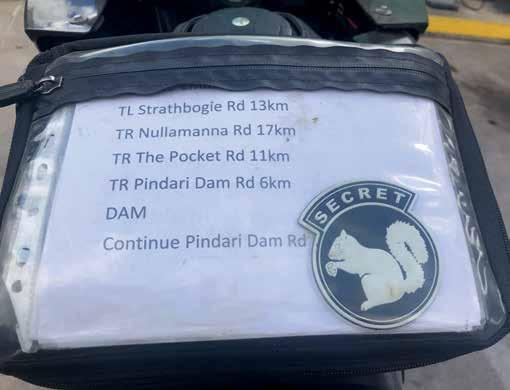
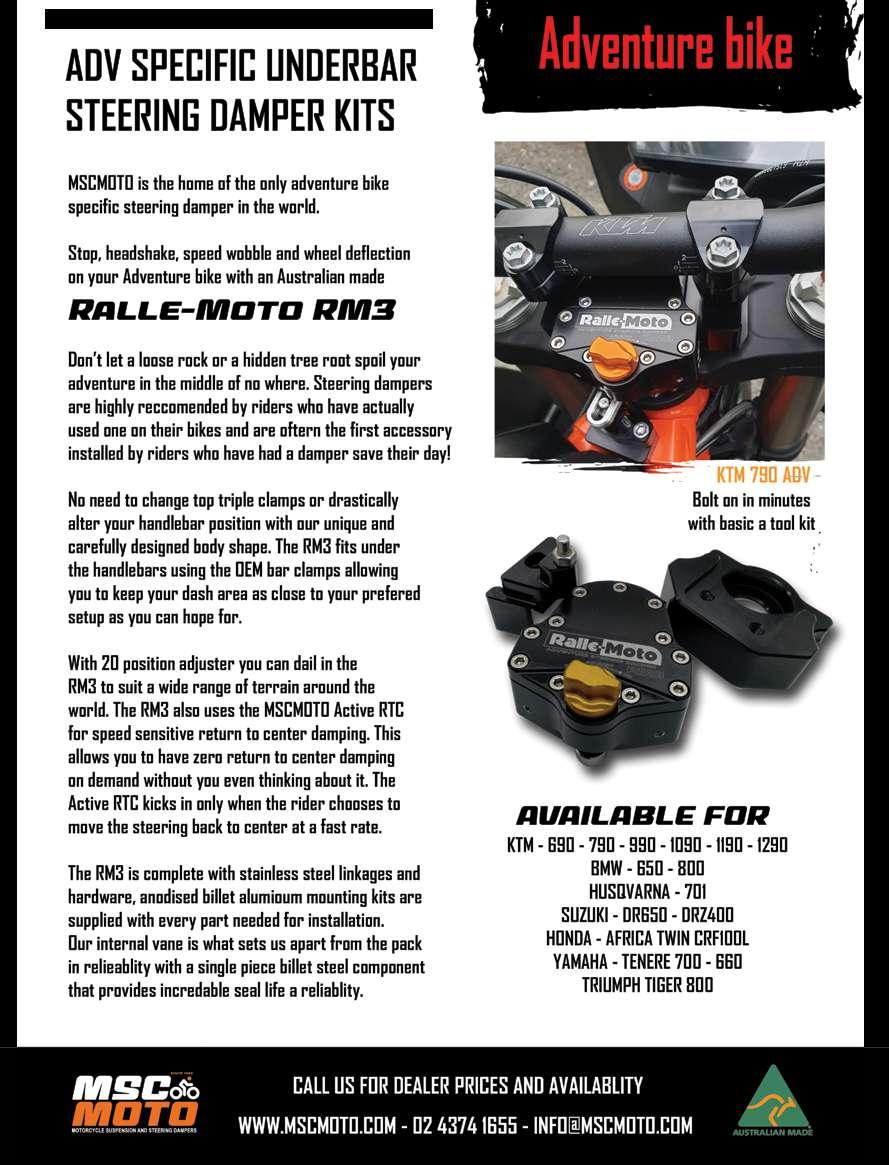
Above: Good ol’ Copeton Dam. It’s a Congregation favourite.
Right: Ah…that squirrel is the marker for a great memory…
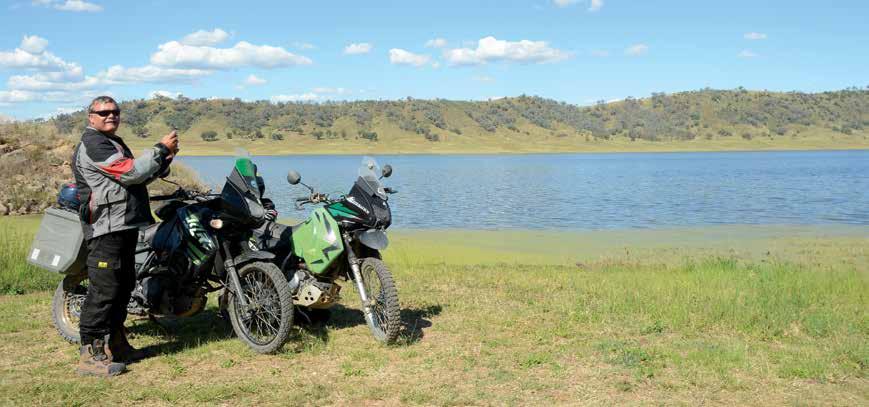
interior though, and when I finally came back from my mental panic room we were back on level ground and had ticked off dam number one.
Both bikes were running like champions and we were off to a great start.
Next!
After Pindari was Copeton Dam, and for once I knew what to expect.
Copeton is a popular tourist stop for visitors to Inverell and Green Valley Farm, so I’d been there often enough. As we stood there looking down on the familiar panorama I wondered out loud whether we’d be heading down beneath the dam wall again. I knew there were plenty of smooth four-wheel-drive tracks criss-crossing the landscape, so I was looking forward to it.
But the thought of having to pay a fee at the tourist park to get into the area
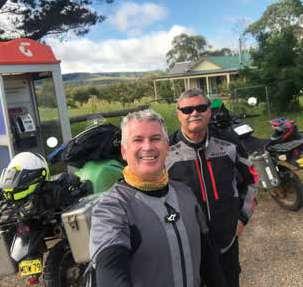
turned us off a bit. Mac didn’t achieve his international playboy status by carelessly throwing legal tender at avaricious hospitality concerns, and he’s a good example to us all.
The panorama of Copeton Dam was enjoyed from the free lookout above the wall, and it was worth every cent.
The ring in
Originally the plan had included three dams,
Above: Split Rock Dam near Manilla had easy access to the waterline.
Below left: Mac’s phone-box waiting room at Ebor. TF thinks he’s just won the pecking-order face off thanks to his Alpinestars Tech-air 5. Mac looks smug because he’s sure he’s top dog with his new Rad Guard and White’s Powersports chain-and-sprocket set.
Below: Look at the dirt on that new chain and those new sprockets! Disgraceful.
Below right: Ooo…a shiny new Rad Guard. Maybe that’s why there were no problems for Mac this time around.

but Mac, with his usual thoroughness and attention to detail, had found a fourth he thought we could include, so we headed along some really nice country bitumen to Manilla and out to the reservoir.
Split Rock Dam turned out to be a sizable outfit, and, best of all, there was a good dirt road leading down to the water’s edge. The KLR’s scooted along through the dust and loped over the grassy banks to get down beside the water to be included in pics which… well…looked like pretty much every other pic of a couple of KLRs beside the water somewhere.
But it was good riding, and both bikes were going strong.
Like their riders, really, even though I was thinking a cold drink would’ve hit the spot.
As the afternoon careered away from us, Mac gunned the KLR and headed off

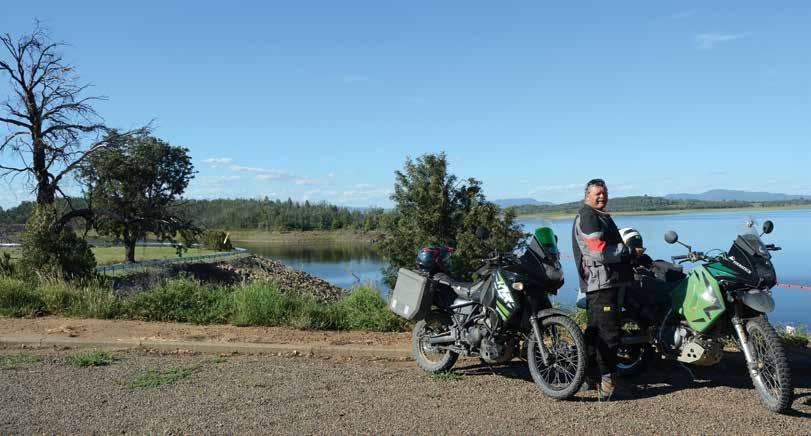
in the direction of Keepit Dam, our last target for the day.
Keepit going
According to the official literature, Keepit Dam is ‘a major gated mass concrete gravity dam with an earth fill abutment and a central gated concrete overflow crest and six radial gate spillways across the Namoi River upstream of its junction with the Peel River’.
As jolly fascinating as that sounds, it was a frigging long way out there to see it, and while both bikes were going like steam trains, it was a bit of a bitumen drone.
Still, we rolled into the viewing area and, as indicated, viewed. We saw a large body of water and another damn wall. Awesome.
The run back to Tamworth was 55km or so. That doesn’t sound like much, I know, but when you’re riding with your fingers crossed it’s a fair old distance. Both bikes were living up to the KLR reputation. They were comfortable, gobbling up
Above: By the time Keepit Dam emerged the fascination with man-made impoundments was about shot.
Right: George’s Campground on the Old KempseyArmidale Road was glorious, as always. So was the ride down the mountainside.
the distance, and looking as reliable as a Kardashian with a camera and a selfie stick. I didn’t want to put a hex on that. At a very friendly motel a quick onceover showed both bikes in tip-top condition and, with that comforting thought we unloaded the after-dark gear to find I’d forgotten to pack some kind of footwear. That wouldn’t normally be a problem, but my attempt to trek barefoot to a nearby fast-food outlet had my feet impaled on bindies roughly the size of javelins – much to Mac’s amusement. His amusement was heightened when we
arrived at the eatery and I’d left my phone at the motel thinking I wouldn’t need it. The only way to sign in to the eatery was with a phone, and I said it wouldn’t matter because no one ever checked. Mac did the rightie and signed us both in. It was a near miss, because at breakfast the next morning at the same place –when I had remembered to take my own phone – a Covid Queen in her little vest and nameplate came over and asked to check our phones to prove we’d in fact obeyed the law. I held my head high and said, “Of course!”


Only irresponsible jerks wouldn’t sign in.
Old time
After a very comfortable evening we loaded up and headed to the Powerhouse Motorcycle Museum on the edge of Tamworth.
Actually, it’s part of the Powerhouse Hotel, an establishment big enough to deserve its own postcode and well above the style of accommodation a couple of financially challenged KLR owners could afford.
We eased in through the door to be met by the curator, Bill, a knowledgeable and gregarious sort of fellow who loved a chat. We tried to pay our entry fee but he insisted we have a look around while
he spoke to some other people who were already there.
As we wandered through an absolutely gorgeous collection of beautifully presented bikes – all the time expecting to be invited to exhibit the KLRs – and offering to pay the entry fee each time we completed a circuit, the time slipped away. Before we knew it it was time to tackle the final leg of the journey and hopefully lay our DNF curse to rest.
The wind blew hard as we powered through the sunshine toward the famous Waterfall Way, our endurance not even vaguely tested as we pulled in to say hello to Matt and Claire at Ural in Uralla, and then ran down the incredibly beautiful old Kempsey-
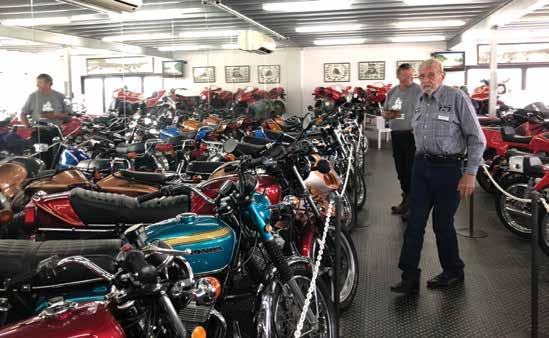
Armidale Road. Mac had never ridden the heavenly mountainside home of rockfalls, and it felt good to be able to share such an amazing section. George’s campground was its usual glorious self and before long we were at Willawarrin shop looking at a staggering collection of motorcycle magazines before a bitumen run home.
And that was the best bit.
The hoodoo was broken. Mac had covered something like 1500km and I’d probably done 1200km, and both bikes had been faultless. Not a doohickup or a leaking radiator or a rock jammed down between an engine case and a case saver to cause an intermittent fault (the problem with my bike last time).
Neither bike even took any oil! That has to indicate some kind of divine intervention.
So now it’s on: it’s time to tackle something really big.
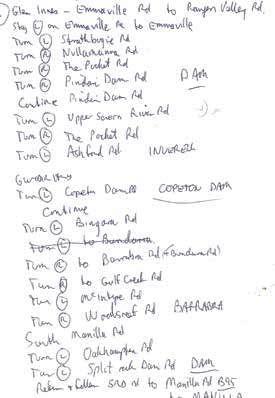
New 2021 Merchandise







Top: By this stage of the day any dam wall was given a quick glance at best. ‘Beauty. Seen it. Let’s go’. Cold drinks and dinner were waiting. Left: Curator Bill at the Powerhouse Motorcycle Museum met his match when he went head-to-head with Mac on technical points of old Triumphs. Above: A free subscription to first person who can correctly interpret Mac’s routesheet. He didn’t make a single wrong turn.

dreamin’ Map
Andy raises the middle digit to digital.
ost of us are from a time when mapping was done with a sextant and a bloke with a three-cornered hat standing on the prow of our boat.
There’s nothing quite like a map spread out on a table to whet the appetite for a big ride. ‘Maybe this road?’
‘Maybe that track would be right for the group?’ ‘Maybe we could get through this way?’ ‘Ending up at this campsite by that river looks the goods!’
The smell, the crinkling of the paper, the ritualistic folding…the reverence. Local information centres are a great source of maps. They often have brochures and the like with neat little maps to tear out.
Oh, there you go…
Those of you who treat a sheet of paper with a map on it as if it’s a lost copy of Jimmy Cook’s original, get over it. Frame one and use another if you must. You can re-fold them to have the current panel on display without upsetting the gods of 50-weight. Strutharama! You can even write on them if you want to. They cost less than a round of beers.
The fun of the debate over which way to head the next day, huddled around a map on a camp table, beats the slavish, automatic response to some digital frustration box.
Paper maps contain so much more information about things to do, see and avoid. They allow trip planning rather than just route planning.
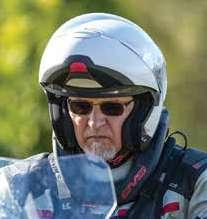
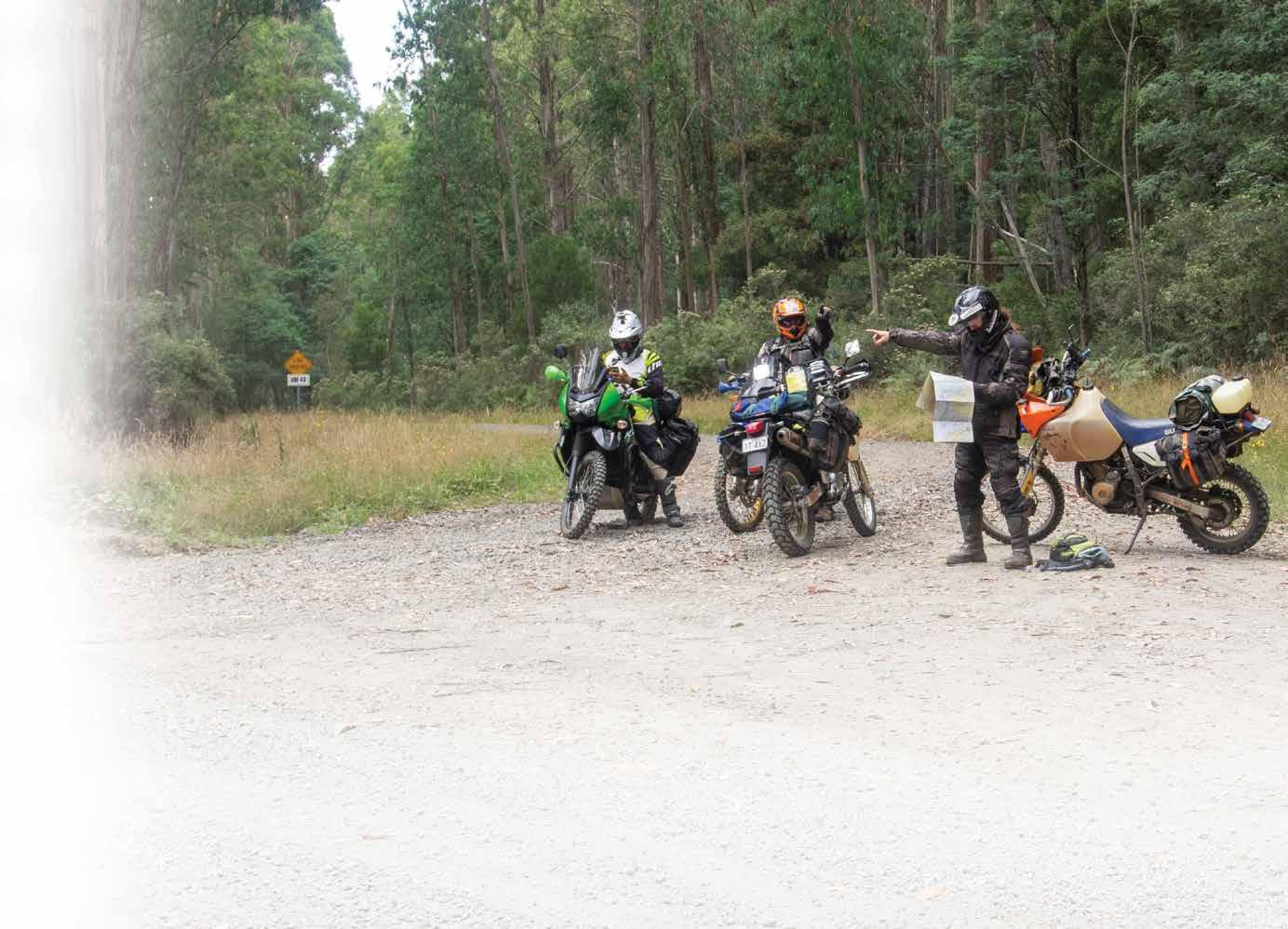
Programming a ‘Get Lost Box’ (GPS) just doesn’t have the same romance and anticipation. I’ve never liked the things; they involve a rigid plan and route and usually get a flying lesson across the room. A demanding arrow on a screen and some bint telling me to do a U-turn at my earliest convenience doesn’t help. I lost confidence in the bloody things when crossing the Nullabor and was continually told to turn right or left onto the main road.
I was on the main road. I was on the only friggin’ road!
The way I get anything out of them is to head off, get lost, then hit the home button. I’ve found some pretty trick rides that way, as well as a few closed gates and dead ends.
I get it, the old adage: ‘shit in shit out’ applies. Rubbish maps give rubbish information.
My ridings (like the polly speak –learnings) are often trips to negotiate a way to location A, B or C depending on the conditions and weather. Satellite-based maps on my phone perched up in the cockpit of the bike have become my go-to as I can change my mind from corner to corner. I get to make a choice.
Preparation for any significant ride is nearly as good as going. Poring over a map and dreaming is one of the really good bits of any ride! Yer can stick yer laptop where the pixels don’t reach! Oh, and when Rooftop maps say the track is steep…believe!
AnDy STRAPz
Left: There’s nothing quite like a map spread out on a table to whet the appetite for a big ride.
Below: The fun of the debate over which way to head.
Words and images: Andy ‘Strapz’ White
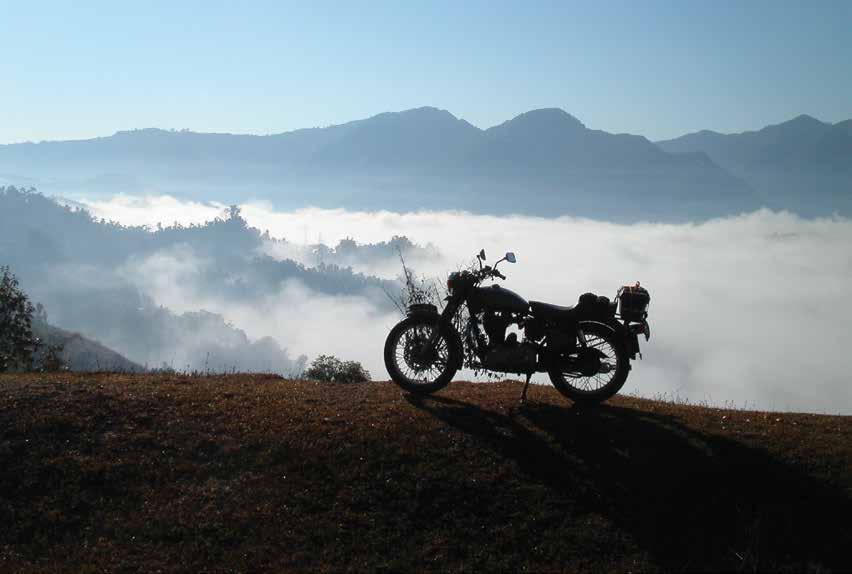
embassy car The
Mike decides not to drink and drive, but ends up in a fix anyway.
Words and images: Mike Ferris
Our early motorcycle safaris through the Himalayan kingdom of Nepal were traditionally run through the festive season of Christmas and New Year.
On our fleet of Royal Enfields, we typically started the tour with a few days in West Bengal in India, spending Christmas Day in the charming, high ‘hillstation’ of Darjeeling. We’d visit the local zoo, which is also the world breeding centre for the endangered snow leopard, and sample some local teas, for which of course Darjeeling is world famous. Then, in our preferred digs, the ever-sosplendid Elgin Hotel, we would be treated to a rendition of popular Christmas carols by enthusiastic young choristers from the local St. Joseph’s Convent

School. It was a real novelty in what was otherwise a predominantly Hindu and Buddhist culture.
Driven
Crossing the border into Nepal inevitably involved an arduous battle with notoriously officious bureaucracy before we could make our way to Kathmandu, over several days, in time for New Year’s Eve. During the time pertinent to this story, the Australian Embassy’s Charge D’Affairs in Kathmandu was a motorcycle enthusiast whom we shall call Laurie to protect his identity. Laurie owned and loved a Royal Enfield himself and had learned of our impending visit to his adopted city via our webpage. He’d contacted me via email and had extended our group a warm welcome to visit the embassy for an informal function (party!) on New Year’s Eve – an invitation I very readily accepted.
Our hotel in the city was several kilometres from the embassy and none of us wanted to ride or drive as it was rumoured there might be some alcohol involved in the NYE celebrations. The Australian ambassador was out of station on official government business, so in his absence Laurie was in fact the acting ambassador. He very generously offered the use of his embassy car and driver to collect us in two shifts (there were 14 of us) for transfer to the embassy, but advised we would have to find our own way back after the stroke of midnight had sounded. Fair enough.
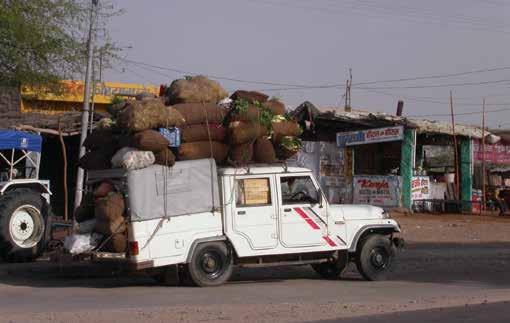
Standby
Bottom left: Early tours through the Himalaya were run through the Christmas season.
Above: Typical transport in the Himalaya.
Below: Home of the Royal Enfield.
Below right: Moo-ving on.
We enjoyed a splendid evening by the embassy pool, complete with the mandatory ‘Beware of Crocodiles’ warning sign. Australian wines and beers were served up at very pleasant prices, with cheeses, hors d’oevres and snacks aplenty. Midnight was seen in with an enthusiastic, if not exactly tuneful, rendition of Auld Lang Syne. And shortly thereafter, just before begging his leave to sneak off to his chambers, Laurie softened his earlier stance and said we were welcome to use the embassy car again to go home, if we could find the driver, if indeed he was still around.
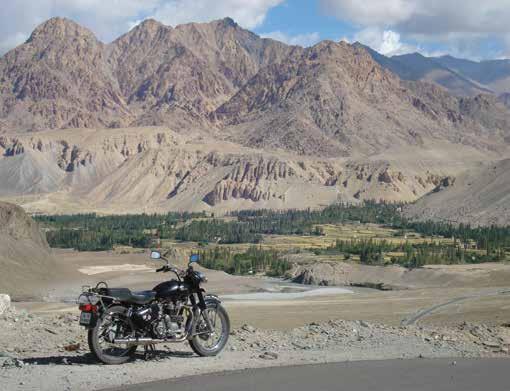

Opportunity
The hour was late and nobody wanted to volunteer to wait around for the second roster, so 14 rather intoxicated Aussies somehow managed to cram together into the car – it was a large 4WD, the kind which are often seen carrying extended Indian or Nepalese families. But then the driver, whom we suspected had indulged in a few celebratory drinks of his own, seemed to lose his nerve. He said, “Just one minute,” and disappeared into the garden. We assumed he’d simply gone to take a leak. We waited several minutes before a few of us went to look for him and we combed the grounds quite thoroughly. But he had simply vanished. We were at something of a loss as to what to do next. Then noticed the car keys were still in the ignition.
Our Indian tour escort, Amar, is a gentleman and a truly good friend. I looked at him and said, “Amar, you’ve not had very much to drink tonight, have you?” He smiled and rose to the occasion beautifully. He told me later he fully expected we wouldn’t make it past the guards at the embassy gate, but in the event they simply snapped to attention and saluted as we giggled our way out of the compound and into the New
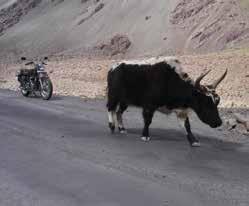
Top left: The Australian Embassy’s Charge D’Affairs in Kathmandu owned and loved a Royal Enfield.
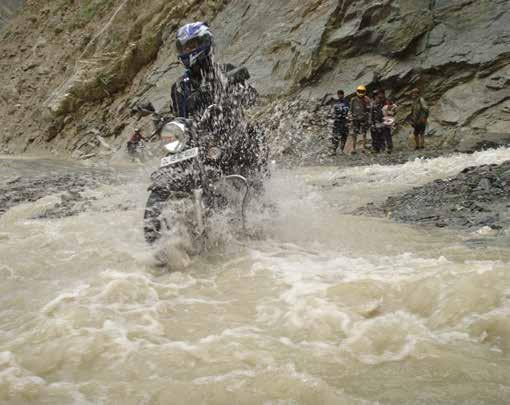
Year’s revelry of Kathmandu with a very inebriated Hindu Brahmin at the wheel. Only the next morning of course, with heavy heads and a touch of panic, did the full realisation of what we’d done sink in. We had misappropriated the Australian ambassador’s vehicle.
On the QT
I checked out of the window with trepidation and sure enough there it was, still sitting in our hotel car park glaring at me.
I rang Laurie’s number, and after a brief exchange of cordialities and an
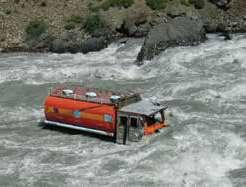
Left: That’s
Right top: The mountains certainly are pleasure with your leisure.
Right: The group found itself in a unique situation.
expression of gratitude for the evening, I said, “Now, um, Laurie, sir, we somehow have managed to find ourselves in something of a unique situation, with, err, a small problem.”
“Yes, so I have been informed,” came the diplomatic reply. “I don’t need to
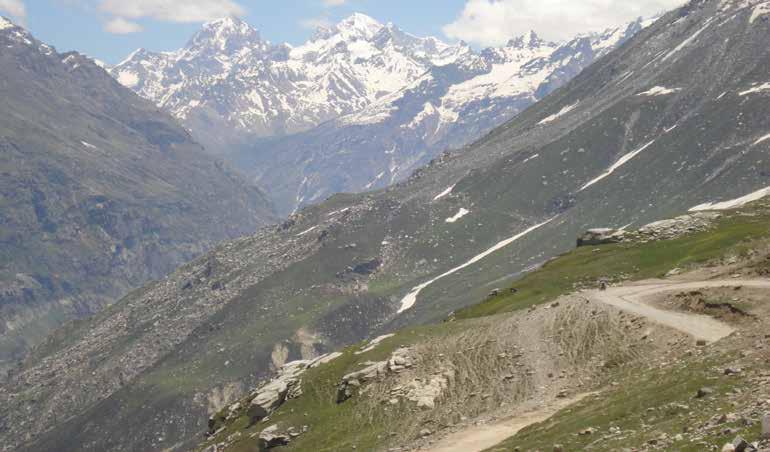
discuss this any further. Just take care of it quietly and put things right without any fuss, would you please?”
It occurred to me all embassy phone conversations were probably monitored and recorded, so the less said about a certain missing car, the better. called Amar’s room and a short time later he and I ignominiously drove to the embassy compound, handed over the keys to a rather ashen-faced driver and slunk back to the hotel in a taxi for a strong coffee.

The Yaks ’n’ Yetis Tour is one of the tours in the World On Wheels portfolio. Check out the website at: www.WorldOnWheels.tours

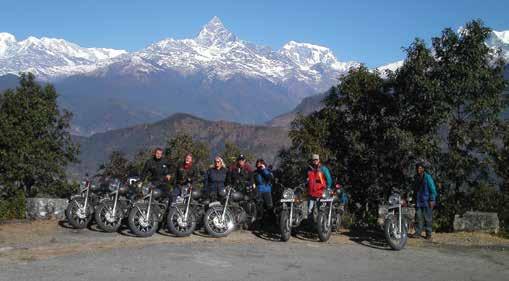






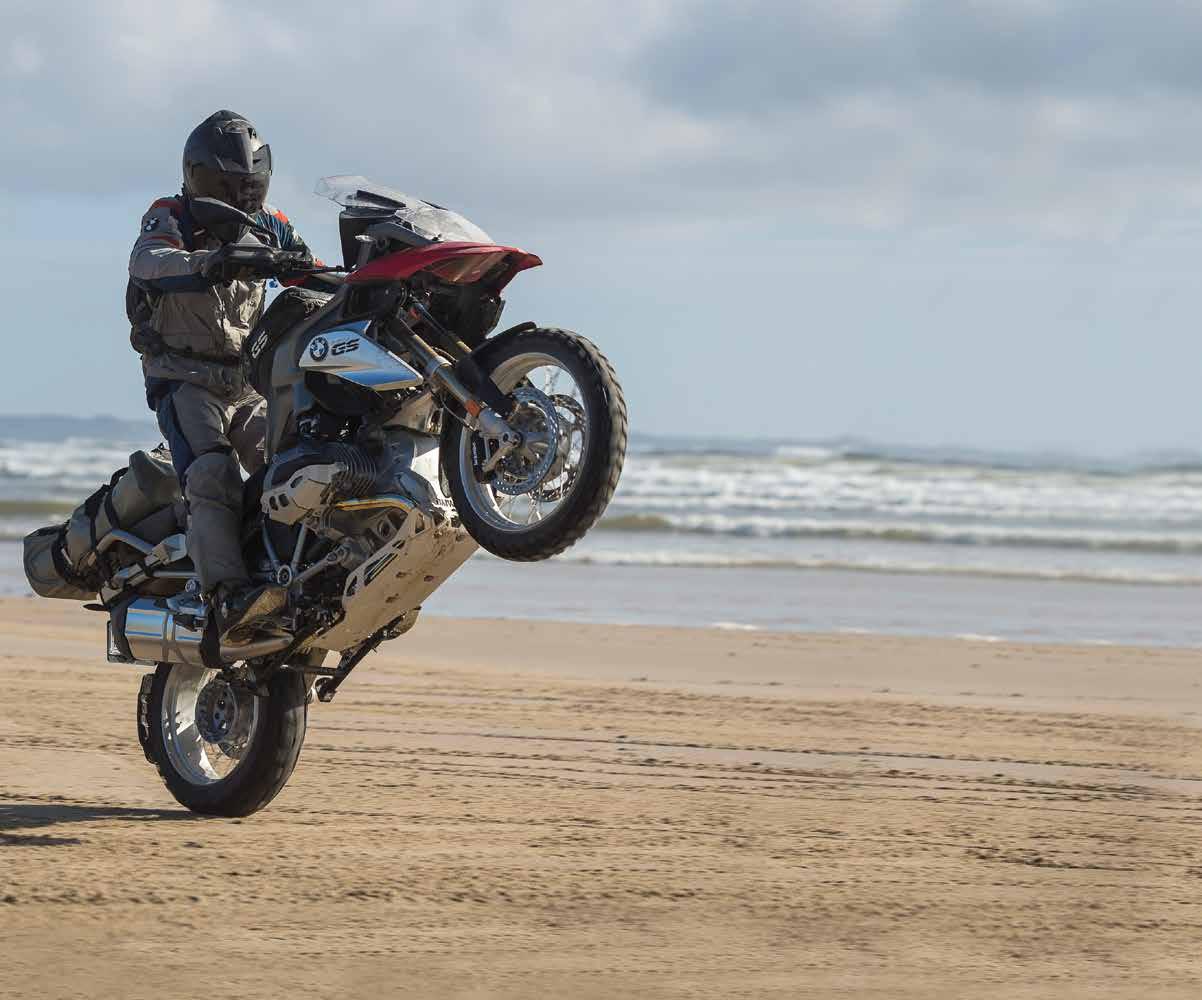
Finding traction
With a heading like Finding Traction you might think this story is going to focus on the best tyres to fit. Well, you almost couldn’t be more wrong. If you’ve read my stories regularly before, or attended a training course with me, you’ll know I firmly believe tyres are not the holy grail of finding traction off road. How many times have you seen a rider with a half worn out tyre get up snotty, technical hill climbs while riders with brand-new, aggressive knobbies get stuck halfway or crash trying? If some people spent more time focusing on their riding skills and less worrying about tyre pressures, I’m sure they’d be much better riders.
How do you find more traction?
The following points are crucial when it comes to finding traction in a whole range of situations, including hills, corners and braking:
v Line selection
v Body position
v Control use
v Suspension and tyres. Tick the box on the first three points and you are going to find bucketloads of traction compared to those who don’t.
Line selection
Where you put your tyres makes a massive difference to the traction you can gain. And the biggest part of line selection is vision – where you look.
In over 20 years of coaching off-road riding, motocross, enduro, adventure and mountain bikes, I can confidently say 90 per cent of riders don’t look far enough ahead. Instead, their vision bubble is confined to the area not too far in front of their front wheel. When coaching I put a lot of effort into improving this, because the gains are so big and so instant.
If you look further ahead, you see obstacles, low-traction surfaces, corners, hills, ruts, bulldust and other potential problems earlier. Look at the ground in front of your wheel and you simply aren’t prepared for the terrain ahead. The faster you’re riding, the futher you should look ahead to be prepared to adjust your speed and line selection.
Okay, so you’re looking further ahead and seeing terrain earlier, which is great,
but what should you be looking for?
Things like surface changes, road camber and ruts can improve or reduce traction levels in a big way. Seeing the surface ahead change colour or texture should get your attention early. This could be something like grippy, hardpack dirt changing to gravel, which reduces grip. It could be hardpack sandy roads turning into deeper sand, or even worse, bulldust patches. It could even be dry dirt baking in sunshine changing to damp dirt in the morning shadows.
Pick these things up early, adjust your speed and line choice, and you are way ahead of the game.
Looking ahead will also mean picking up corners earlier, adjusting speed, and spotting the degree of negative camber in the crown of the road (usually on right handers). Keeping left and looking up will help see around the corner and allow selecting the nice little positive-camber surfaces from car-tyre grooves. That will give much better traction than placing your tyre vaguely in the corner and catching the negative-camber edges. Sometimes 10mm left or right might change front-end grip massively.
Unfortunately, some very basic corners

catch out riders regularly. Enter too fast, run straight and you might collect a tree. Or try to turn and you could tuck the front and smack the ground.
Think about this key process for corners:
v Spot the corner early
v Adjust your speed
v Pick a nice line finding positive camber and less gravel if available (keeping left!).
We’ll discuss a few more techniques
Left: Very minimal roost shows if you get the basics right you can find traction where others can’t.
Below: How many times have you seen a rider with a half worn-out tyre get up snotty, technical hill climbs while riders with brand-new, aggressive knobbies get stuck halfway or crash trying? u

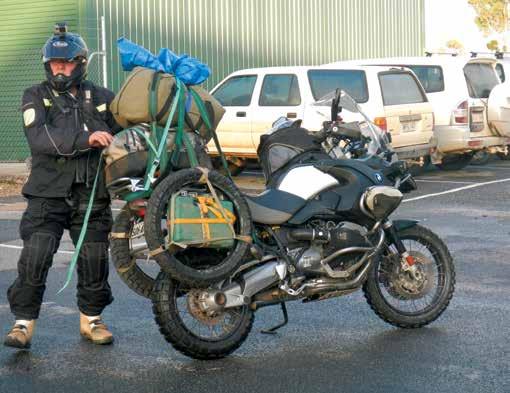
which will also help with cornering confidence shortly.
In general riding, looking ahead allows you to pick smoother, flowing lines to avoid rocks, puddles, mud, sand, bulldust and a swag of other obstacles.
Body position
Bikes have two wheels and tend to fall over when they become unstable. Our job as a rider is to be a gyroscope and maintain the bike’s balance. This means moving around on the bike, front to back, up and down, side to side and weighting the footpegs.
Unfortunately, many riders are more like ‘Lego Man’, grabbing the handlebars very tight and not moving much at all. This can kick in more when the terrain or surface becomes tricky, but that’s the time when you need to be especially loose and agile to keep the bike balanced.
When it comes to braking, cornering, uphills and downhills there are very specific body positions that improve balance and traction. As an experienced rider/instructor I can generally tell by watching a rider for a very short section and know their level of riding simply by their body position and stance on the bike.
Be loose and agile on the bike, not a Lego Man. But at the same time, be strong on the bike, don’t flop around with acceleration or braking forces like a noodle.
Try to understand your bike’s standard suspension settings and adjustability. Rear-shock preload can be increased if extra weight is added to the rear of the bike (usually a pillion or luggage).
Damping can be reduced for riding off road where the suspension needs to be more active to absorb bumps.
Damping can be increased to make the bike feel more stable on the road, especially in corners, if you like carving up the twisties.
It’s quite common for some riders to spend big cash on unnecessary suspension upgrades when they would get a much better outcome if they invested in their riding skills.
Black round things
Control use
Most of you would have heard the terms throttle control, clutch control and brake feel. These skills are what I mean by ‘control use’, and they can take a while to master.
Many adventure bikes have lots of power as well as powerful brakes, so learning how to be precise and smooth with them makes a massive difference to the traction which can be extracted from off-road surfaces. Riding a big bike off road, especially in tighter or technical terrain, can be a real challenge. Learning throttle and clutch control can be a big game changer for riders looking to get confidence off road. Stalling in slower and technical terrain can be an adventure nightmare. ‘You stall, you fall’ is a saying which highlights a common and frustrating situation. At courses it’s amazing to see how riders go from wobblers to looking like playful kids on BMXs after a day or two of clutch/ throttle control drills.
The first three topics are to do with the rider and are by far the most important. The next two relate to the bike and can help, but only if you have the first three points sorted out. They’re not a substitute for riding skills.
Bouncy bits
Suspension can be a black art, and I could fill the magazine with all sorts of information, but I won’t.
Finally, we get to tyres, the topic of 14.5 billion social-media comments. Some comments made by people who started riding off road last week (please make it stop!).
Yes, the right tyre can help you at times. But if you don’t have the first three topics sorted, you might be the guy who bangs on about ‘this tyre’ with ‘this pressure’ being so amazing, but who is also the one who crashes in the corner or doesn’t make it up the hill when the guy with the old bike and worn tyres makes it look oh so easy.
Don’t be that guy!
I do have preferences on tyres for different types of riding, usually on a 1200 or 1250 GS or GSA. But instead of worrying about what tyre I have fitted for
Top left: Rear-shock preload can be increased if extra weight is added to the rear of the bike. Below: Higher pressures help prevent tyre and rim damage.
Top right: In general riding, looking ahead allows you to pick smoother, flowing lines to avoid rocks, puddles, mud, sand, bulldust and a swag of other obstacles.

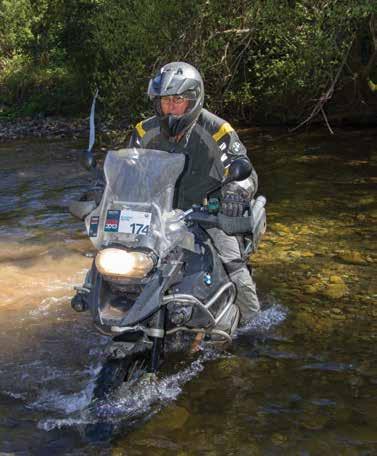
off-road riding I worry more about what tyre I have fitted for the road. That’s because I love carving the twisties between the off-road sections and there are tyres I really don’t trust for road grip.
When it comes to off road, I’m pretty happy with lots of tyres, but focus more on what tyres tend to be more robust and puncture-resistant. Contrary to lots of opinions, I’m also a fan of higher pressures as this helps prevent tyre and rim damage and doesn’t seem to reduce traction levels for me. It also improves tyre life.
Sure, in deep sand pressures come down, but for everything else I’m happy with between 34psi and 38psi front and back.
Shameless plug
For the last five years or so I’ve found the Metzeler Karoo 3 to be the best allrounder for my riding. Good on- and off-road performance, from Tassie twisties to the Simpson Desert, and you can’t get a bigger range than that. They wear well if you’re smooth on the throttle and have great durability. I’ve probably done 50,000km off road in the last three or four years with only a few flats.
Hot tip
Riding in NZ at last year’s GS Trophy we got to ride on some pretty cool beaches. Lots of riders were surprised I could pop up the front wheel in second or third gear on the sand and hold it down the beach. Some of the photos show the point where the wheelie started and there was very minimal roost. That shows if you get these points right you can find traction where others can’t. If you’re looking for improved traction, or more confidence cornering or on uphills, why not sign up for some rider training? don’t think you would regret the decision.

Rider training with Miles Davis
New for 2021! Two-day courses for smaller trail and enduro bikes, as well as regular adventure-bike courses. Improve your off-road riding skills and have a great time. All brands welcome. Suits novice to experienced riders.
2021 course dates
May 14-15 trail/enduro –Bright, Victoria
May 16-17 adventure bike – Bright, Victoria
June 25-26 trail/enduro – Dargle, NSW
June 27-28 adventure bike – Dargle, NSW
August 6-7 trail/enduro –
Toowoomba, Queensland
August 8-9
adventure bike –Toowoomba, Queensland
September 8-9
adventure bike –Green Valley Farm, NSW (Pre NSW Congregation)
Learn about:
vBike set up
vClutch/throttle
vCornering
vUphill/downhill
vObstacles
vWheelies
vBraking
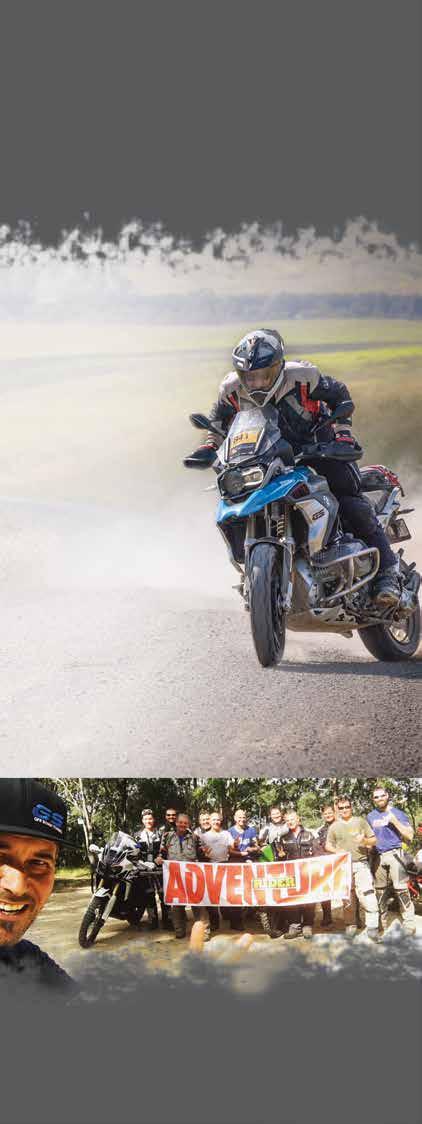
Improve your:
vBike control
vPrecision
vConfidence
vTraction
vBalance
With 20 years experience in off-road rider training
For more info:
www.advridermag.com.au/off-road-training/ Email: advriderskills@gmail.com
Phone: 0448 342 590
In suspense
Karen deals with her sag.
Words: Karen Ramsay

Remember in The Castle when Darryl Kerrigan says, “Oh Steve, could you move the Camira? I need to get the Torana out so I can get to the Commodore…” Well, that’s how it felt here, only with adventure bikes. I realise five-and-ahalf bikes between two of us probably isn’t that

ridiculous in the scheme of things, but when only a couple were getting ridden it was time for a clean out. Dave had no qualms about putting an excess bike up for sale, and as much as I’d been putting off the inevitable, it was time for the Terra to go. My head knew it made sense but my heart wasn’t so sure. I’d had it since new and we’d made lots of happy memories together. Putting it up for sale was hard, but not as hard as trying to remain polite to the tyre kickers who came round and told me what they planned to do to it if they bought it. Friends said I was mad not accepting the cash from the first bloke who was interested. Well, I’m sorry; but if some young P-plater is offering me money while telling me their visions of motarding it up, whacking on some noisy exhaust and roaring around doing blockies, then I’ll happily stick a colander on my head and call myself crazy.
In the end I held out for the right buyer and I just know Jason and the Terra are going to have lots of good adventures together.

390 Adventure love
The result of all this was we’re now left with two Suzuki DR650s and Dave’s BMW F800GS (that’s just clocked up an impressive 200,000km). Having two of the same bike when we go travelling has be a good thing. At least there’s a slight reduction in the tools and spares we need to carry with us.
As for riding, we took a week to head off around the Barraba, Bundarra and Bingara areas in NSW with friends Greg and Ness. As is common, we had no set plans other than to find some great tracks that would take us to some magnificent camps. It truly was a treat to see green and lush paddocks which, not long ago, were bare and brown. I lost count of the number of swollen creeks and causeways and was feeling like a bit of a causeway expert, right up until the last one of the trip. You know the type: mossy and treacherous and just waiting to take a rider out. It’s one way to get a wash I suppose.
Ness was on her new KTM 390 Adventure. She’s not overly tall and was used to managing to get one toe to the ground on her WR450F. She was already delighted with being able to get both feet touching at the same time on the KTM, and as the days went on there was a fair swag of creek crossings, rocky roads and steep hills. Apart from the rims not liking a rather savage pothole at a grid, it became clear the bike and Ness were perfectly suited. She couldn’t fault it with anything she put it through and loved that it felt sure-footed and stable the whole time.
Top left: Feeling like a causeway expert, right up until the last one of the trip.
Bottom left: From left: Dave, Greg, Ness, Joc and Karen after Gap Road near Copeton Dam in NSW.
Above: Lost count of the number of swollen creeks and causeways.
Right: A warning to be heeded.
Below: No set plans other than to find some great tracks and magnificent camps.



kARen RAmSAy


As a consequence, she was a lot more confident to tackle different challenges and couldn’t believe the enjoyment she got from the ride – apart from one insertyour-own-expletive-here cutting a blind corner so much she had no choice but to drop the bike to avoid being hit. Both she and the bike were okay, but it showed, even if you’re vigilant all the time, things can still happen.
Fortunately it didn’t dampen her love of the bike.
Plenty more to see
It was barely a day into our trip and rain was coming, so when we hit Armidale we got in contact with Joc from Armidale Outdoors to see if he had any wet-weather gear for sale. He didn’t unfortunately, but he was happy to loan us some stuff. He was also more than delighted to take a day off to show us around his backyard. What a treat! He led us around more than our fair share of amazing backroads and tracks and had us grinning all day. Although some places were too wet to
ride then, it just meant we’ll have to make another trip out there.
We’re pretty lucky we’ve got so many spectacular places in Australia. We were amazed by some of the locations we rode through and visited on this trip that we’d never even heard of. Apart from the riding, we had torrential rain keep us on our toes and one almighty hail storm as we came into Barraba one afternoon. Greg and Ness had to leave early to get the first service on the new bike and that left Dave and I a couple of days to explore more places we could all come back to some other day.
Weight a minute
After the great bike cull we decided to get the suspension in our bikes done. Well, Dave decided and I went along with it.
In truth my thoughts were: ‘I’ve ridden around on a flat tyre without realising. How could I possibly notice a difference after spending lots of money on suspension?’
Remember that old story of the princess and the pea? The royal family whacked a tiny pea under her ridiculously fluffy mattress and she complained of a rotten
night’s sleep? Well, in bike-riding terms, I’d be the polar opposite.
We arrived right on opening at the immaculate workshop of Full Force in Brisbane and met the owner, Wyatt. The first thing he asked was our respective weights. For goodness sake! There’s been COVID! Dry July was a long time ago! We’ve just had Christmas! My students like cooking! I was not telling this man my actual weight!
happily told him how much each loaded side bag and the top bag weighed. This only partially distracted him, so I told him what sort of rider I was. I chipped in as Dave was telling Wyatt about his riding, reminding him of those memes titled ‘What I think I look like when riding. What I actually look like when riding’. couldn’t get away with it any longer. Suddenly, a wave of inspiration hit me. I’d take 10kg off and just give him my ‘short-term goal weight’. What could possibly go wrong? I wouldn’t notice any difference anyway, so it’s all good. Dave gave me a slightly quizzical look when he heard the made-up number before remembering questioning a woman’s weight is never a good idea.
down a dirt road it was an epiphany. The bike was simultaneously floating and completely grounded. The improvement was immeasurable. I haven’t been able to wipe the grin off my face. I don’t know what sort of magic Wyatt worked, but this fairy tale had a particularly happy ending. So now, before our next trip, I just have to lose that 10kg or leave half my gear at home.
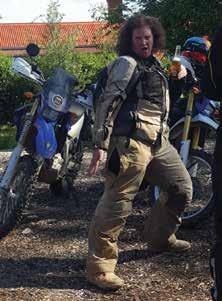
Spring loaded
While Dave and I wandered around various bike shops, Wyatt put plex valves in, upgraded the springs to suit and fitted custom pistons and shim stacks. That afternoon we picked up our apparently now amazing forks and shocks. I paid Wyatt while thinking, ‘He could’ve done nothing to the suspension and I’d never know’.
If we were doing the whole fairy-tale analogy again, perhaps this one would equate to the emperor’s new clothes; I’d have to say it had improved things simply to justify spending a whole lot of money.
It was a few days before we got the forks and shock back in and set the shock sag.
It took quite a lot of online searching to find out how set the sag. What a pity one of us hadn’t looked in the box with the shock and found the ‘how to’ guide at the start of the process rather than at the end. whacked the camping gear into the top bag and set off around the block to see if I could notice anything. I put myself on high alert to deliberately feel for any differences. The first kilometre was bitumen and it felt pretty smooth. When turned
On a sombre note, we farewelled a truly wonderful human and adventure rider known around the tracks as Tara Lee. She had the unique gift of making people feel happy and special. Tara embodied the qualities worth aspiring to: she was passionate, encouraging and inspirational. She is sorely missed by her partner Greg, their families and everyone who ever crossed paths with her along her journey. No doubt she will continue to live on in our hearts and in the countless entertaining, brave and hilarious Tara stories.
R Never underestimate a water crossing
R Be prepared with wet-weather gear every ride
R The secret to weight loss is incentive and sticking to a diet
R I may not be a princess, but I can notice good suspension
R Always check the box for instructions
Above: Finding new tracks. Left: Ness loved the 390.
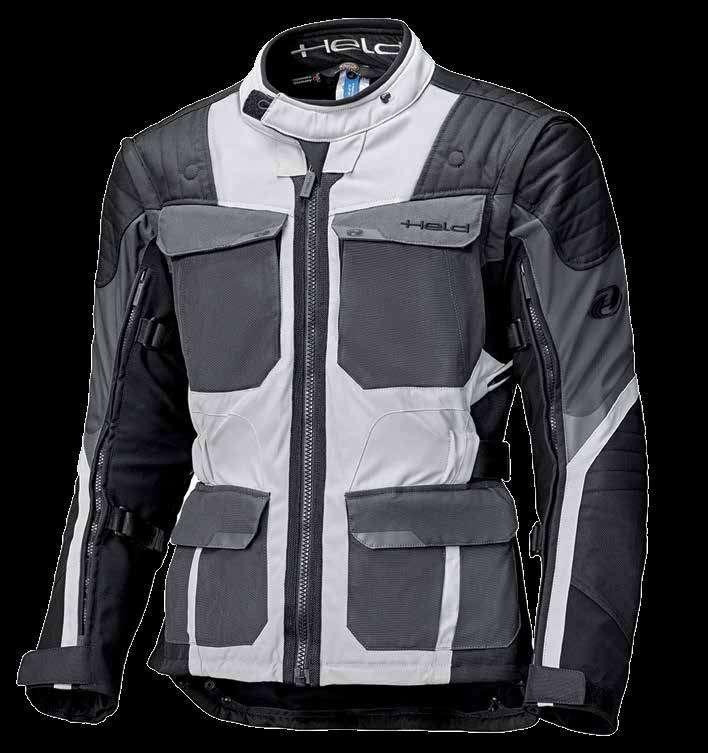
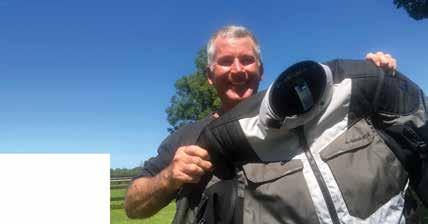



Adventure Rider Magazine highlights some great products and accessories, but there’s a few we get handed and told, “Give it a workout.”
We get to thrash it through the dust, mud, deep water, rocks, desert heat and winter cold until either it or us falls apart or gets pensioned off. There’s no way out for this gear. It gets treated like equipment we don’t own and didn’t have to pay for.
The Held importer has supplied some nice clobber over the years, and both TF and ad-man Mitch have enjoyed Held apparel at different times.
Held Mojave jacket

Now there’s a new Held Mojave jacket on the rack, and it’s a very, very interesting unit. It’s a little off-centre because it’s a summer jacket and we’re coming into winter, but a couple of things about it grabbed our attention and we wanted to let you know about it before summer hits.
We’re not ones for dropping hints, but you could leave the mag laying around open to these pages and start saying things like, “Geez. That Held jacket would look good under a Christmas tree.” Just a thought.
Cool design
You can read the basic specs and features of the Mojave in Checkout issue #44 but things like a waterproof phone pocket, reflective panels, pockets galore and a
system for holding a drink bladder – part number Art:41941 – are all interesting enough, and at this early stage the quality looks as we’ve come to expect from Held. We especially like the big markings so the armour can be removed and replaced in the same position without guesswork. But what got us really excited is the clever design intended to help riders deal with hot conditions, especially the venting. We’ve seen and used some good venting on lots of jackets, but the provision for airflow on the Held is almost spectacular (we’re not sure of the right superlative for jacket airflow, so that’ll have to do).
The obvious vents are the two big flaps on the front which unzip and fit into space between the outer jacket and liner. They look like pockets, but they roll down to expose mesh panels. As we’ve seen on previous Held jackets, all the pocket and
the air gets though. Lots of it.
There were two things which really blew is away.
Ha! Venting that blew us away! We’re so funny.
The first is the sleeves can be unzipped and removed, leaving a mesh inner sleeve with the armour still in place.
That’s awesome! It means a rider can have very close to the feeling of bare arms, but still have the protection of the shoulder and elbow armour. Brilliant. The inner sleeves and armour can be removed too, if that’s your fancy, but the obvious protection of the armour seems to us too good to ignore.
The other thing we liked a lot was a couple of bright-red zippers inside the front of the jacket that allowed the main zip to be left open, but a mesh panel to run collar-to-waistband on the front of
But
wait. There’s more
The arms of the outer jacket have venting zips which run shoulder to cuff and open to mesh vents about 40mm wide. None of the vents open to gaping holes in the jacket. They’re all lined and hold their shape, and the more we looked, the more little zippers, vents and tricky bits we uncovered.
Of course there’s a stack of other excellent features to the Mojave, but being as we seem to spend most of the year dealing with the heat, we couldn’t help but get excited when we copped a good look at the how this jacket is specifically built to keep the rider cool and safe. We’ll be giving it a thorough workout as soon as the temperature starts to rise a little again, and we’ll let you know how it stands up to a real shellacking.
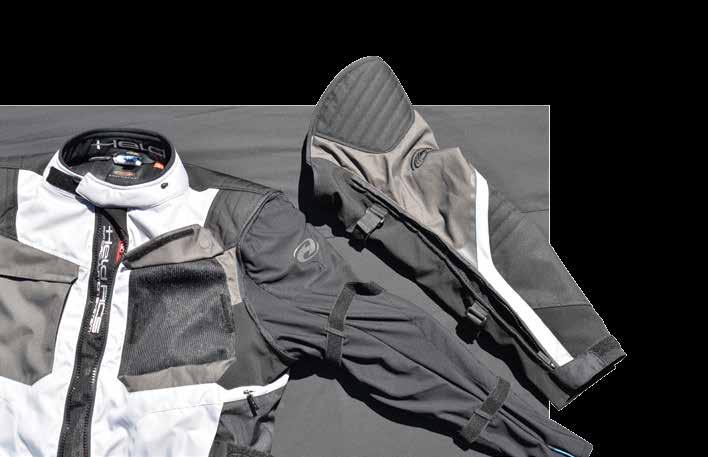
Right now we’re backing it’s going to be one first-rate performer when the
You can get all the specs and tech info by e-mailling info@mig.bike. If you’re really keen, phone the guys on 1300 916 916. Make sure you tell them we said they should put their super-strong coffees down, take a break from watching MotoGP, and tell you what you want to know.
Top right: A waterproof pocket for a phone or powerbank, provision to attach a chest protector and an access point for a drinking tube. Nice.
Left: Sleeves can be unzipped and removed, leaving a mesh inner sleeve with the armour still in place.
Left: Held’s new Mojave jacket has some great features to help cope with the heat. Above: The editor got first dibbs. We bet no one else gets a look in.
Top left: What look like pockets are flaps that tuck away and open big vents.
Top middle: Even the pocket for the optional back protector looks high-tech.
Checkout
Equipment ready for shipment.
ADVWorx soft luggAge New for 2021.
R Made from robust TPU
R Bright-blue internal liner
R Pannier bags in three sizes to suit any size bike
R Simple four-point system allows mounting to any pannier frame
R Comes with straps for use as a pair or a single bag
R Duffel bags are 30L, 40L and 50L sizes
R All bags are fitted with MOLLE webbing
RRP: 30L-per-side saddlebags $595 per pair
20L-per-side saddlebags $495 per pair
30L duffel $145
40L duffel $165
50L duffel $185
Available from: Adventure Moto Web: adventuremoto.com.au

nelson-rigg exhAust heAt shielD
Protects luggage from hot exhaust pipes.
R Lifetime warranty
R Aluminium construction
R Laser-cut Rigg Gear logo
R Includes stainless-steel hose clamp for universal mounting
RRP: From $39.95
Available from: All leading motorcycle dealerships Web: nelsonrigg.com.au

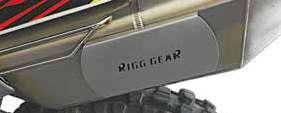
fiVe tfx-2 W/p gloVes
Stretch, water-repellent fabric construction for dryness and comfort and full-grain goat-leather palm for suppleness.
R 5 DRYTECH™ waterproof, breathable membrane
R Soft TPR index and middle-finger knuckle protection
R Index and middle-finger comfort gussets with reflective inserts
R Protective foam reinforcement on all knuckles
R Forearm protection from a cuff with integrated memory foam
R Wide kevlar reinforcement
R Clear Vision Pad™ visor-cleaning system on the left-hand side
R Touch Screen™ system (on the index finger) for handling electronic devices
RRP: $179.95
Available from: Moto National Accessories Web: five.motonational.com.au
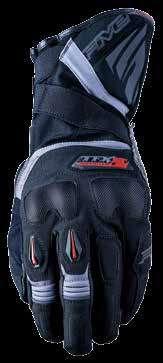
DAinese D-explorer 2 gore-tex jACKet
Two-in-one. The removable Gore-tex 45mm insulated jacket can be used separately.
R Pro-Armor back protector certified to EN 1621.1 Lev.2 included
R Removable composite protectors certified to EN 1621.1 standard on elbows and shoulders
R Air vents on sleeves
R Matching pants available to complete suit
RRP: $1449

Available from: All good retailers Web: mcleodaccessories.com.au/brands/dainese/
Klim ADVenture gtx boots
Klim’s keep-you-dry Gore-tex boot.
R Michelin rubber outsole
R Polycarbonate lasting board
R Reinforced toe/ankle area and shin plate
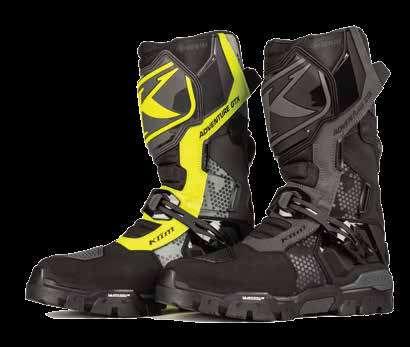
roK strAps strAp it motorbiKe
ADjustAble strAps
Minimise the risk of damage to you, your goods and your paintwork.
R Adjustable and incredibly versatile
R Adjust easily to fit around most luggage items
R Quality materials and good mechanical connections
R Safely hold 45kg in a straight pull or 90kg looped over cargo
R Easy adjuster allows pulling down tight
R Available in lengths from 450mm through to 1500mm, and come in a pack of two
RRP: From $36.96
Available from: shop.touratech.com.au Web: touratech.com.au


A lifetime-warrantied LED light set at a budget-friendly price.
R Made in the USA
R One-piece optic and sealedbeam construction
R Cree seven-watt emitters with two 10-degree and two 25-degree optics
R CANbus-compatible, full relayed wire harness included

Available from: AdventureMoto Web: adventuremoto.com.au CyClops pegAsus le AuxiliAry light Kit
R 6000 plus lumens for the set, 28-watt draw per light
R Can be purchased with or without a switch
R ISO67 waterproof
R 5600K (white)

RRP: $379.95 per pair plus postage (hot intro price)
Available from: Adventure Bike Australia Web: adventurebikeaustralia.com.au
AnDy strApz sAfAri poD
A tank bag made to fit in the small gap available on a longrange tank.
R Doesn’t get in the way
R Stable
R Easily accessed
R Raincover tucks up under the bag
R Harness strap runs under the seat
R Made in Australia by Andy Strapz
RRP: $255 plus freight
Available from: Andy Strapz
Phone: (03) 9786 3445
Email: info@andystrapz.com Web: andystrapz.com
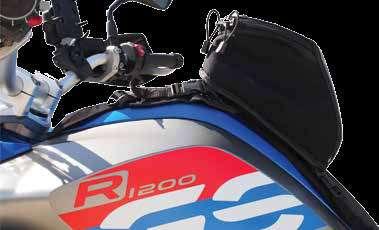
DenAli D7 2.0 leD light poDs
One of the brightest LED lights under 11.4cm.
R 14 x 10-watt cree XPL HI
R 10-amp power draw with 458m beam distance
R 61m beam width
R 15,330 raw lumens
R Single-intensity harness
R DataDim compatible
R Pod Size: 11.1cm around and 9.9cm deep
R IP67 waterproof and submersible
RRP: $1119 per pair. $559 single pod

Available from: Denali electronic dealers Australia-wide Web: whitesmoto.com.au/pages/denali-electronics
gAerne g.DAKAr boots
Combination enduro and touring boot.
R Hard-wearing, full-grain, oil-treated leather
R Waterproof and breathable Gore-tex membrane
R Innovative ankle pivot system for protection
R Thermoplastic shin-plate protection
R Padded top edge, wide opening and memory padding inside
R Antibacterial lining
R Double-stitched lug sole
R Made in Italy
RRP: $599.95
Available from: All good motorcycle retailers Web: cassons.com.au
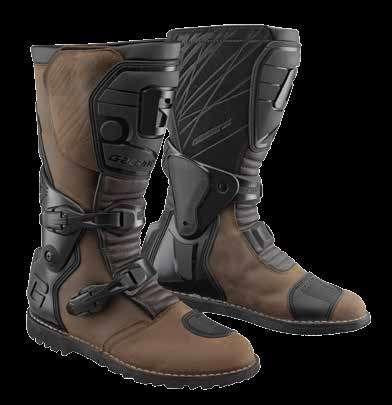
motopressor smArt pump Combo pACK
Everything needed to repair a puncture, pump a tyre and more.
R MotoPressor smart pump (includes a torch and a USB charging port)
R Motopressor puncture-repair tool
R Clip-on valve extension with deflation button
R Whole kit fits in a storage case measuring 160mm x 140mm x 60mm
R Weighs 1200gm
R Enter ‘ADVRIDER01’ at checkout and receive 10 per cent off the price for a limited time
RRP: $229.35 plus postage and handling

Available from: Rocky Creek Designs Web: rockycreekdesigns.com.au
mosKo moto reCKless 40 (V3.0) pAnnier/Duffle
A rackless pannier/duffle system that easily mounts on pretty much any motorcycle.
bumot xtremADA pAnniers AnD rACK
Luggage set includes:
R Two soft panniers: 1100-denier Cordura by Dupont sewn over vinyl-coated polyester
R Pannier rack to suit BMW, Suzuki, Yamaha, KTM, Husky, Moto Guzzi, Honda, Ducati or Triumph
R Constructed from galvanised mild steel then powdercoated black
R All mounts four-millimetre aluminium plate
R Stainless-steel, lockable, quick-release mechanism
R 35 litre and 31 litre (notched for exhaust) plus external storage of four litres each pannier.
R Each pannier also has two two-litre pockets designed for carrying fuel or water
R Two dry bags (one per pannier)
rst ADVenturePants are also available.
R Maxtex main outer material with Ballistic in crash zones
R Entire garment CE certified to level AA
R Level-2 elbow, shoulder and back protector
R Ventilation on chest, arm, shoulders and rear
R Multiple internal and external pockets
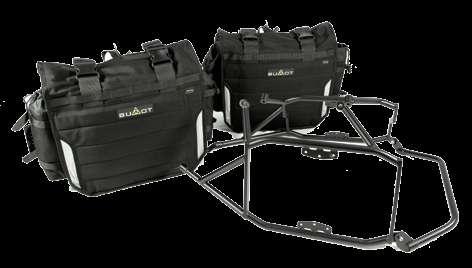
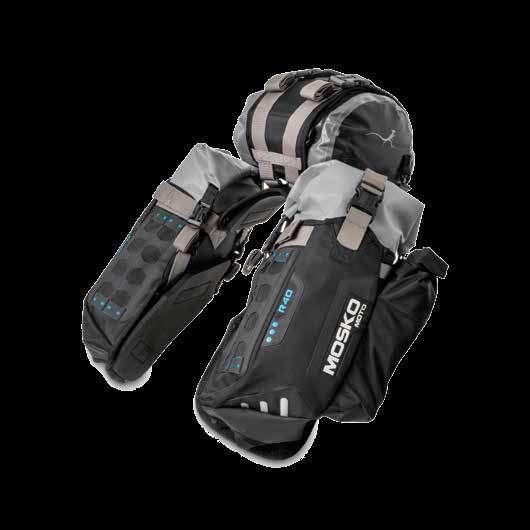
Phone: 0428 536 519
Web: adventurebikeshop.com.au
AWAsAKi Klr650 2008-2021 rADiAtor guArD
An essential aftermarket part. For the hardcore adventure rider Easy to fit Video fitting instructions available Lightweight and doesn’t restrict air flow Made from 6060 T1–T5 aluminium
Available in black or polished alloy Three-year worldwide warranty Australian made
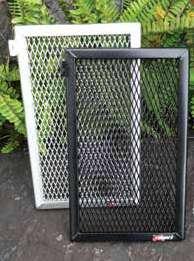
RRP: $170. On special for $139 Available from: Rad Guard Phone: (02) 6658 0060 radguard.com.au
R Coates bonded nylon thread used throughout

R Removable Sinaqua Pro WP Lining, 15,000mm/cm² WP and 11,500g/m²/24h breathable
R Available in silver, black, and blue/sand
RRP: $599.99
Available from: Leading motorcycle stores Web: monzaimports.com.au
AgV Ax9 glossy CArbon helmet
The AX9 is now available in the new Glossy Carbon colour.
R Carbon-Aramidic-fibreglass shell in three sizes with four-density EPS structure in four sizes
R Integrated Ventilation System. All vents are adjustable
R Chin guard air vent removable without tools. Removable nose guard. Max ventilation grid installed under the air vent
R Shalimar and Nabuk neck roll with waterresistant treatment
R Removable wind protector
R All interior parts are easily removable and washable
R Ritmo fabric cheek pads with antibacterial protection, moisture wicking and skin-comfort treatments
R Shalimar crown pad with the same treatments listed for cheek pads
RRP: From $799
Available from: All good motorcycle retail outlets Web: agvhelmets.com.au
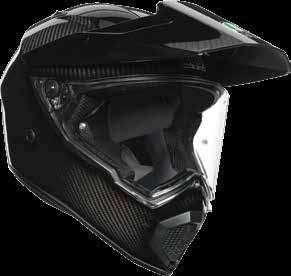
tourAteCh WinDsCreens
Unites an appealing adventure design with optimum function.
R Specially developed for your bike
R Aerodynamically optimised form
R Flutter-free, even at high speed
R Minimised air turbulences
R Non-exhausting riding
R Cool adventure design
R Available in different heights and shades
RRP: From $250
Available from: shop.touratech.com.au Web: touratech.com.au
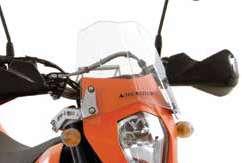

fAstWAy pro moto billet
ADVenture footpegs
Now available for the Ténéré 700.
R Patented, adjustable height, traction, and camber
R Universal Collar System (UCS) allows stock or lowered positions on most bikes
R All billet ’pegs are precision-engineered, manufactured, and assembled in the USA
R All footpegs ship with two sets of F3 threaded cleats: short 10mm, and tall 12mm
R Measurements: 57.1mm x 120.6mm
R Specific fitment kit now available for the Ténéré 700
RRP: From $399
msC moto rAlle-moto rm3
steering DAmper
Stop headshake, wheel deflection and speed wobble.
R No need to change top triple clamp
R Fits under handlebars using OEM ’bar clamps
R 20-position adjuster
R Speed-sensitive return to centre damping
R Complete with stainless-steel linkages and hardware

Available from: MSC Moto Web: mscmoto.com Phone: (02) 4374 1655. Call for prices and availability
bmW Venturegrip gtx boots
A waterproof leather enduro boot suitable for everyday use.
R Comfortable, robust and suitable for long trips
R High wear resistance
R Toggle-type buckles, colour accent on the sole, high shaft and oiled leather
R 100-per-cent full-grain cowhide, oiled
R Permanently windproof and waterproof and highly breathable Gore-tex membrane
R Thermally formed and stiffened shin guard
R Available in black or brown
R Sizes 36 to 48
RRP: $520
giAnt loop mojAVi sADDlebAg
A rackless, rugged saddlebag designed to transport the essentials on aggressive, off-road rides.
R 12-litre volume (two six-litre side pockets)
R 1.4kg dry weight with all included components
R Bomb Shell™ construction and materials
R Water-resistant YKK zippers and military-spec fasteners
R Aluminium cam-buckle compression straps
R Custom-woven ballistic webbing on lower attachments
R Two side pockets, 10cm deep x 41cm long x 18cm wide
RRP: $419.90
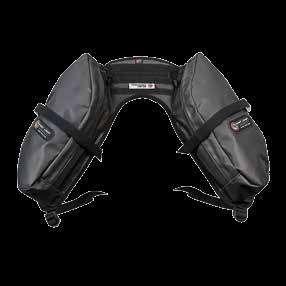
Available from: Giant Loop luggage dealers Australia-wide Web: whitesmoto.com.au/collections/giant-loop
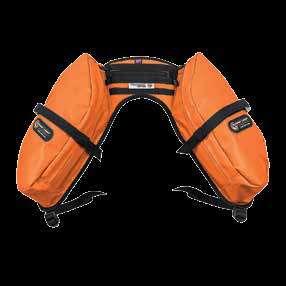
Another high-quality jacket from Held.
R Removable waterproof, windproof and breathable liner
siDi ADVenture 2 gore boots
Waterproof and breathable, purpose-built adventure boots.
R Black – full-grain microfibre. Brown and grey – suede
R Gore-tex membrane
R Micro-adjustable and replaceable buckle system
R Full-length inner gaiter
R Plastic ankle support with flex system
R Rigid, shock-resistant, anatomically shaped heel cup
R Nonslip rubber sole
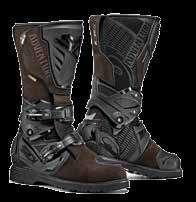

R Sizes: S – 3XL. Grey-black 68: 4XL, 5XL, 6XL
R Colours: black-grey 03, grey-orange 67, grey-black 68, grey-blue 69. Khaki 55

RRP: $649.95 Available from: Your local motorcycle dealer
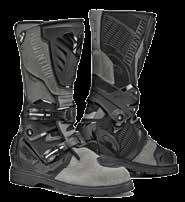
Available from: Motorcycle Adventure Products Web: motorcycleadventure.com.au esD e30 ADVenture helmet
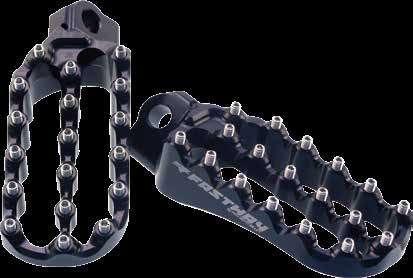
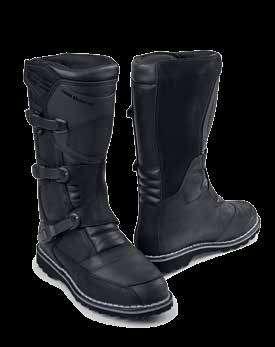
Available from: Your local BMW Motorrad dealer

R EN 1621-1 CE-approved SAS-TEC® 3D shoulder and elbow protectors
R Velcro for optional two-piece chest protector
R Soft collar
R Held Clip-in technology
R Dual arm adjustment
RRP: $650
Web: mig.bike
Email: ray@mig.bike
Made for every riding occasion with the adventurer in mind.
R Integrated sun visor
R Four inlet vents and two large outlet vents
R Fully interchangeable and washable sweat-wicking liner
R ABS shell and EPS high-impact liner Dark tint visors available as an extra Helmet bag Sizes XS – XXL Colours: matte black, gloss white or fluoro (yellow)

Phone: 1300 916 916
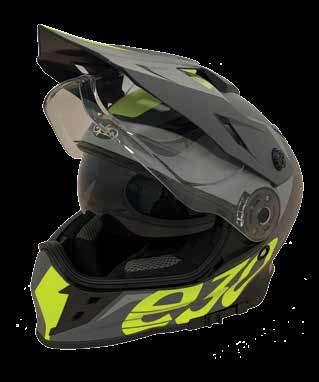
RRP: Black/white $198. Fluoro $219 Available from: All good motorcycle dealers
Motorrad Garage
